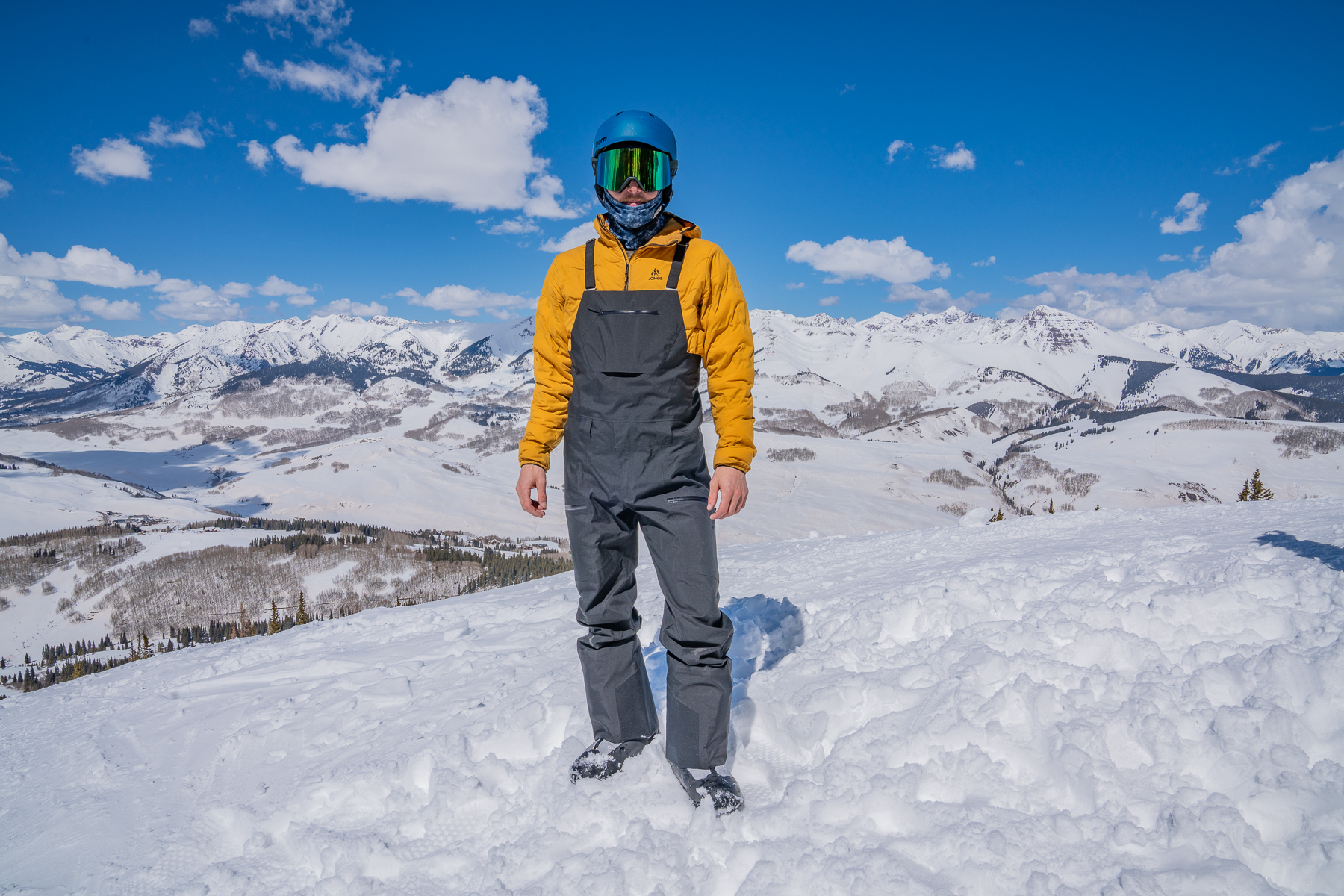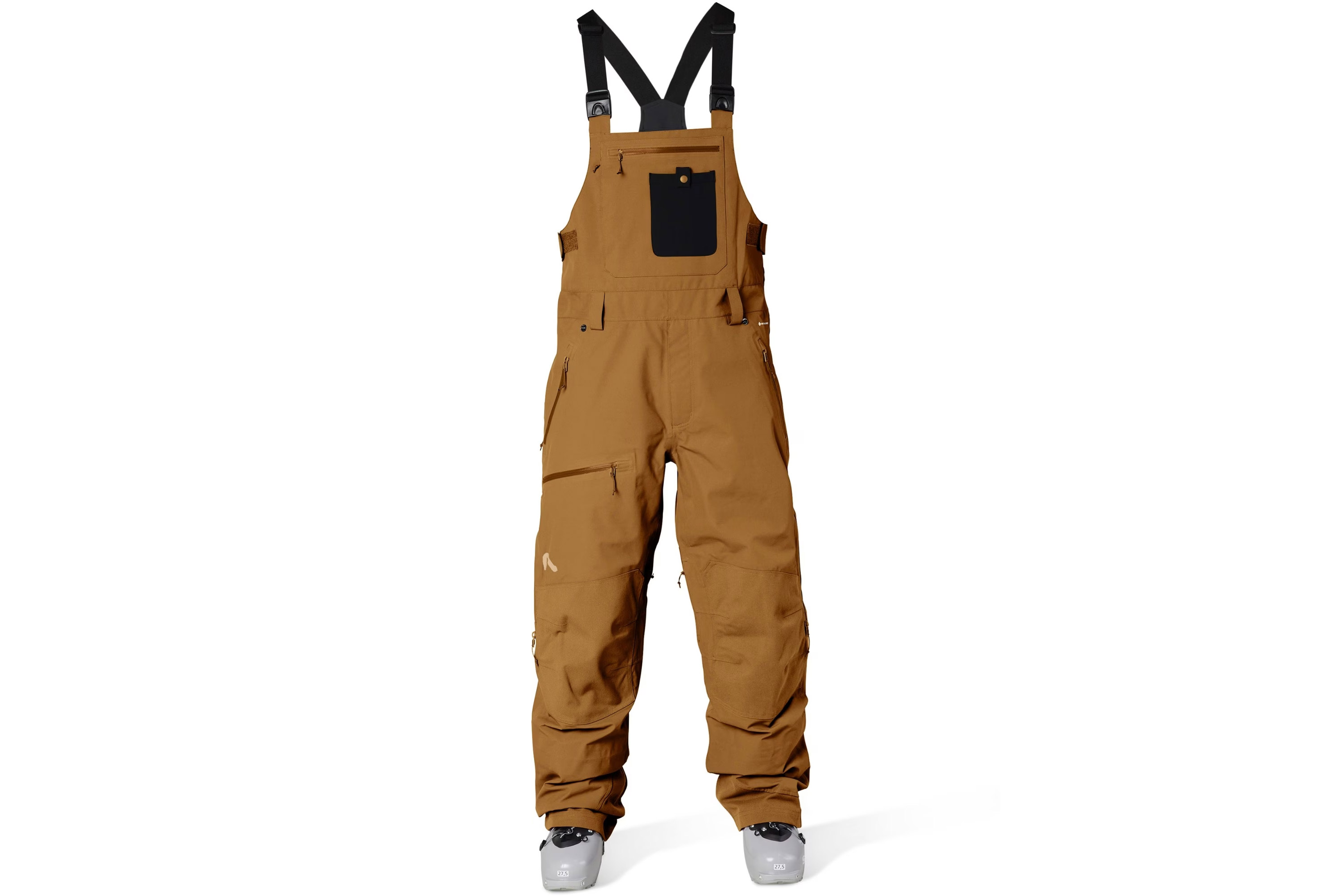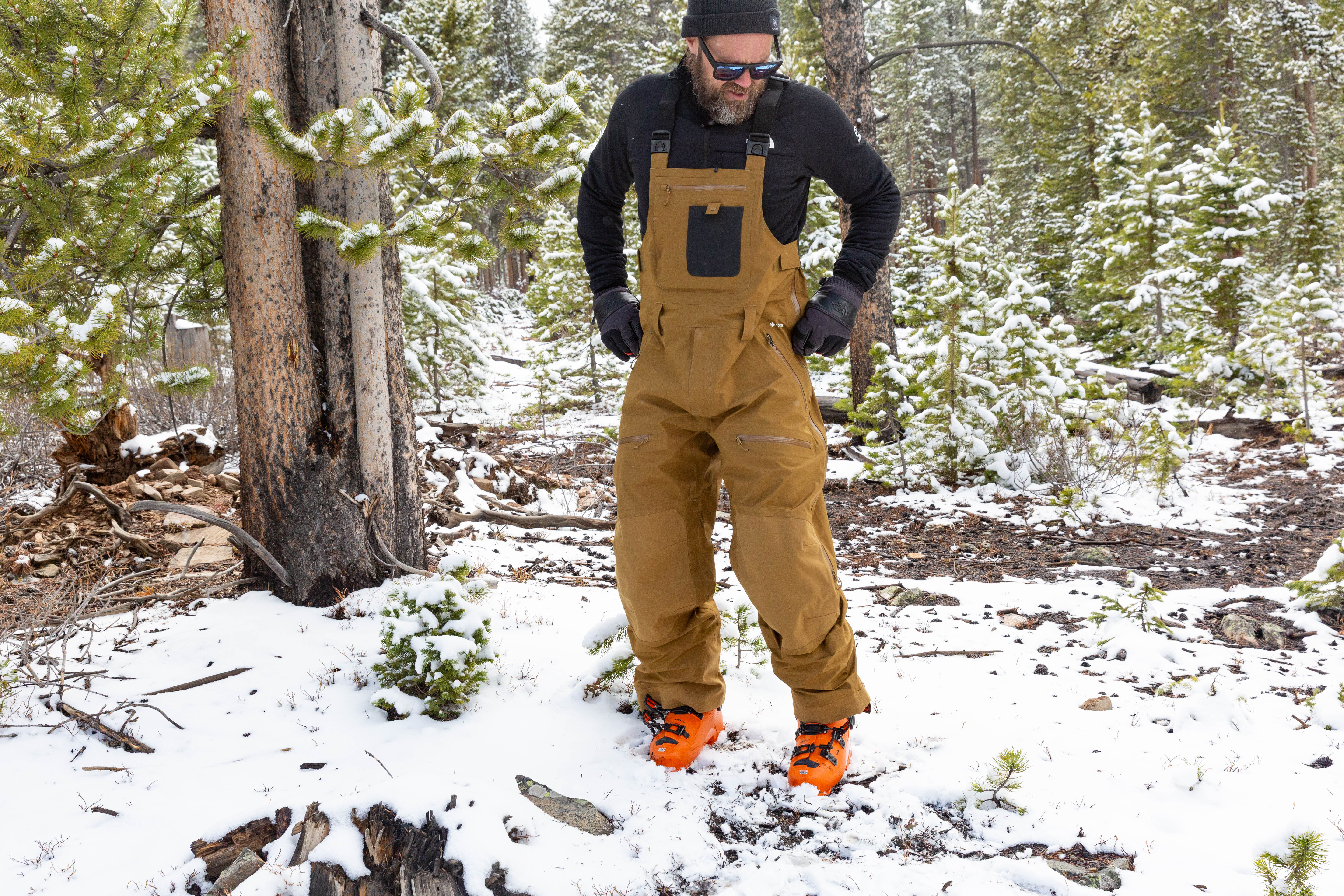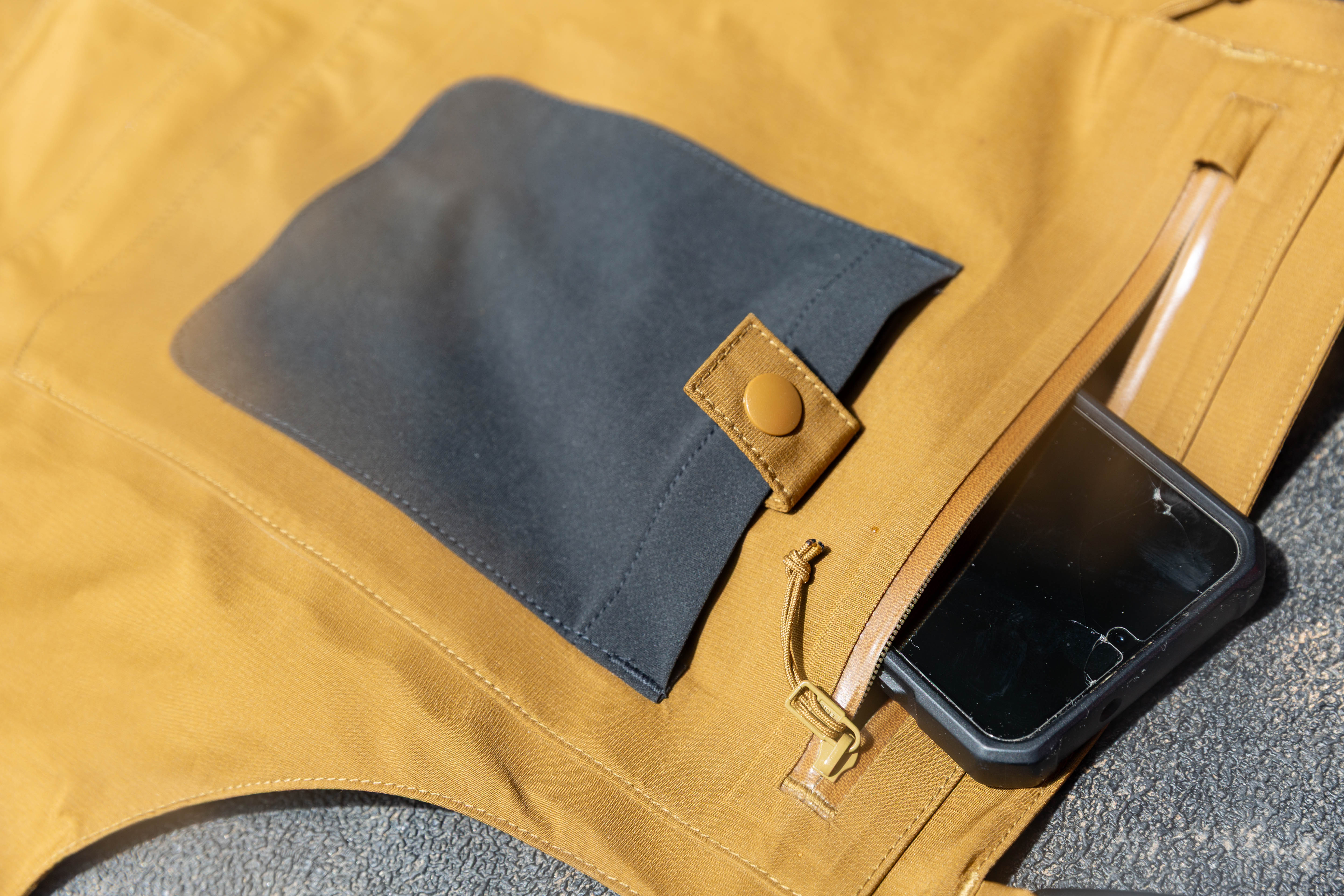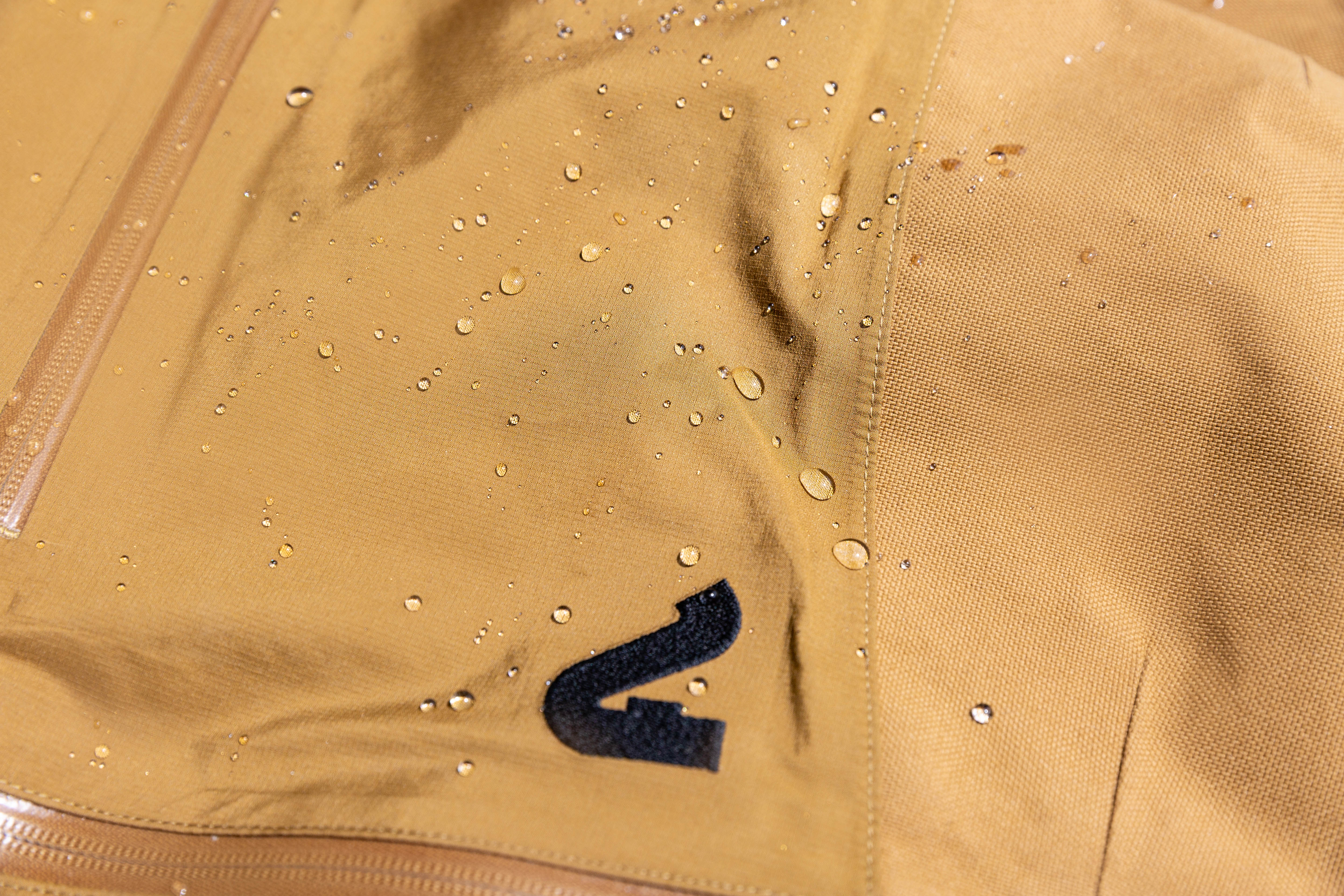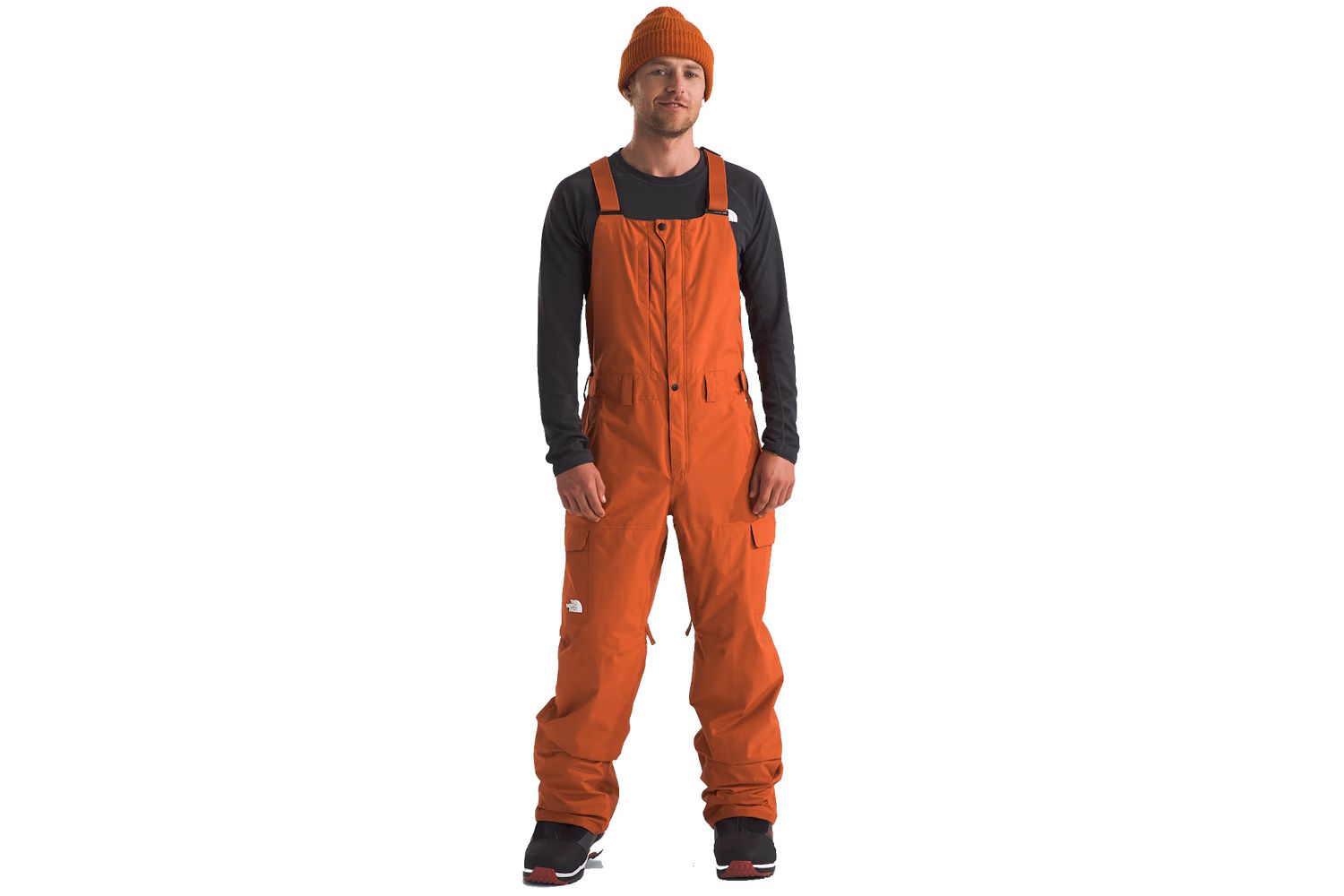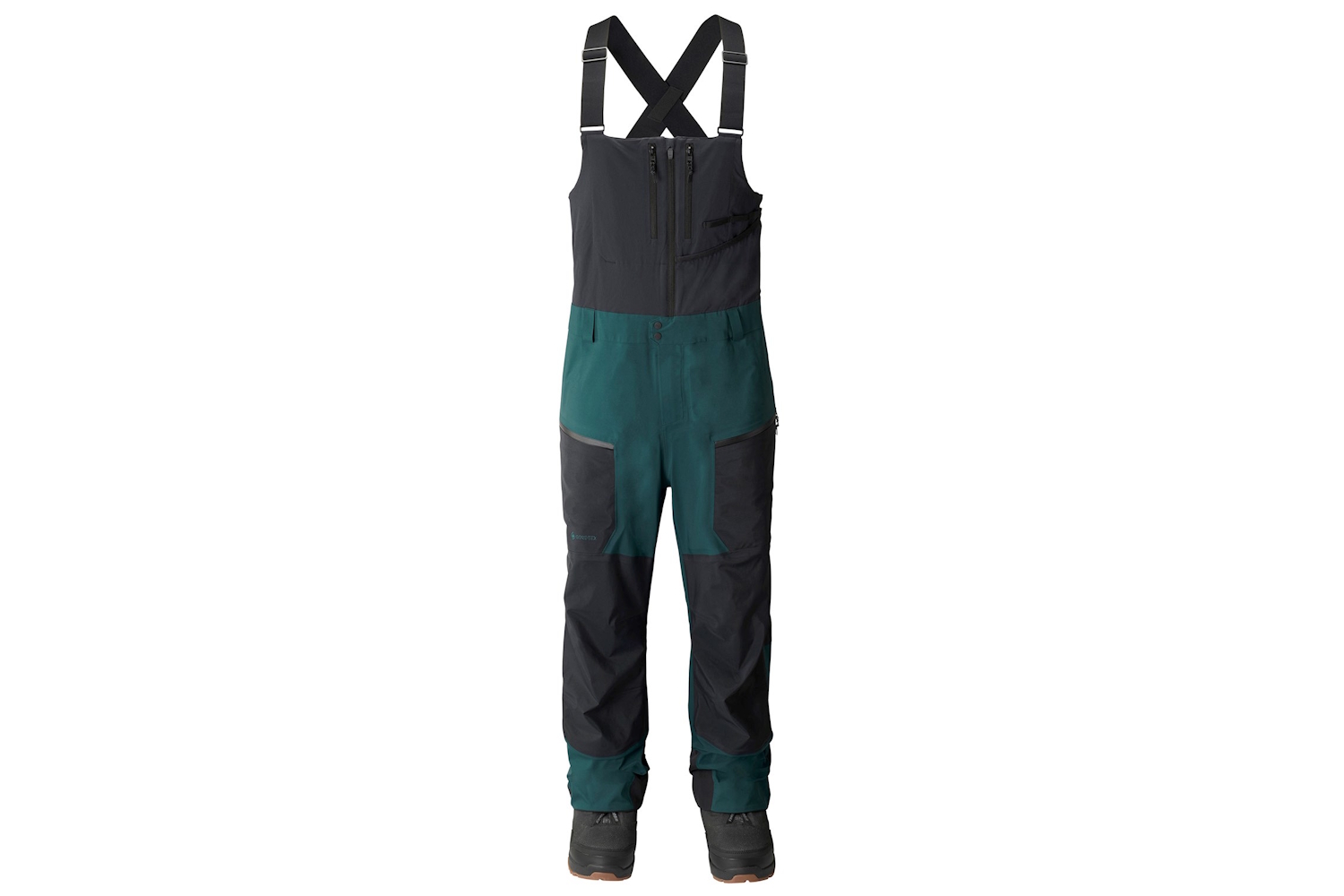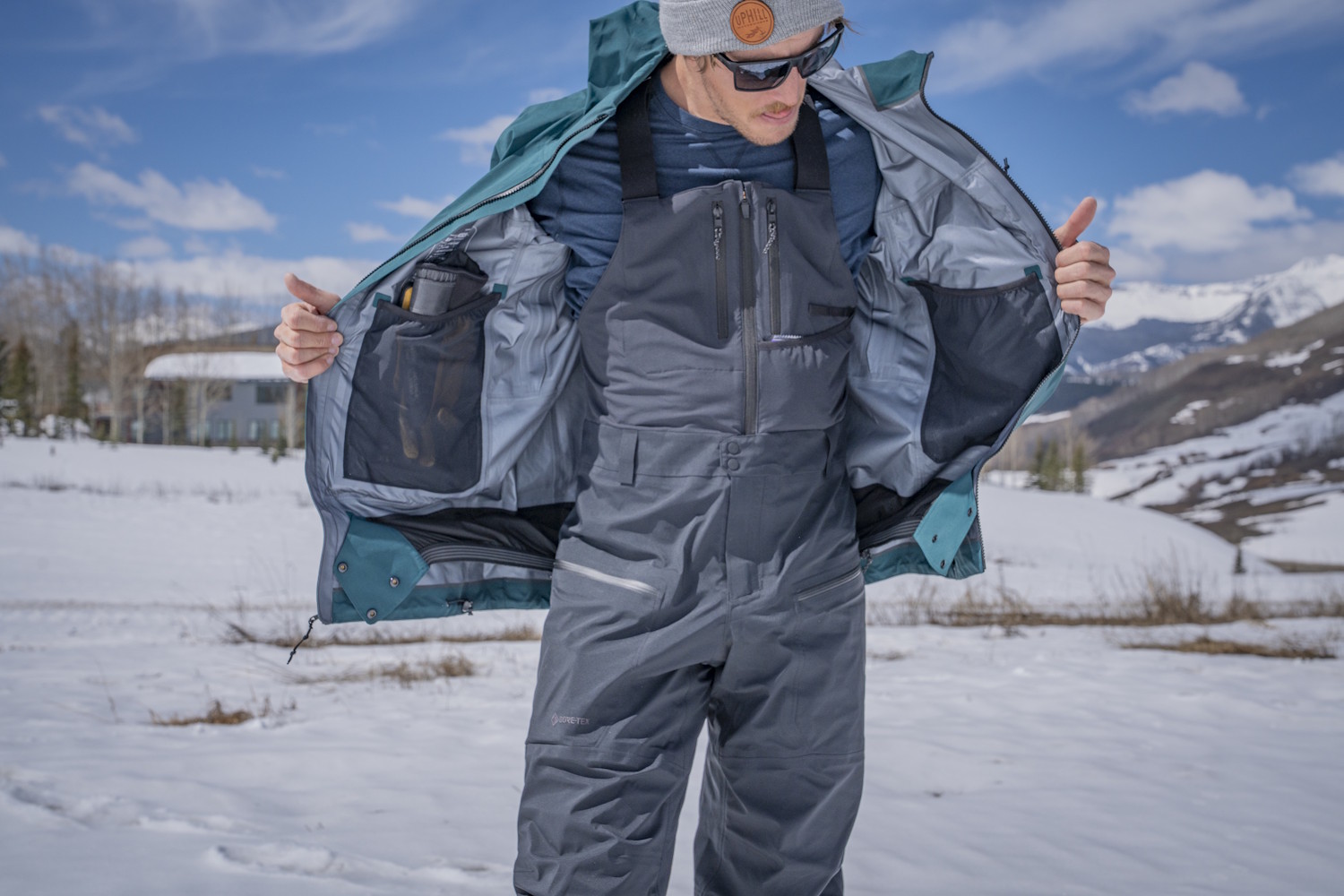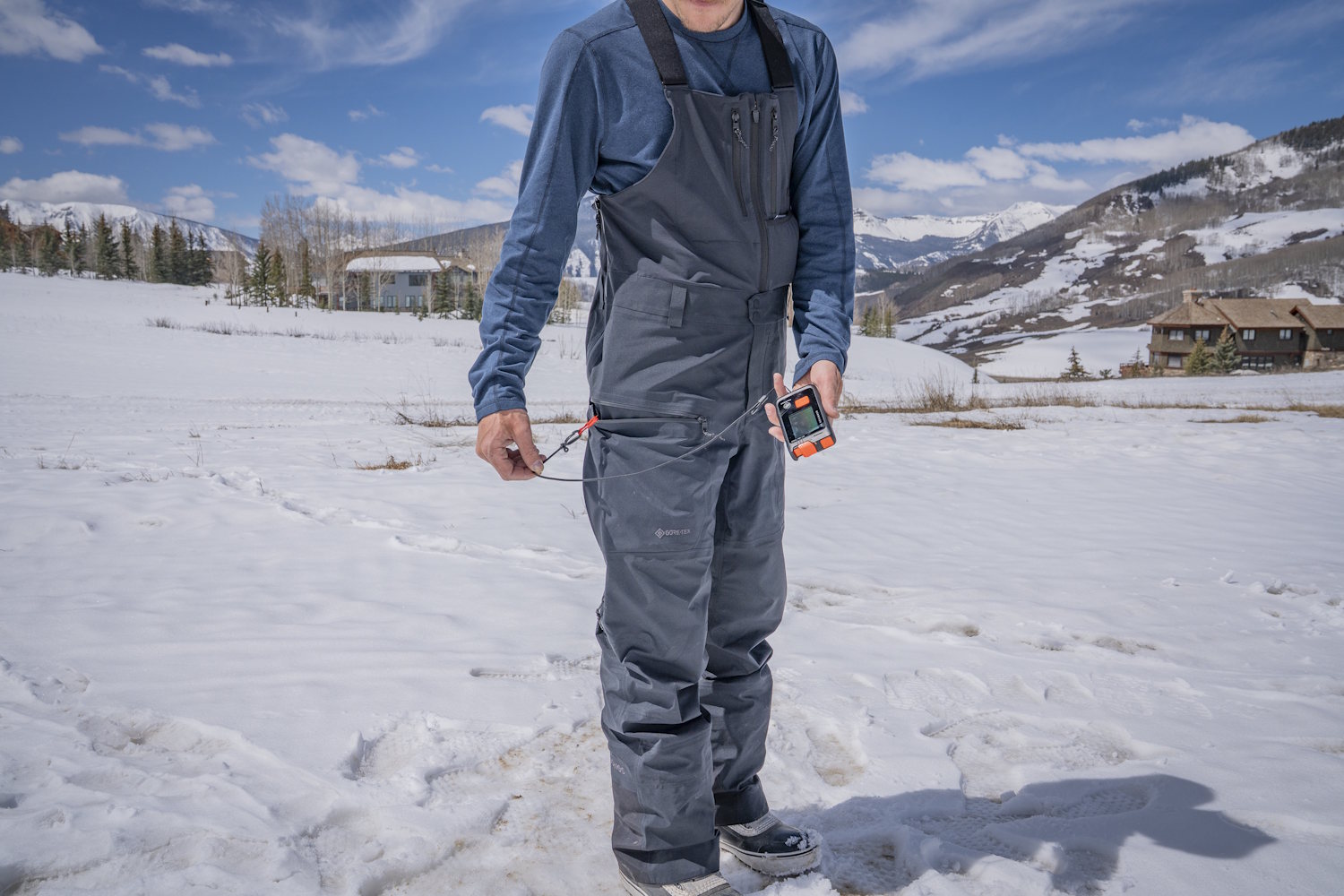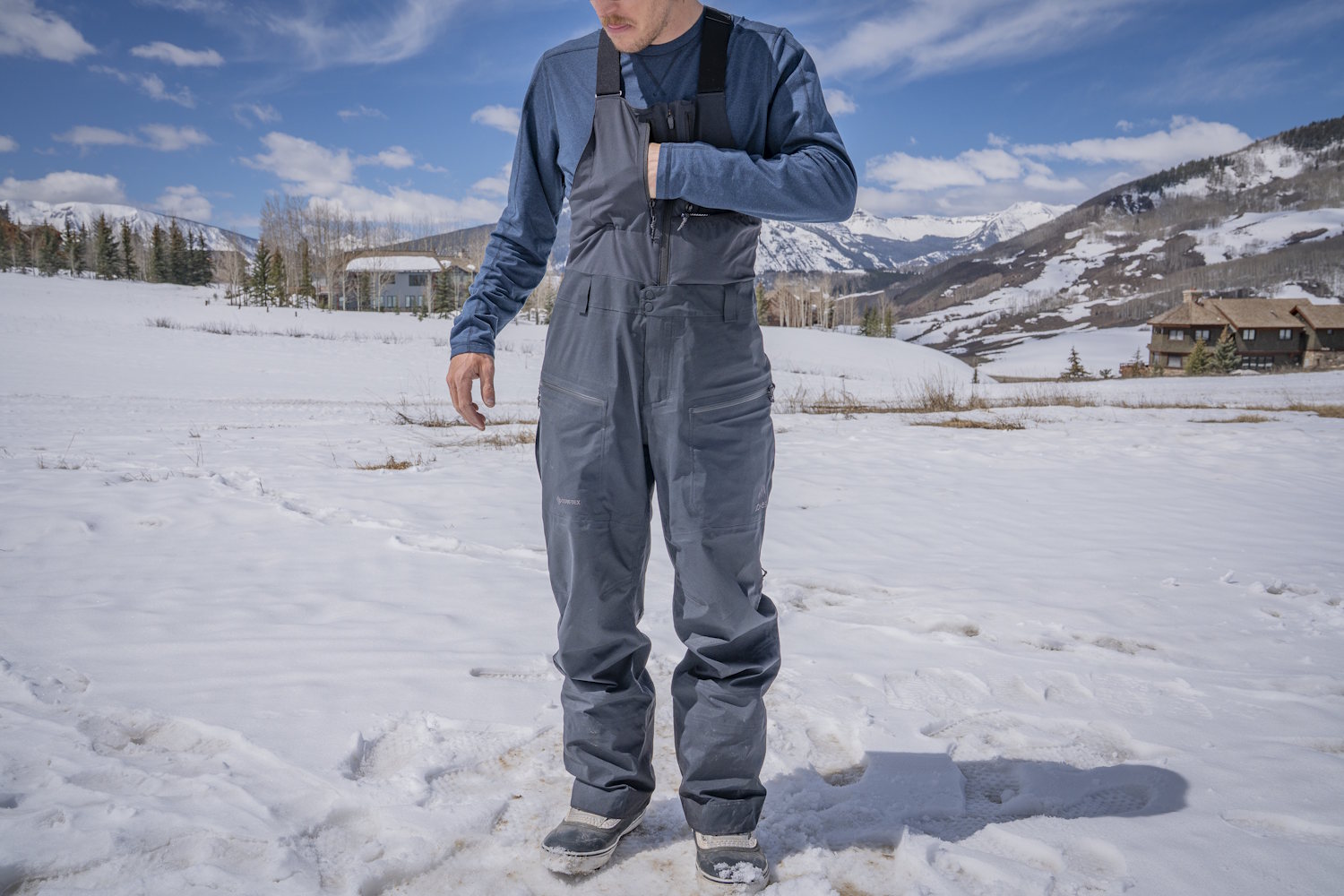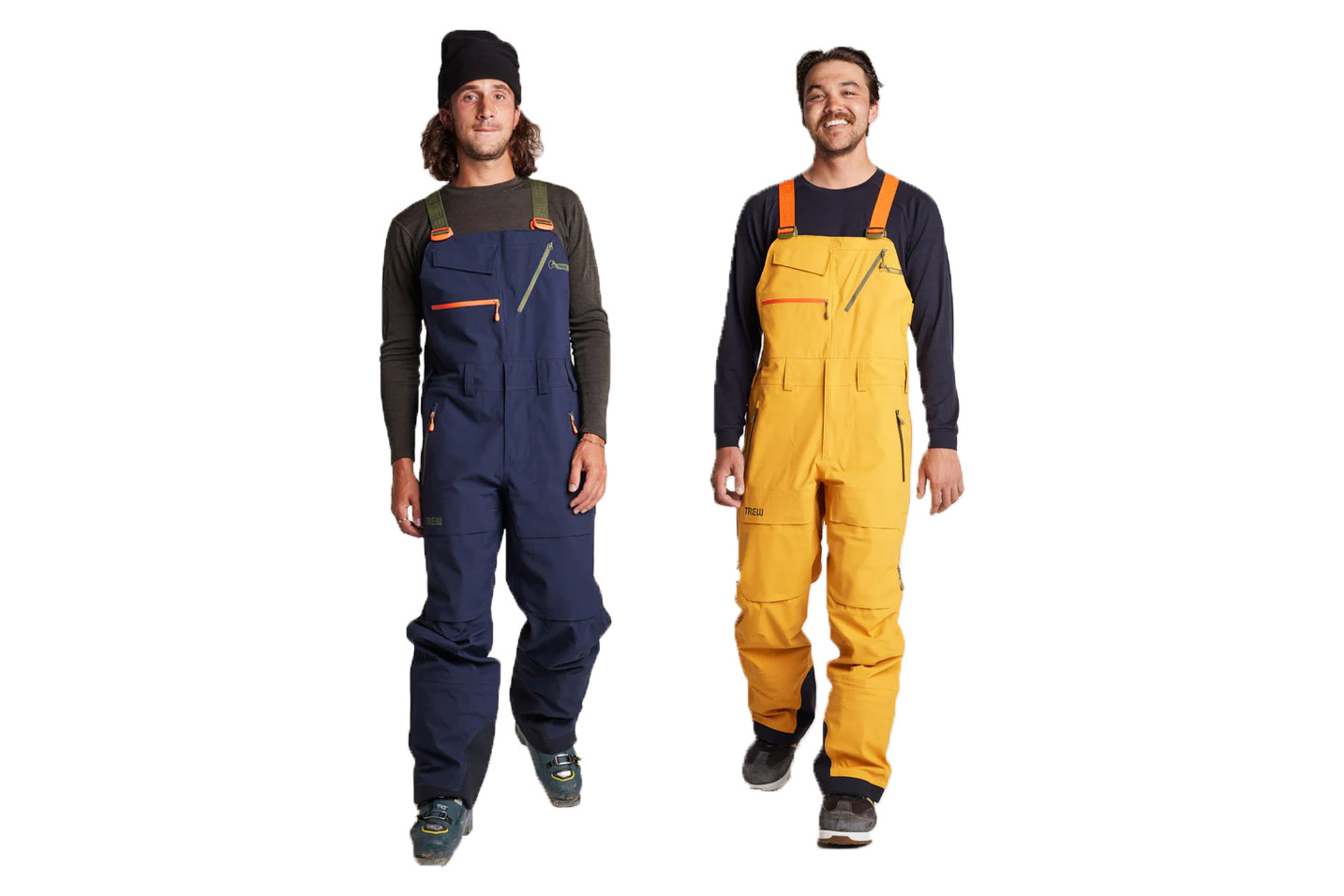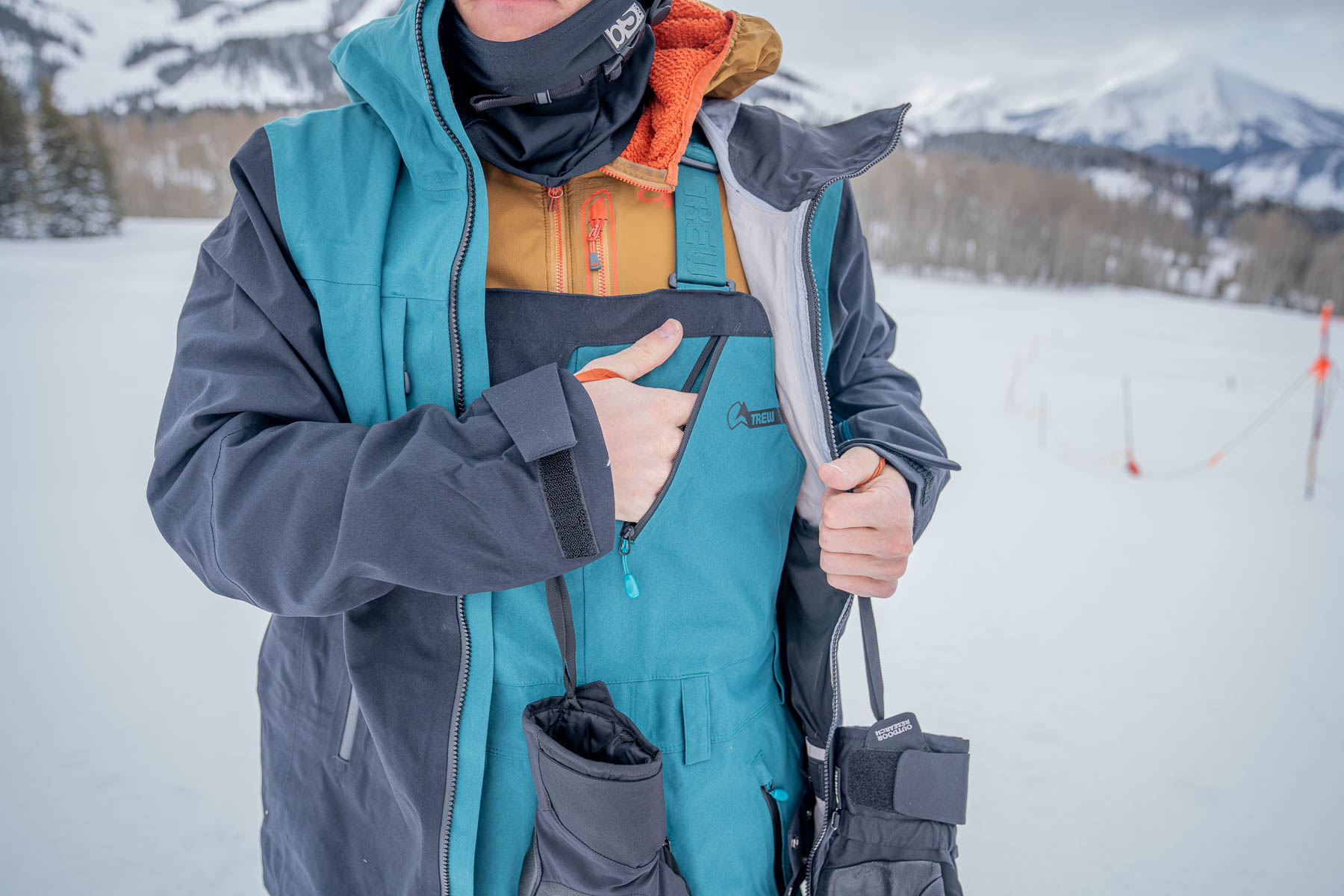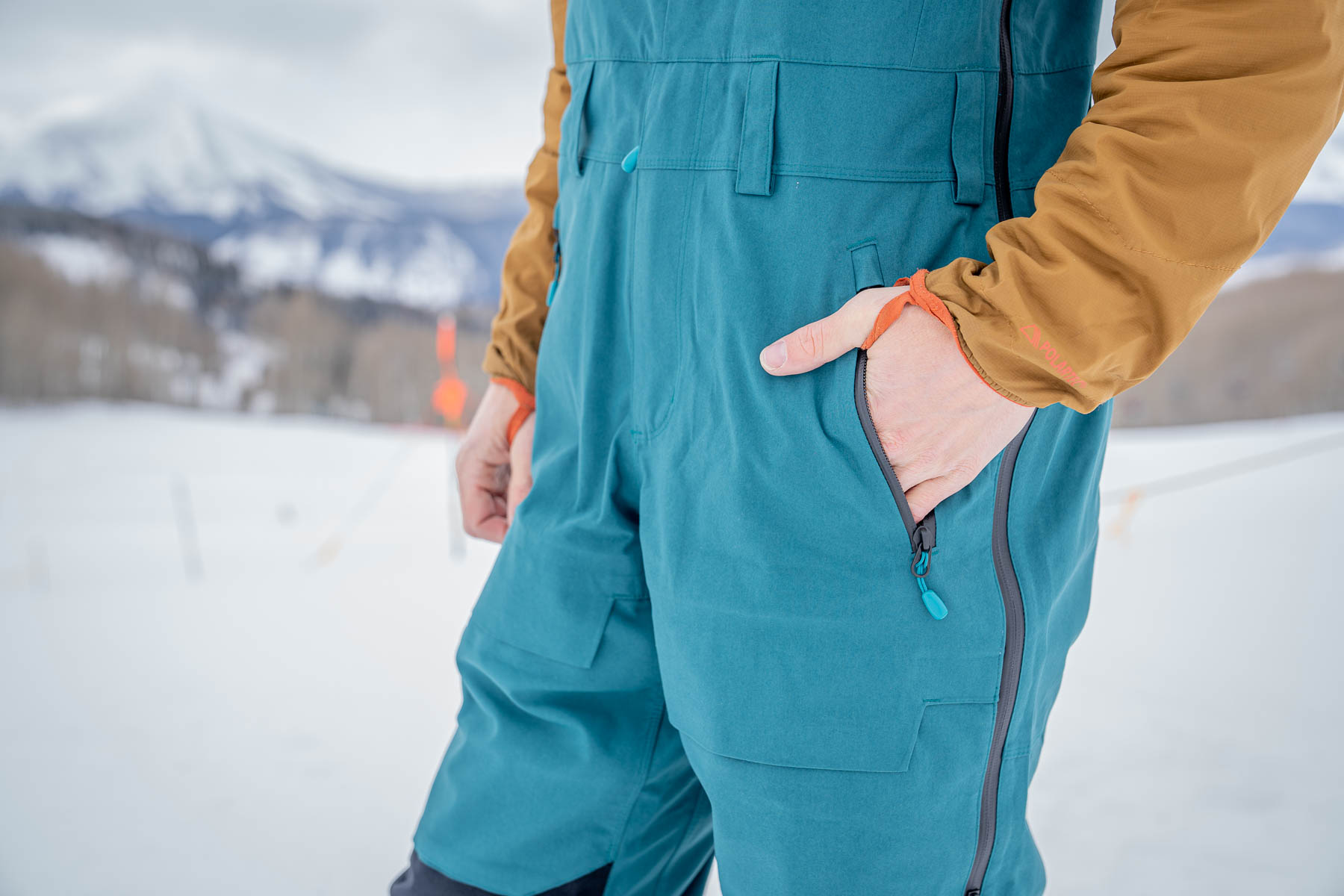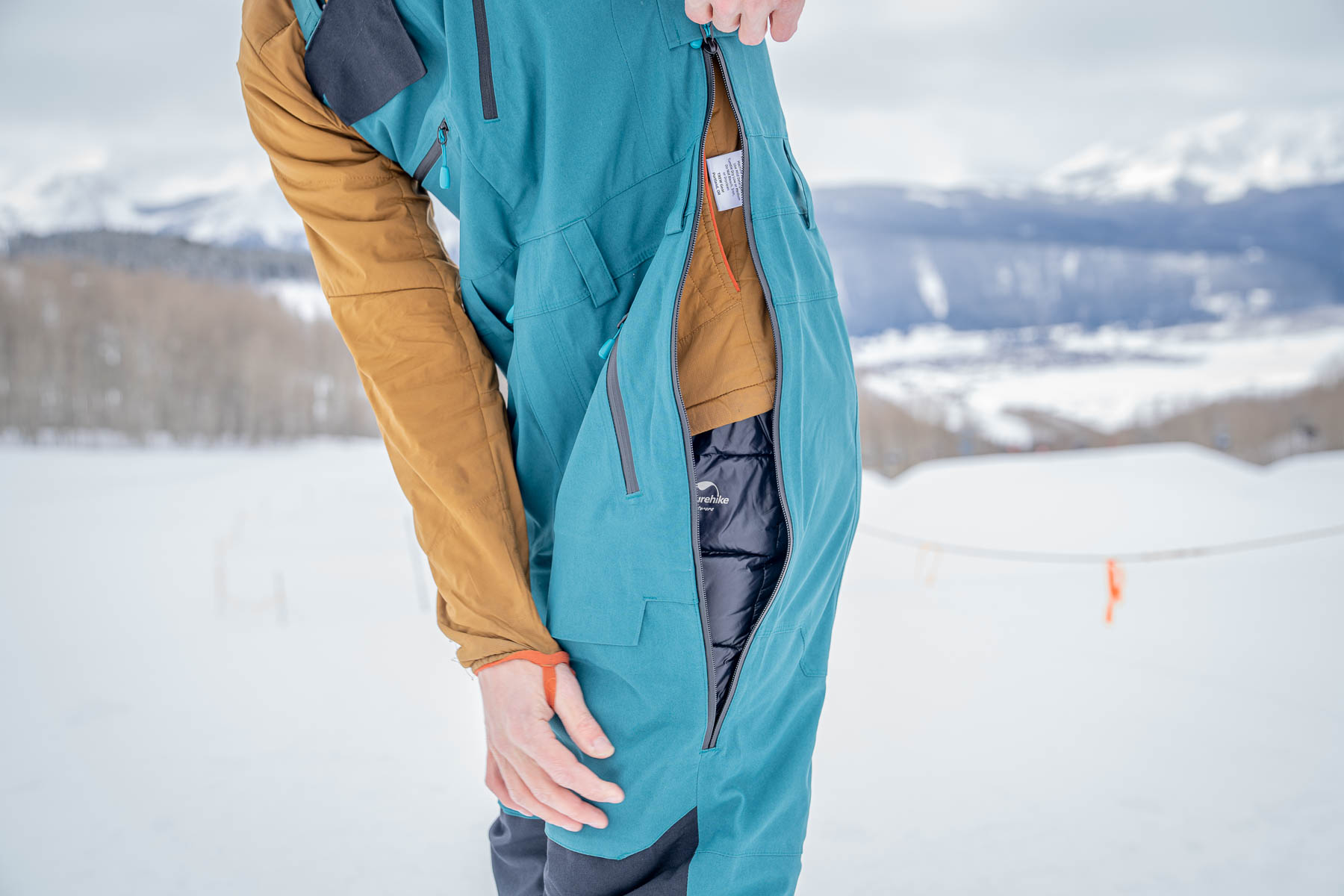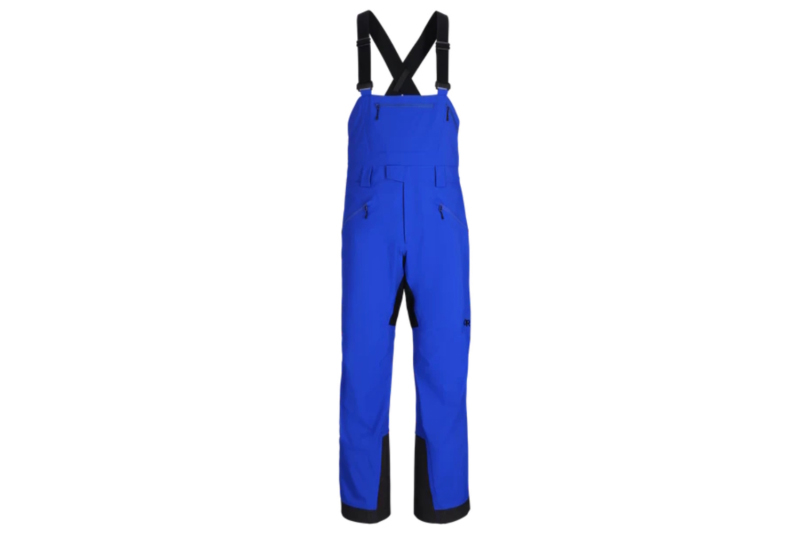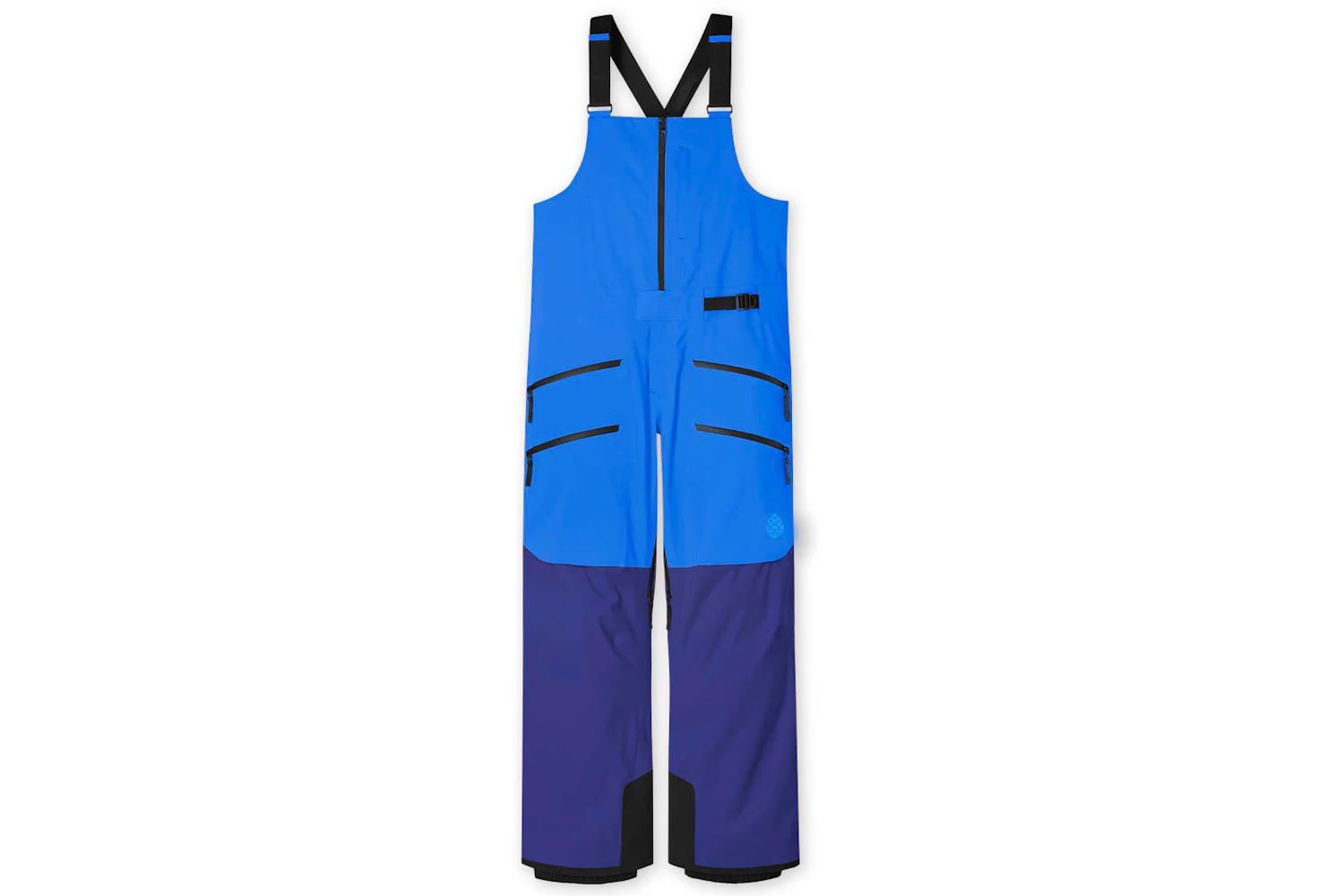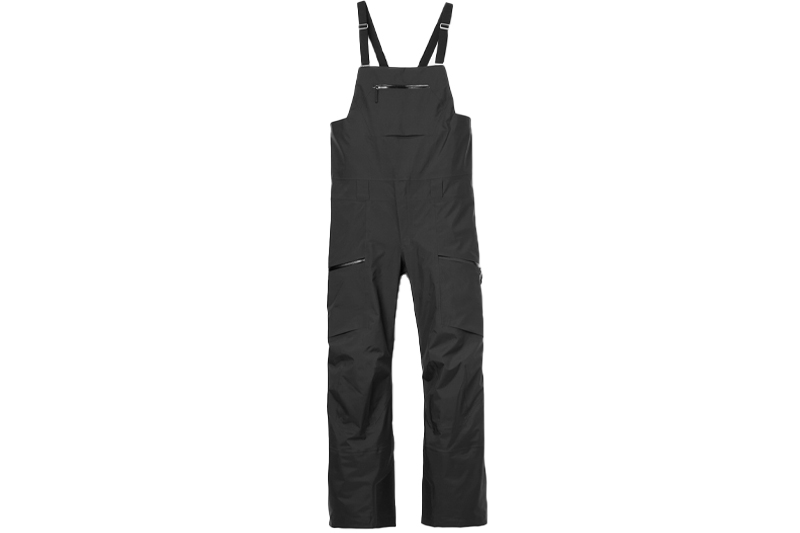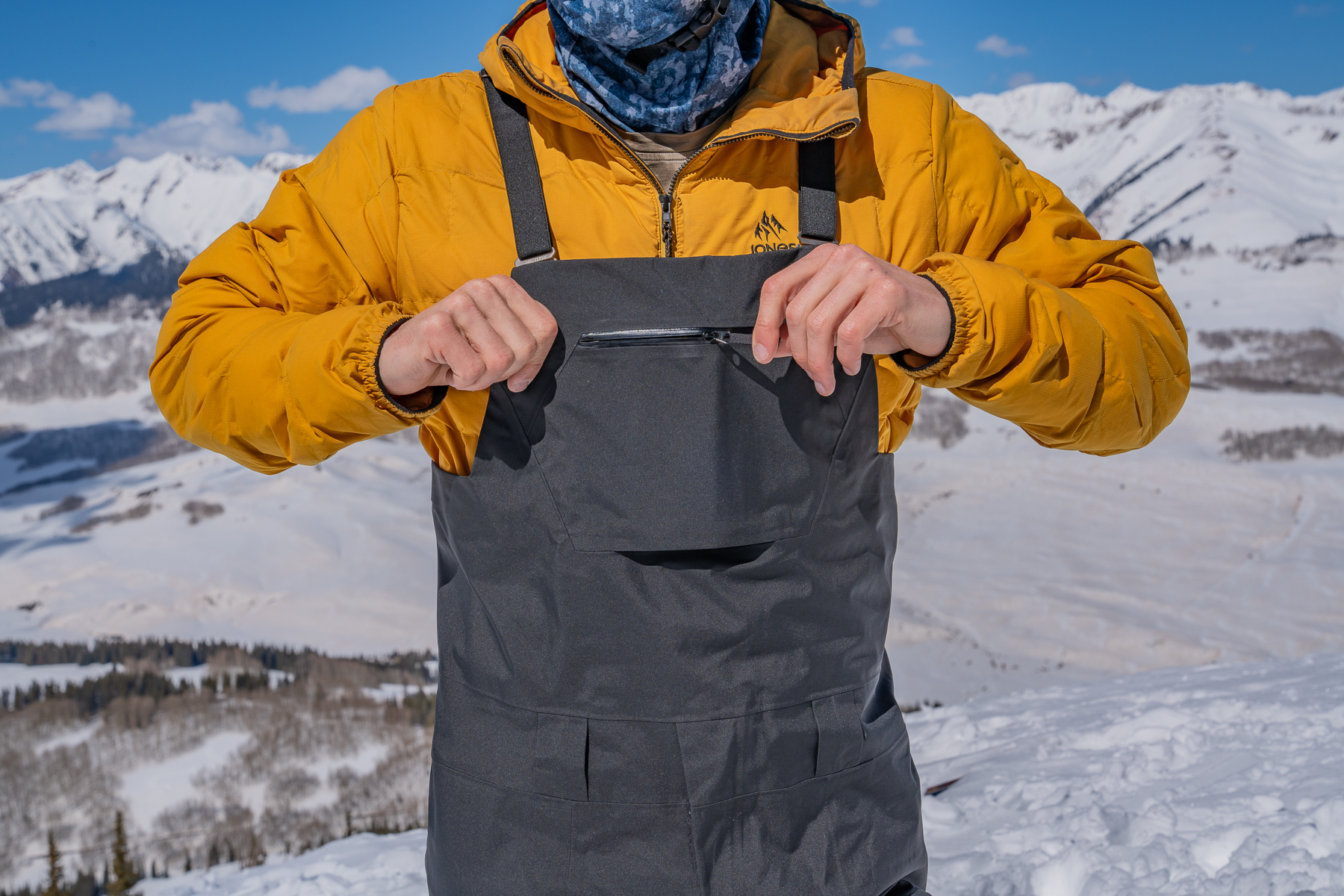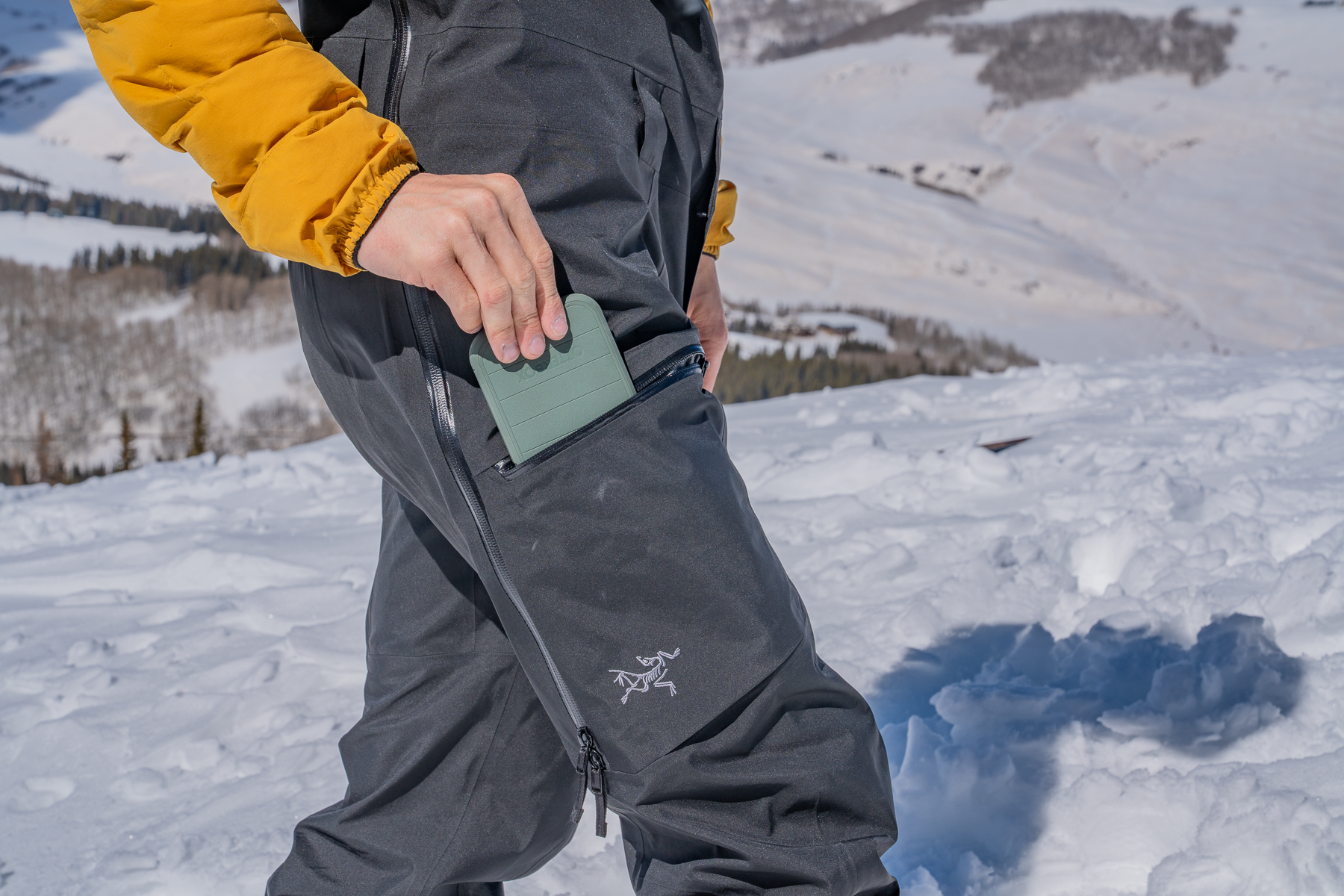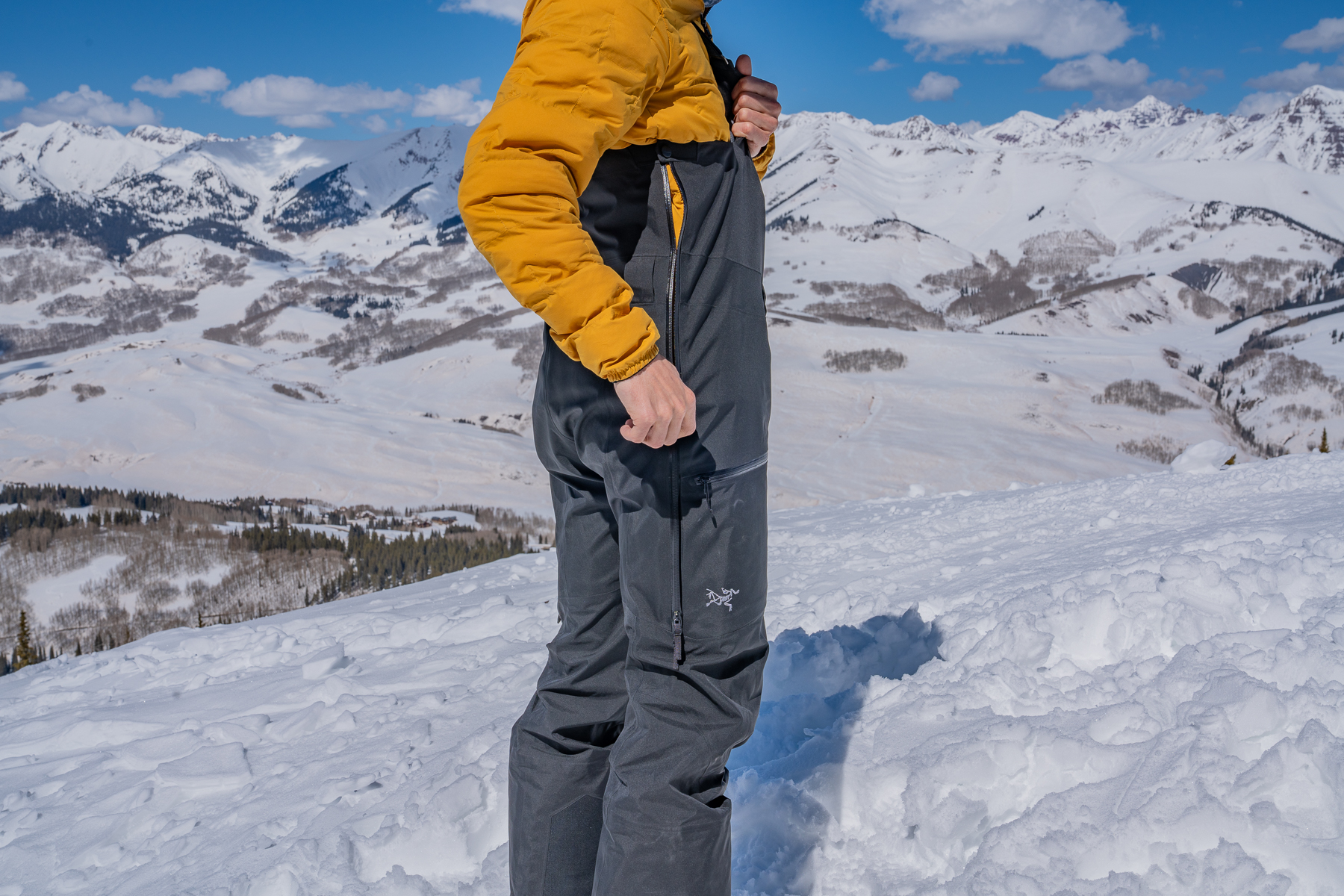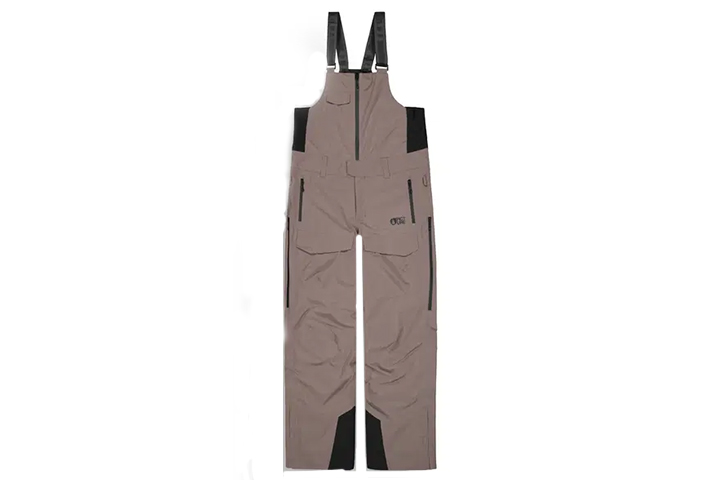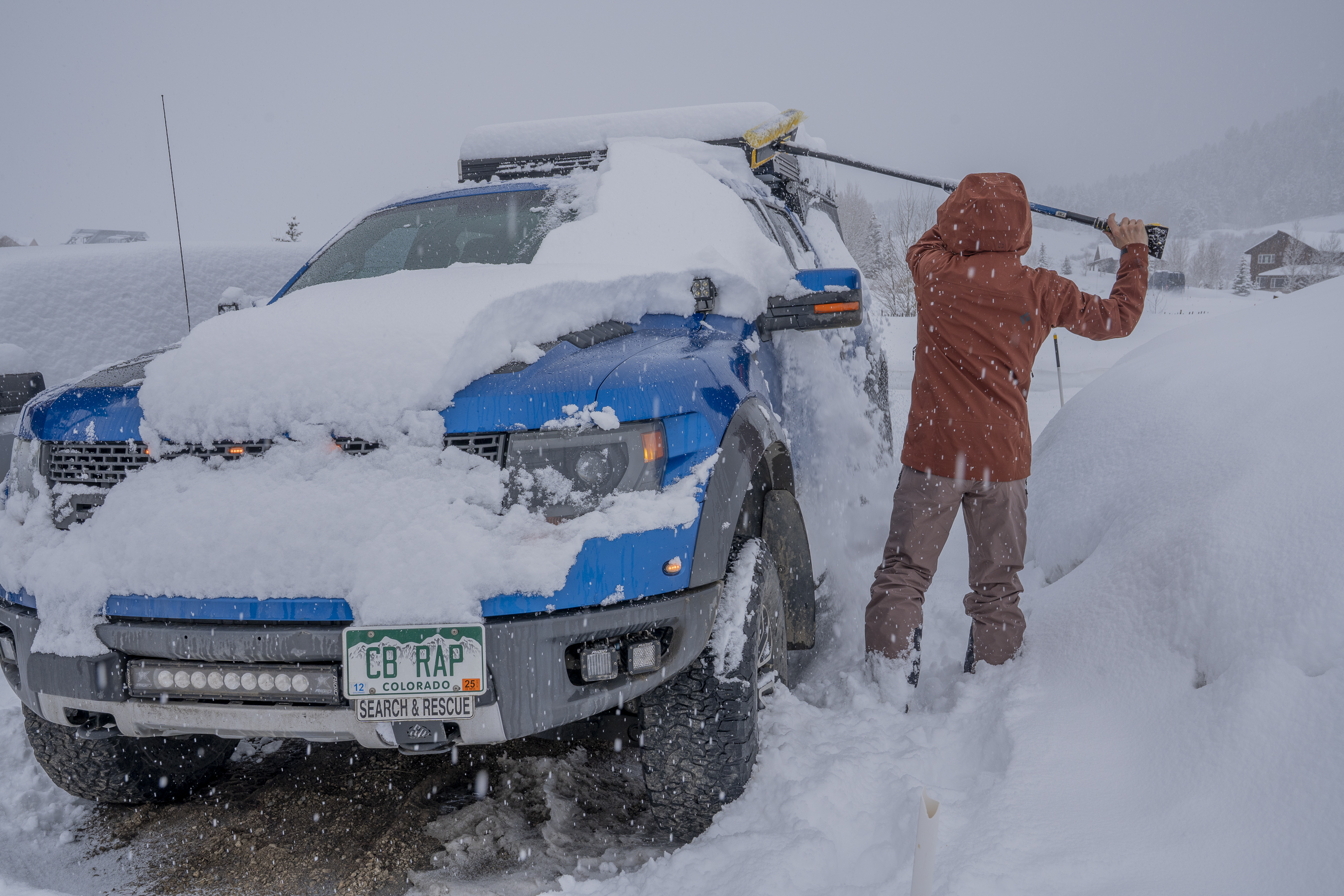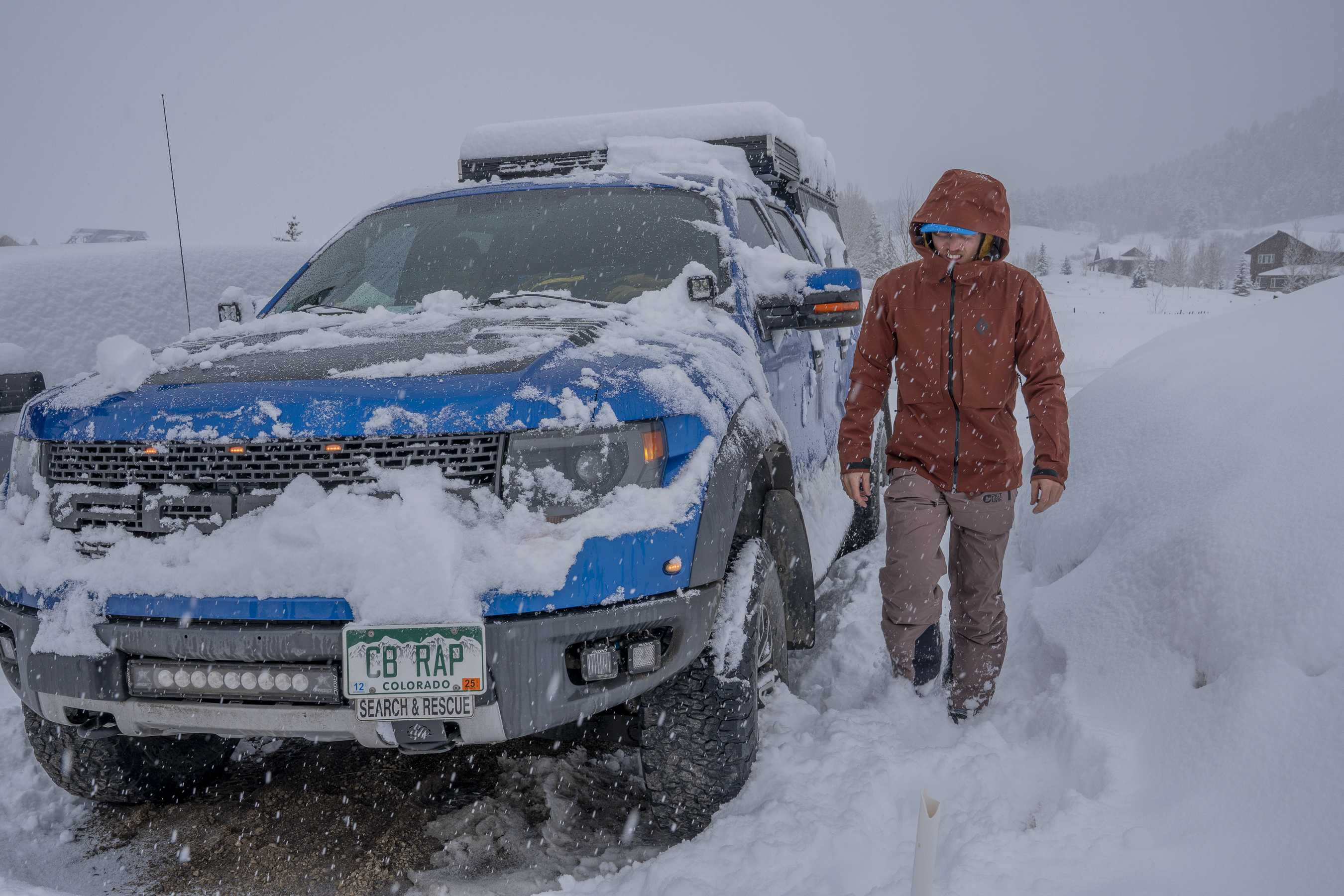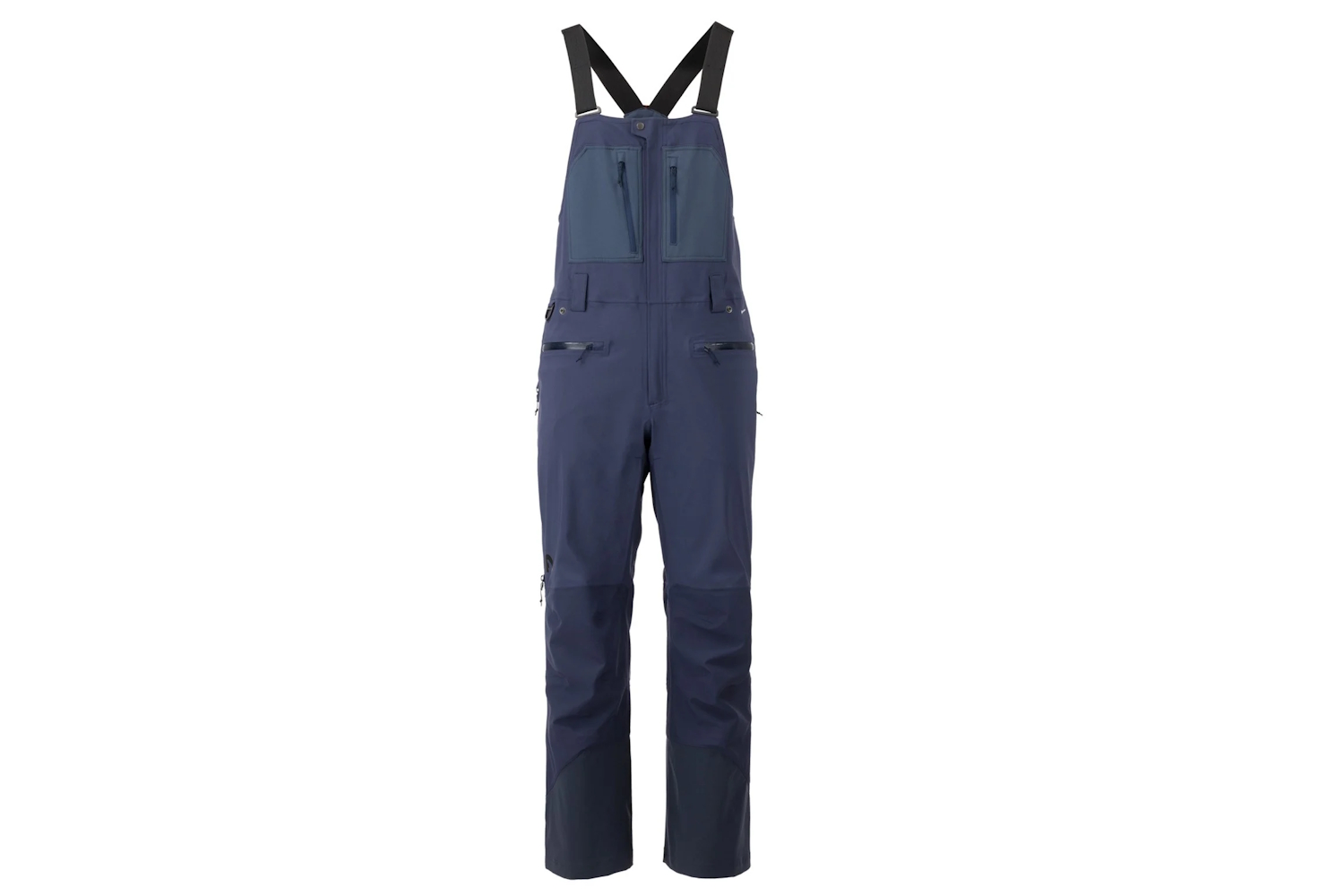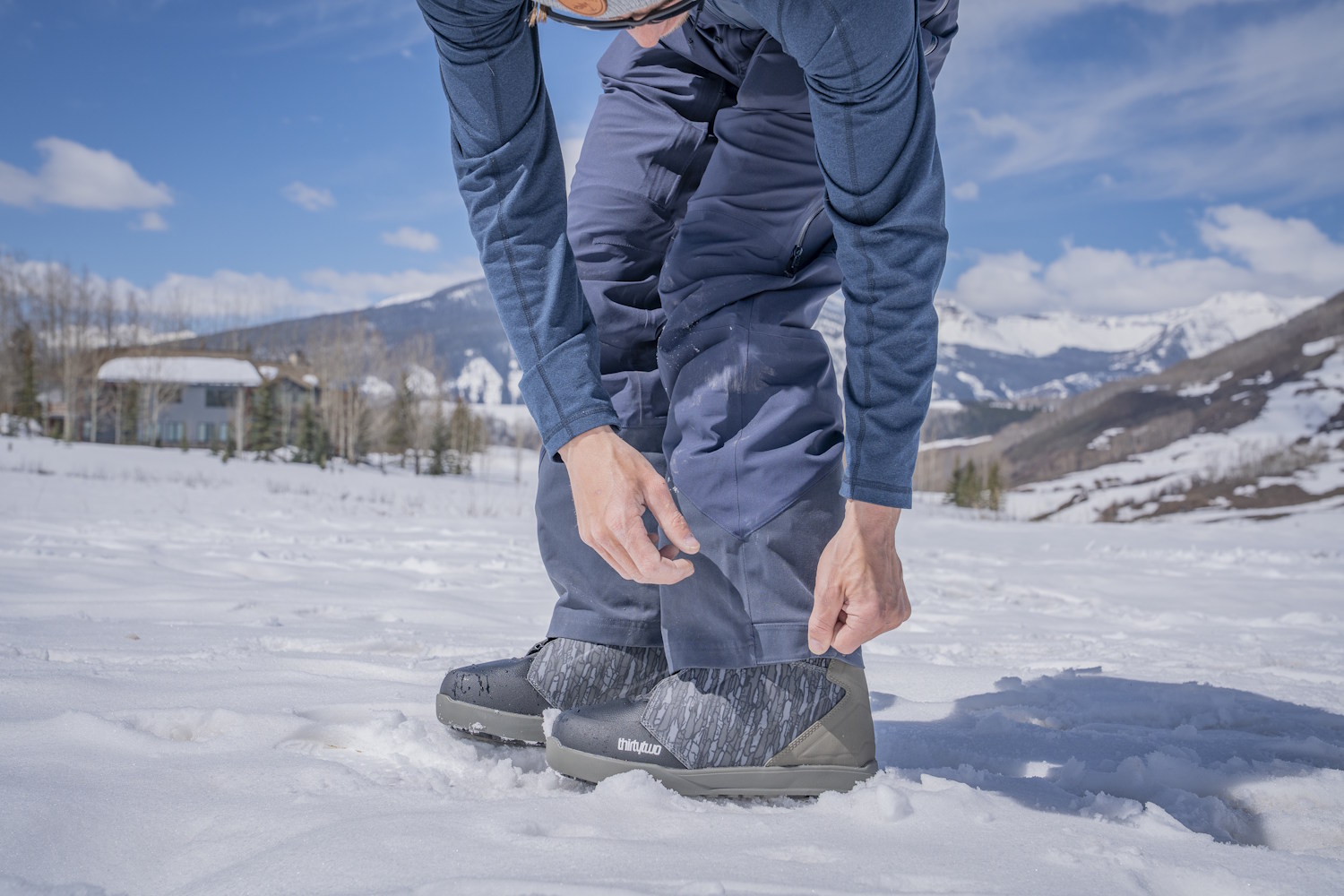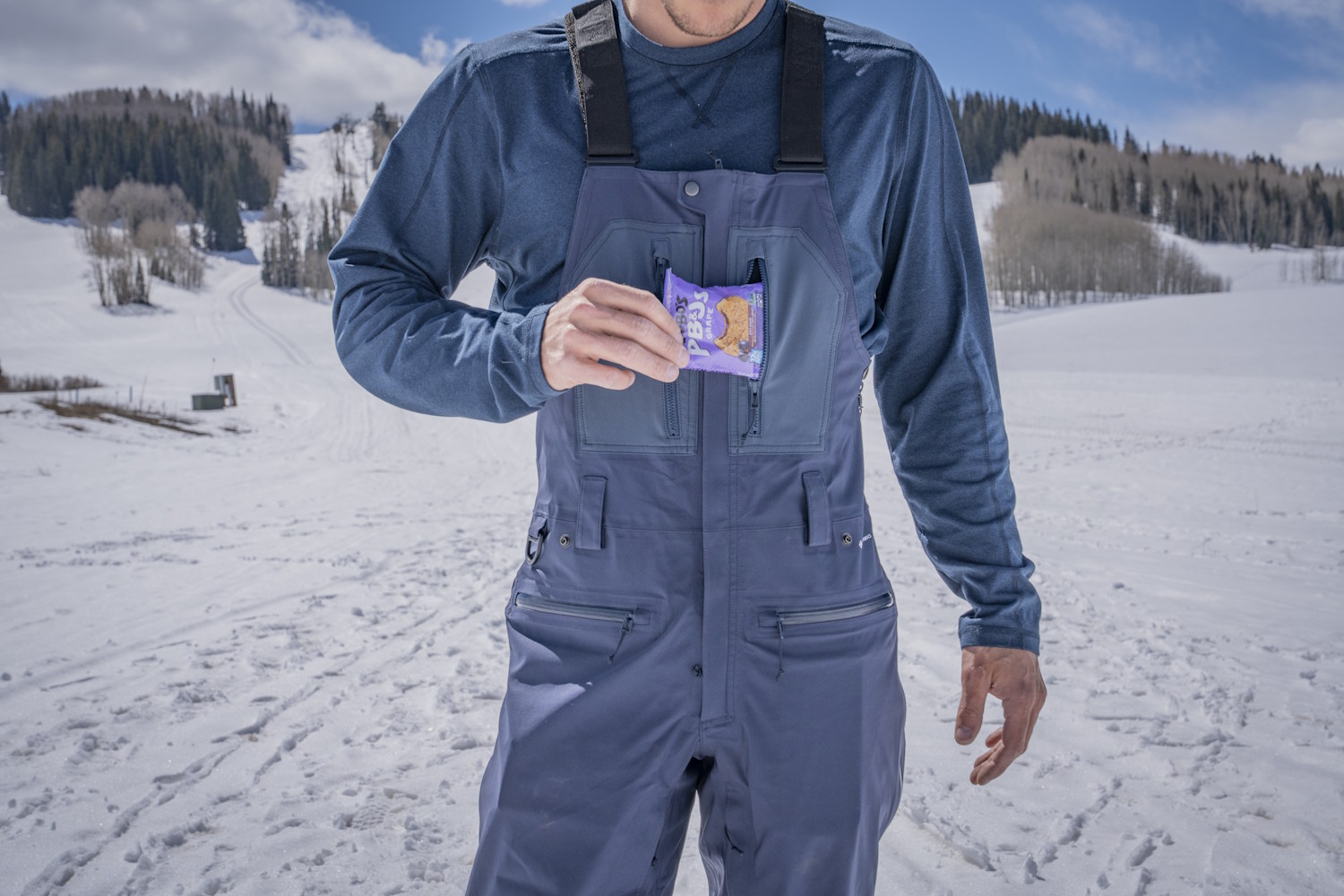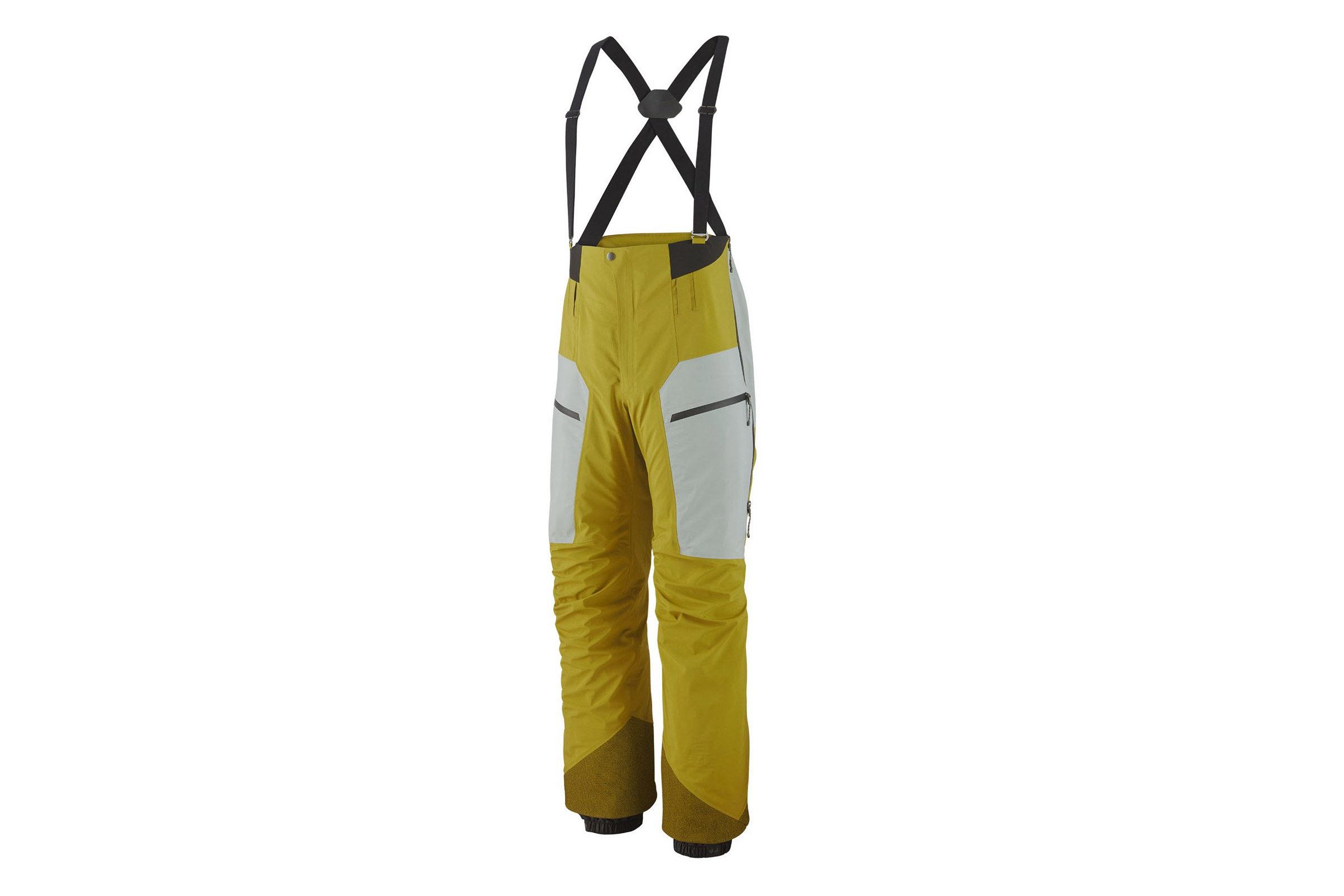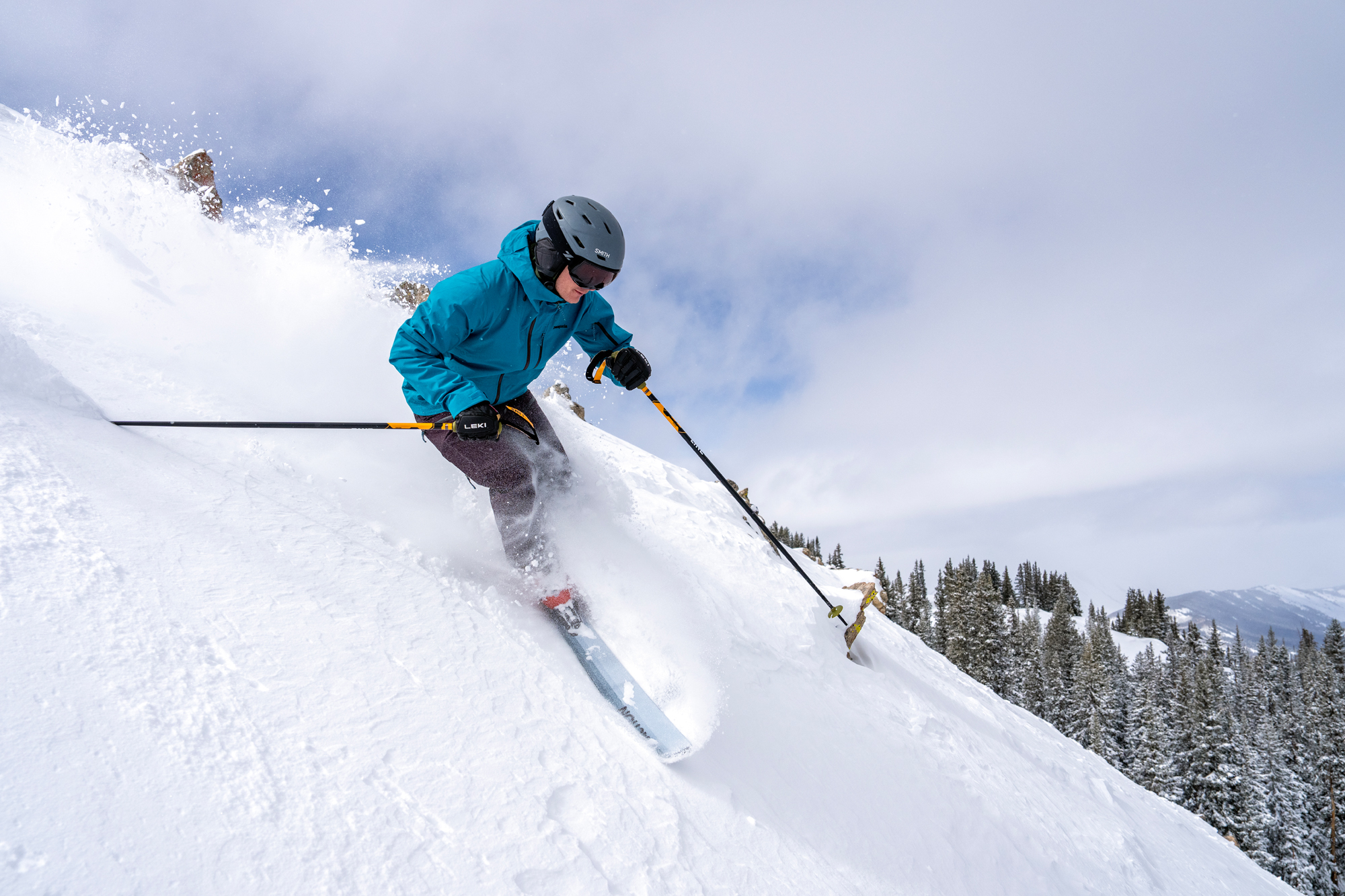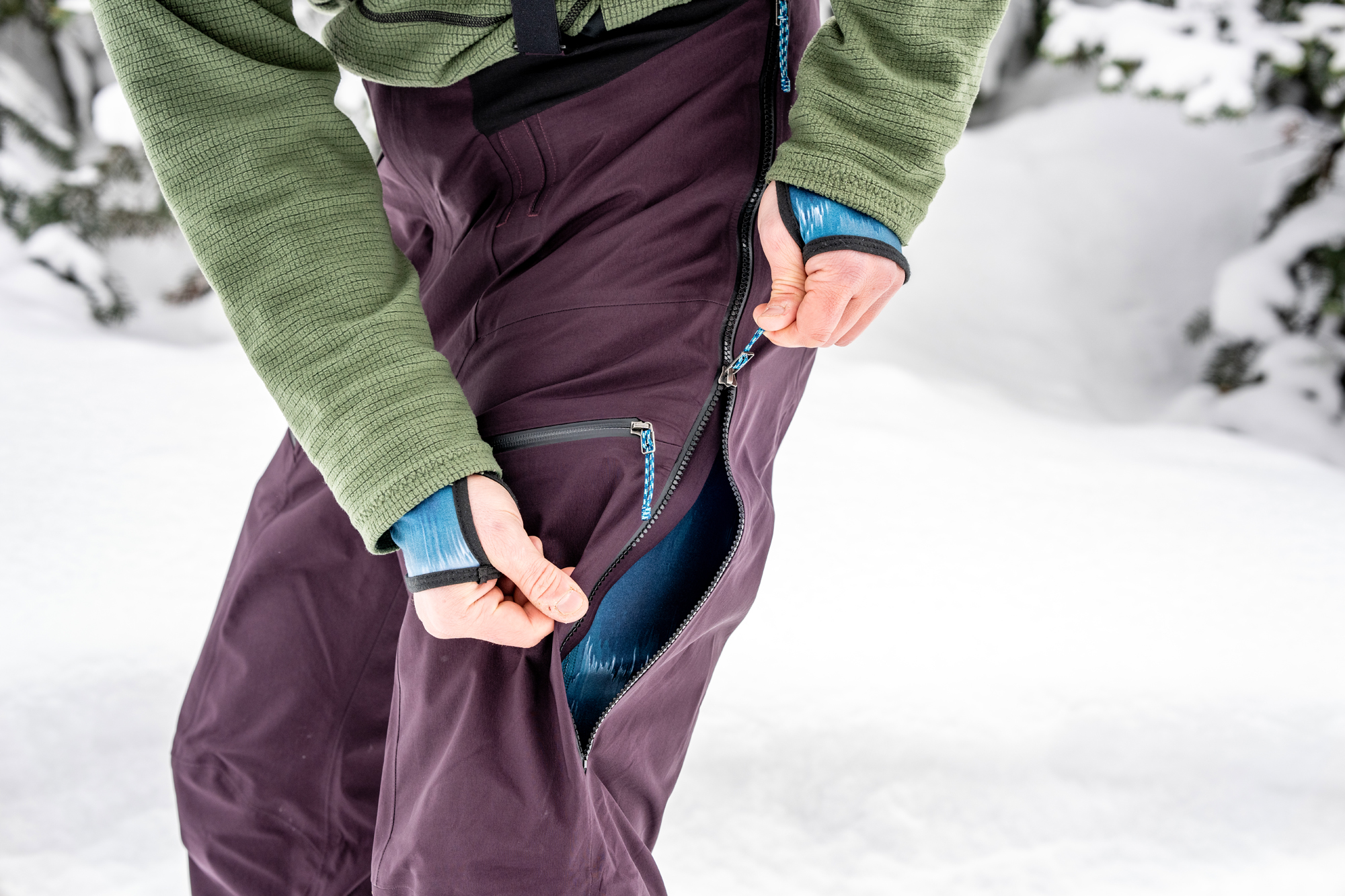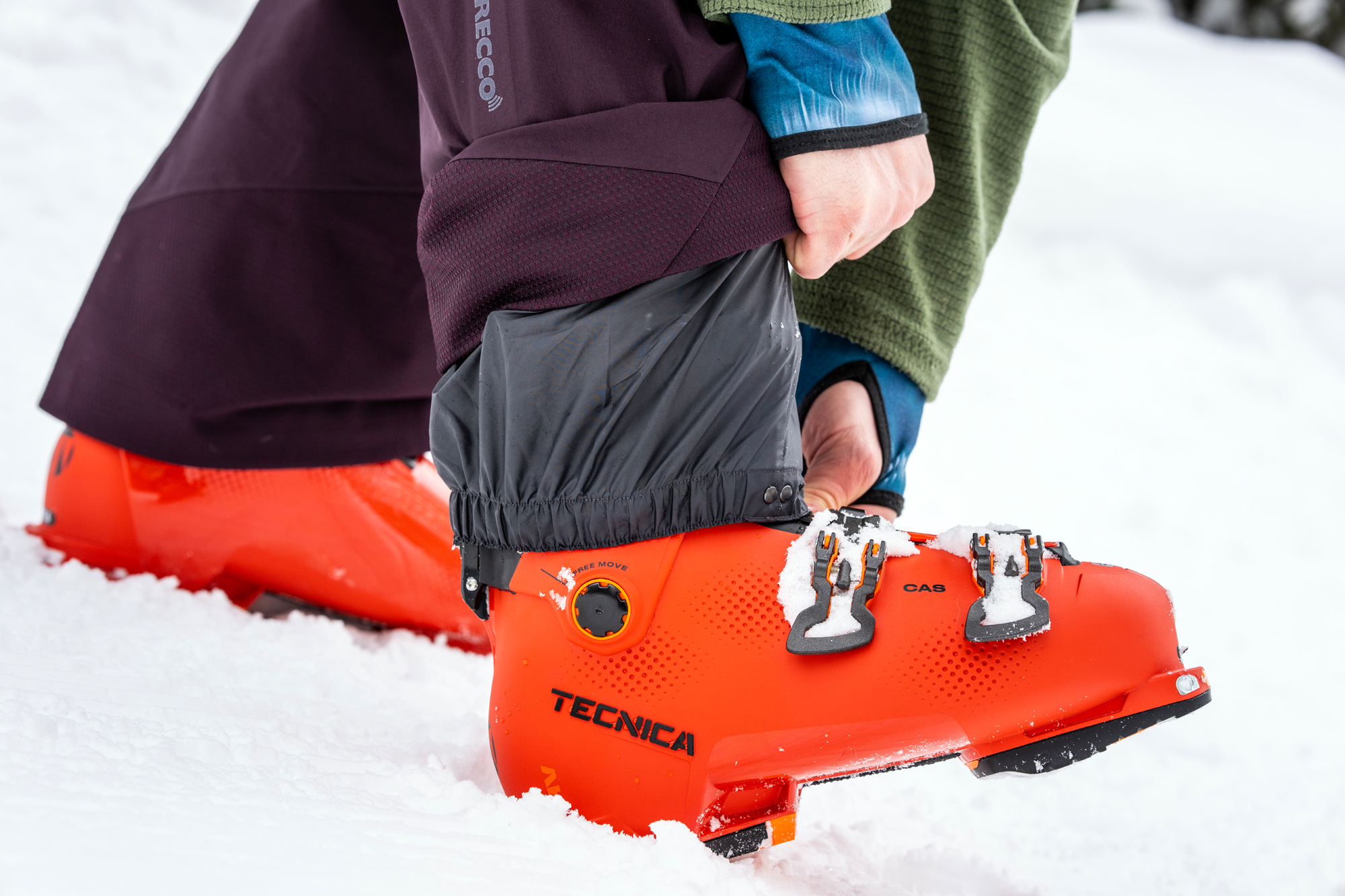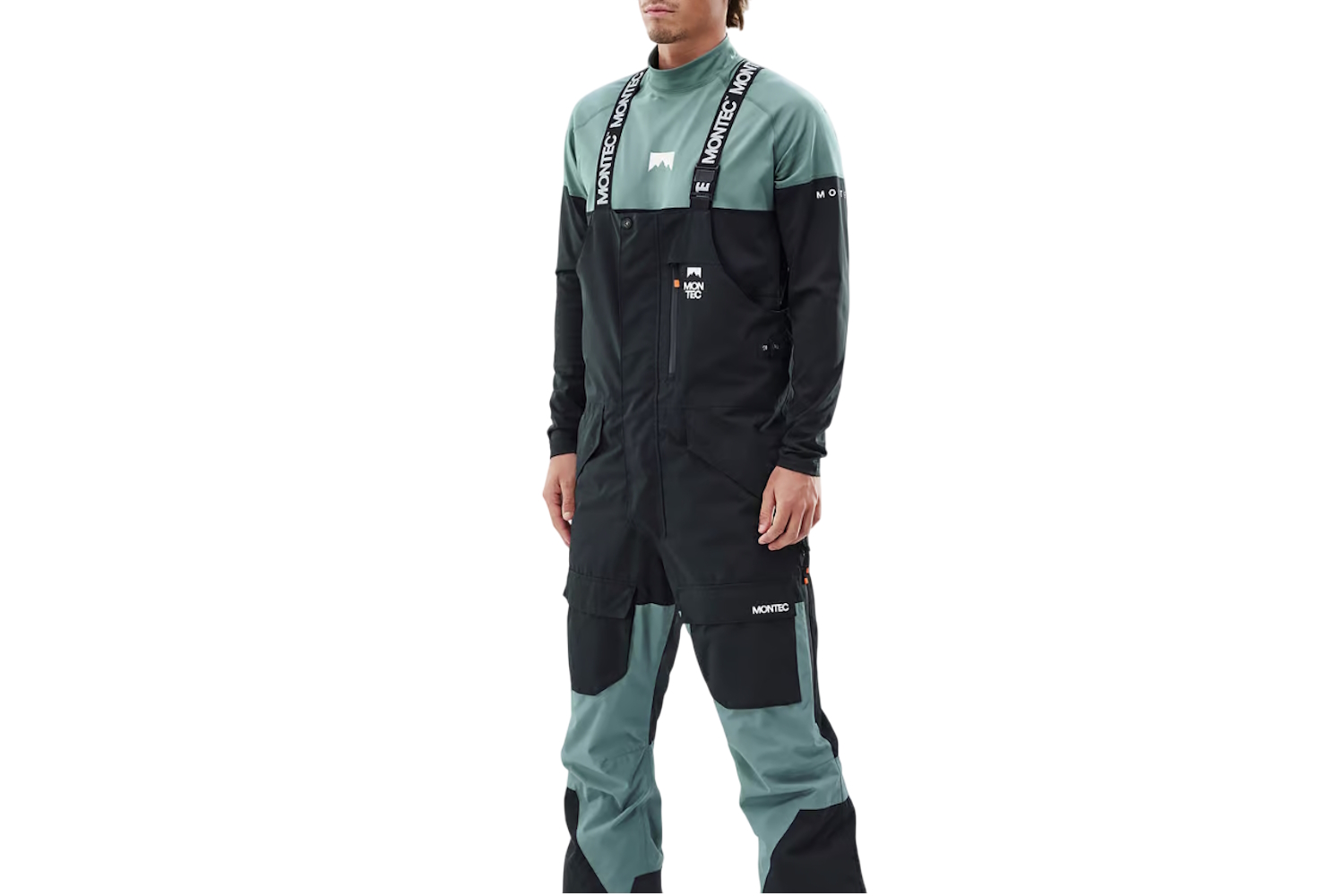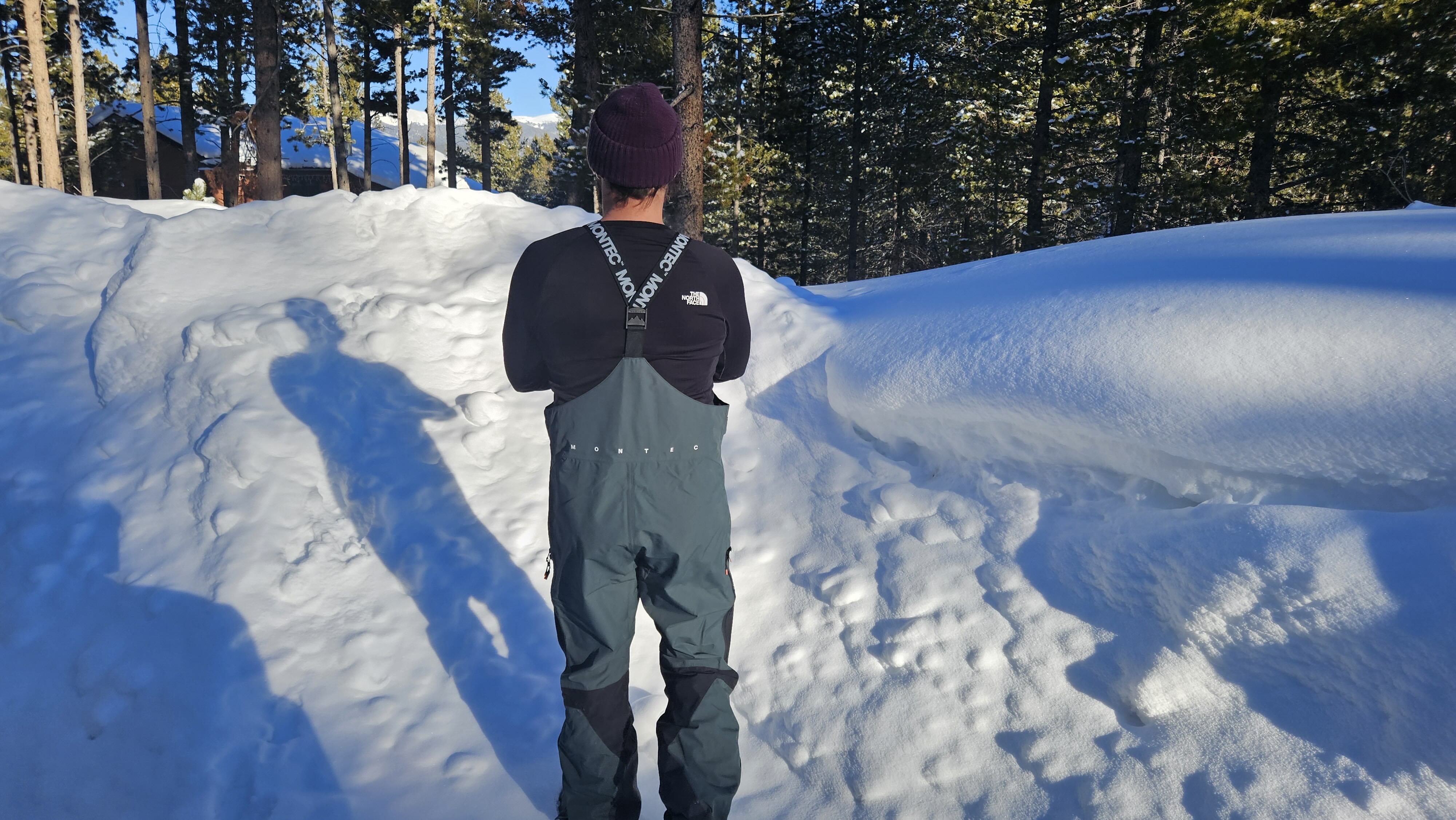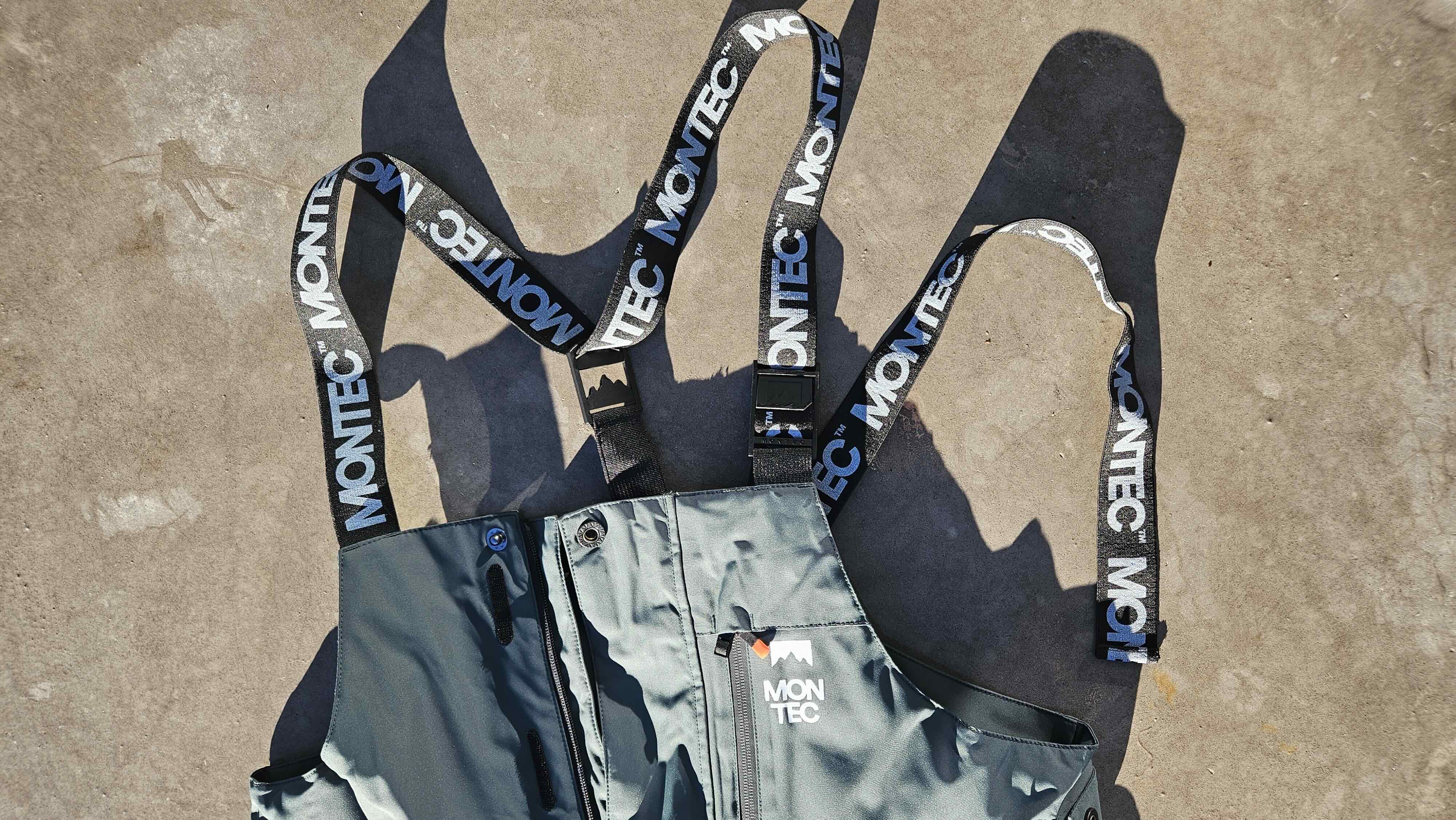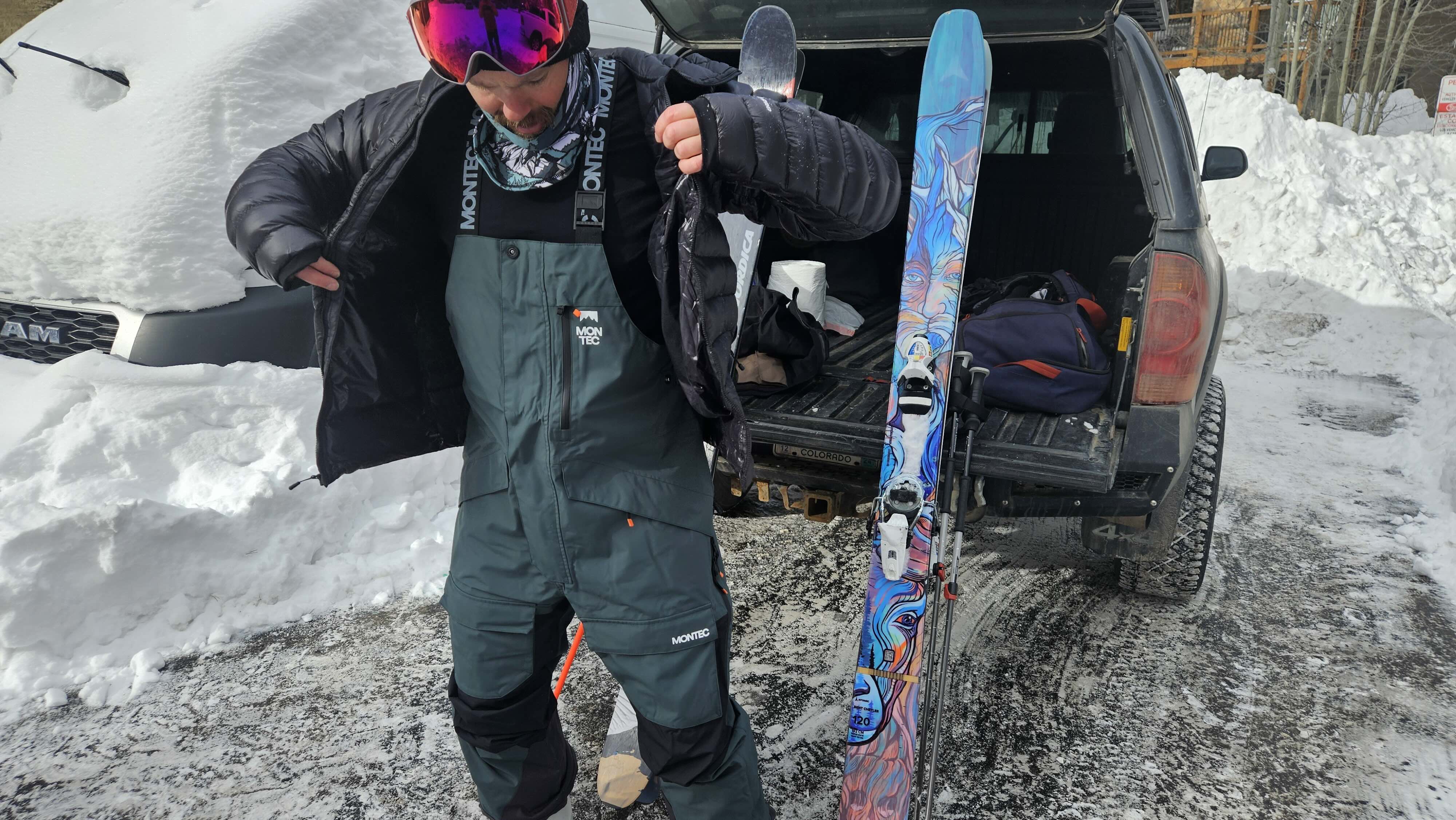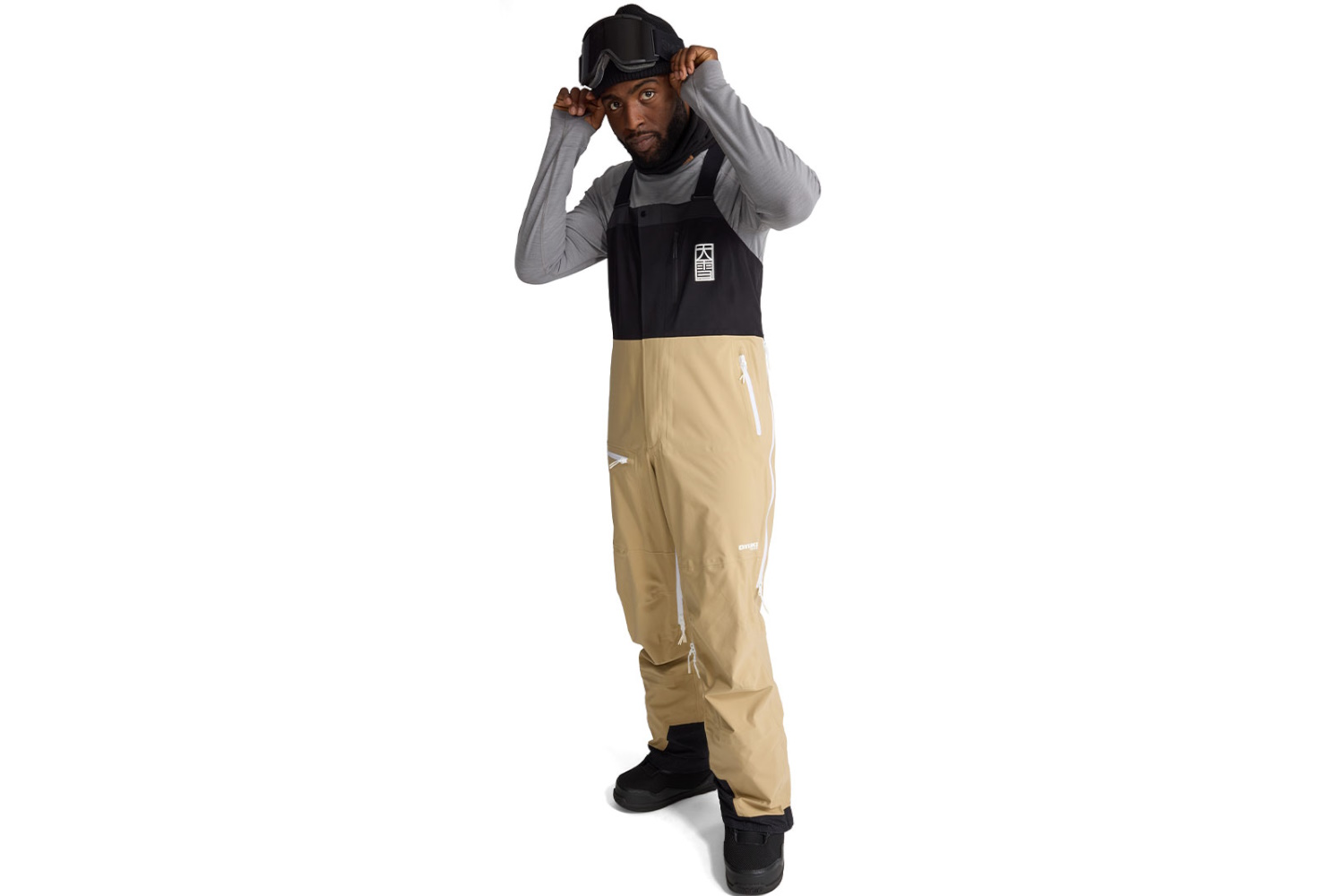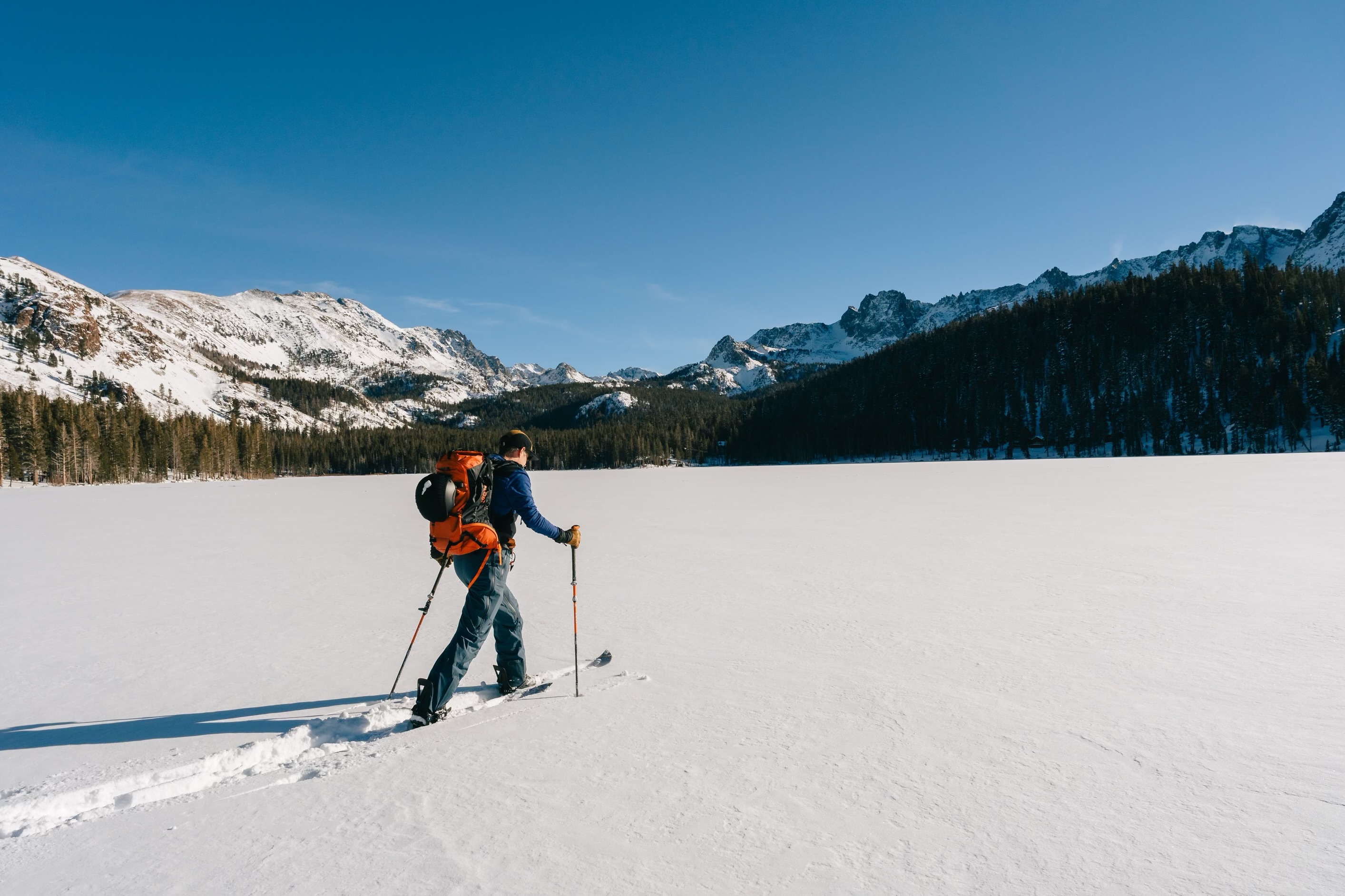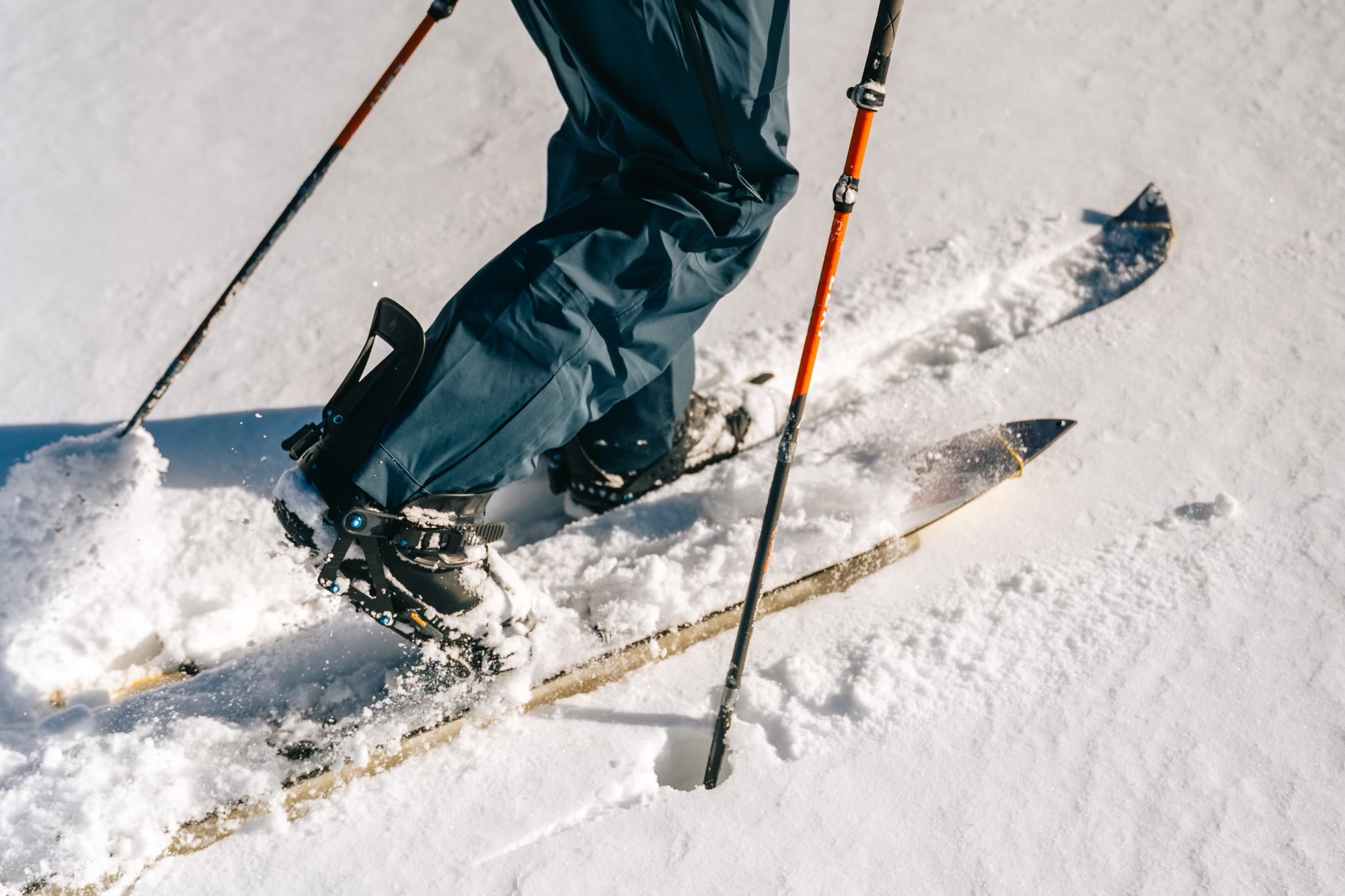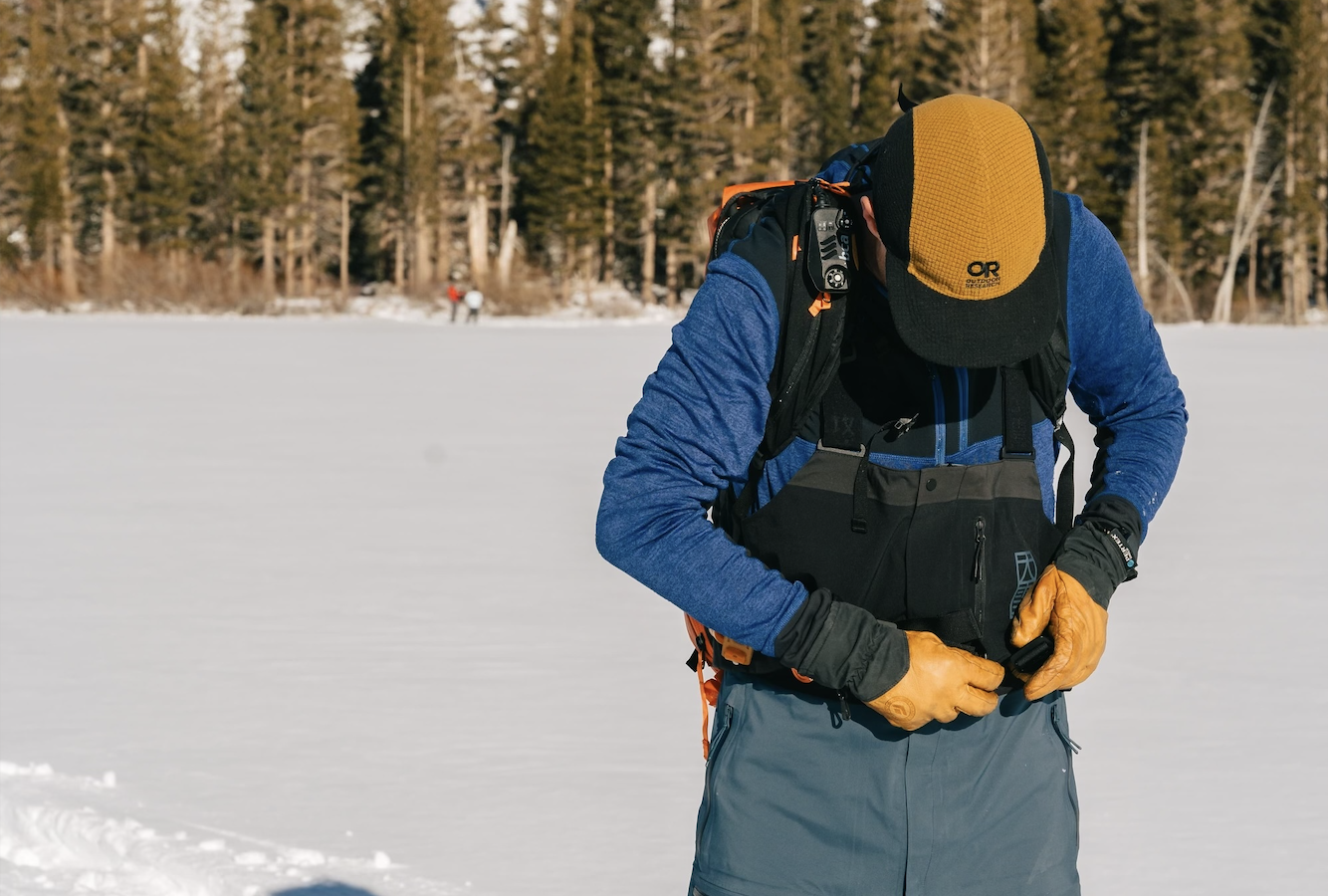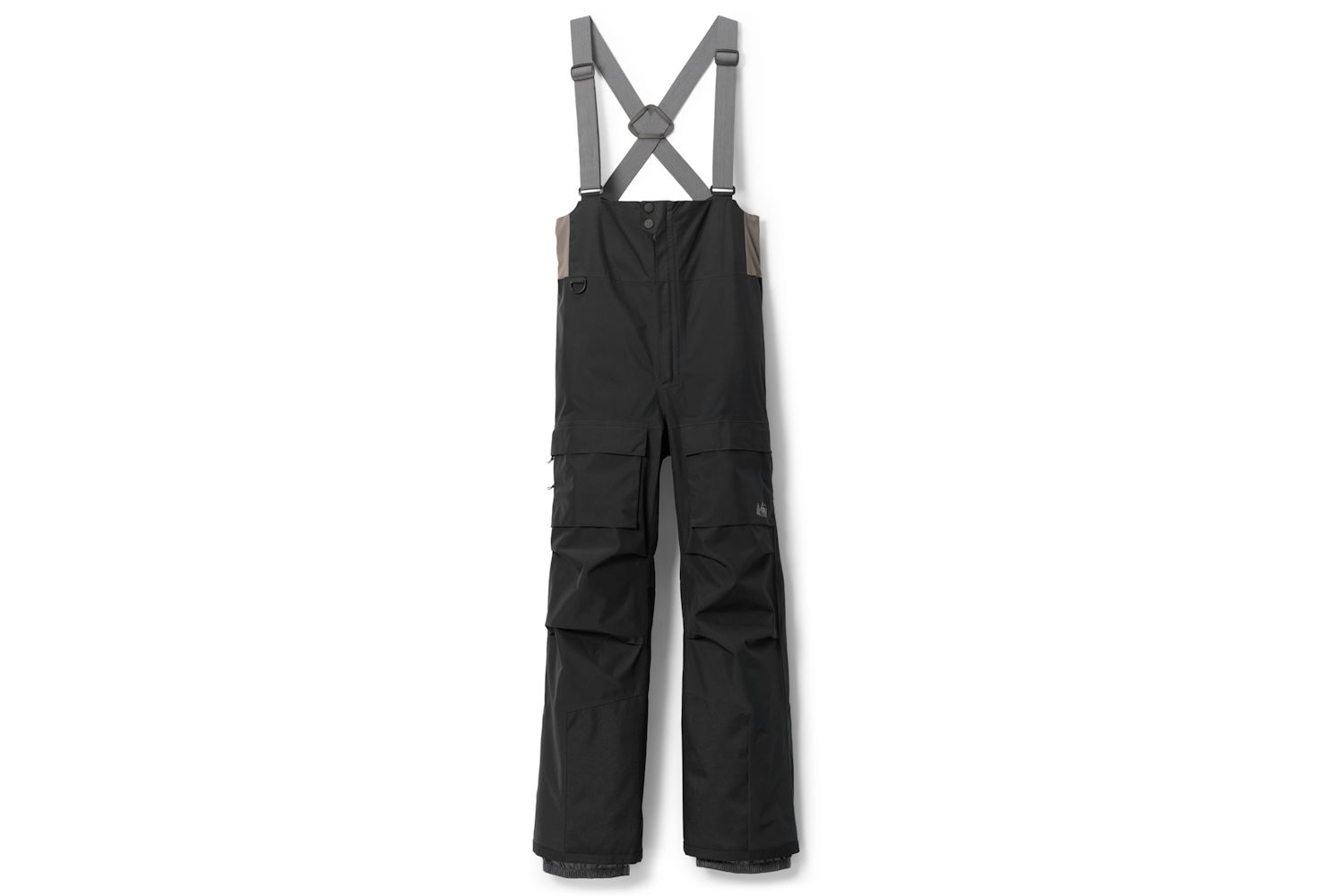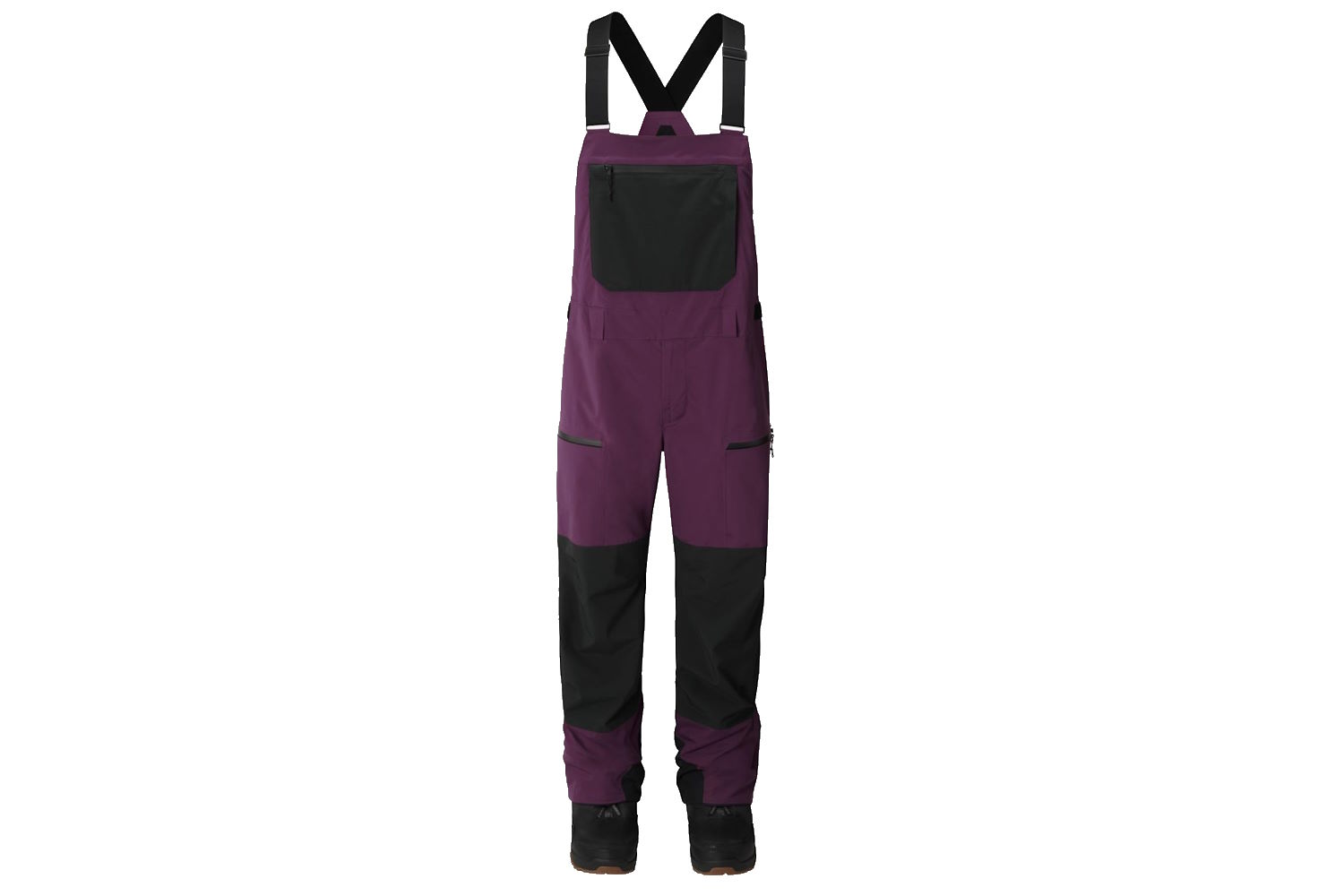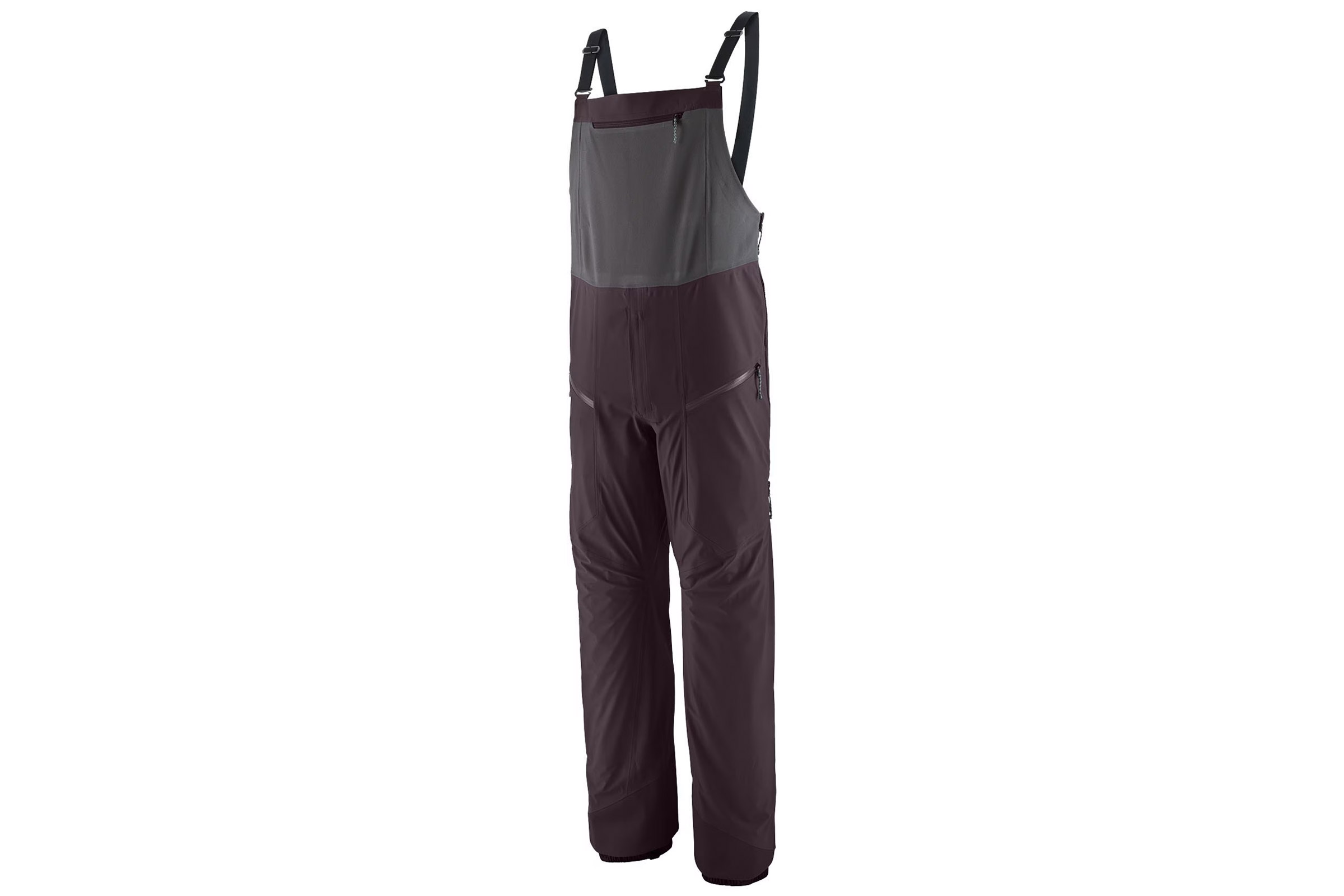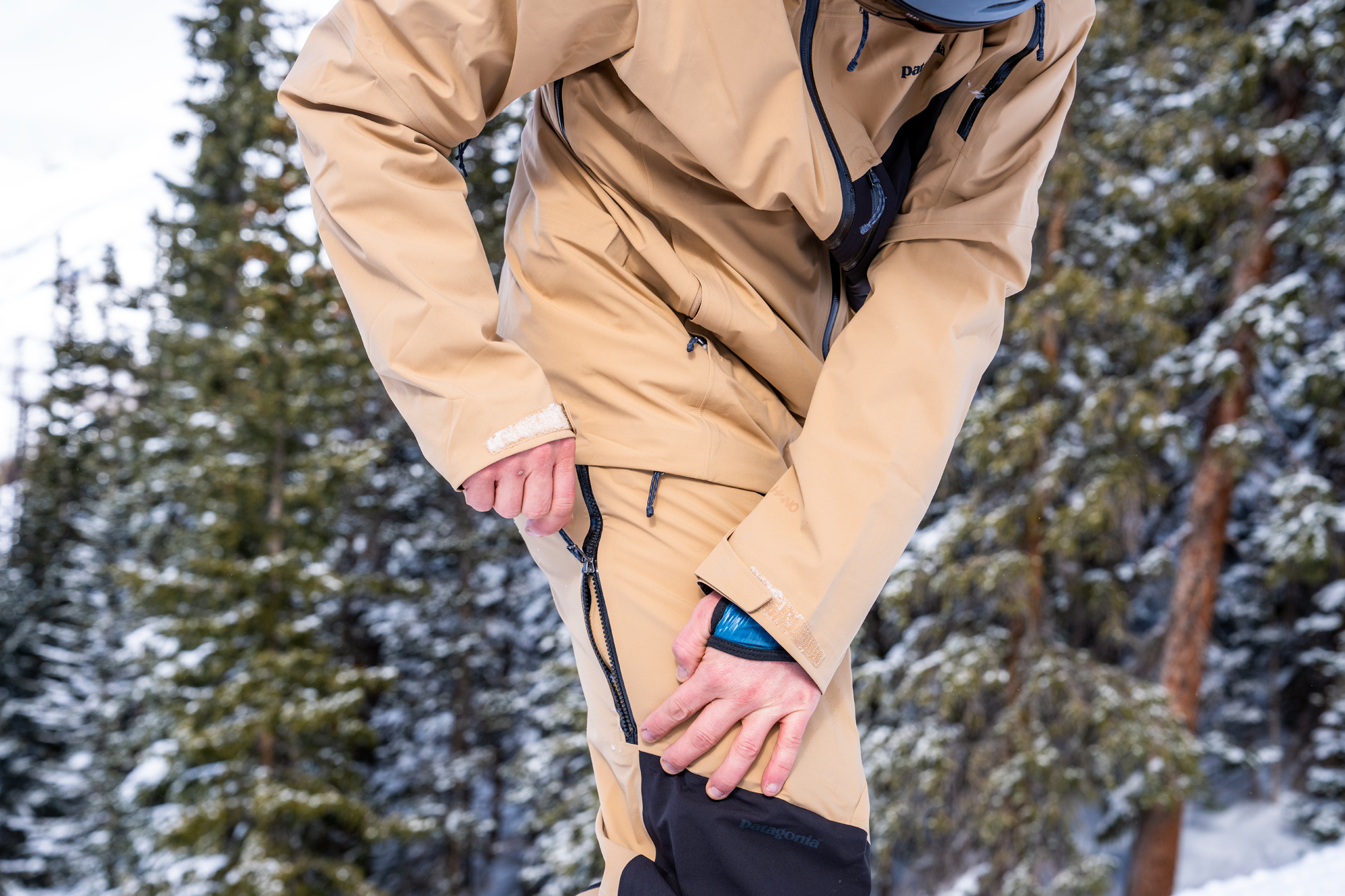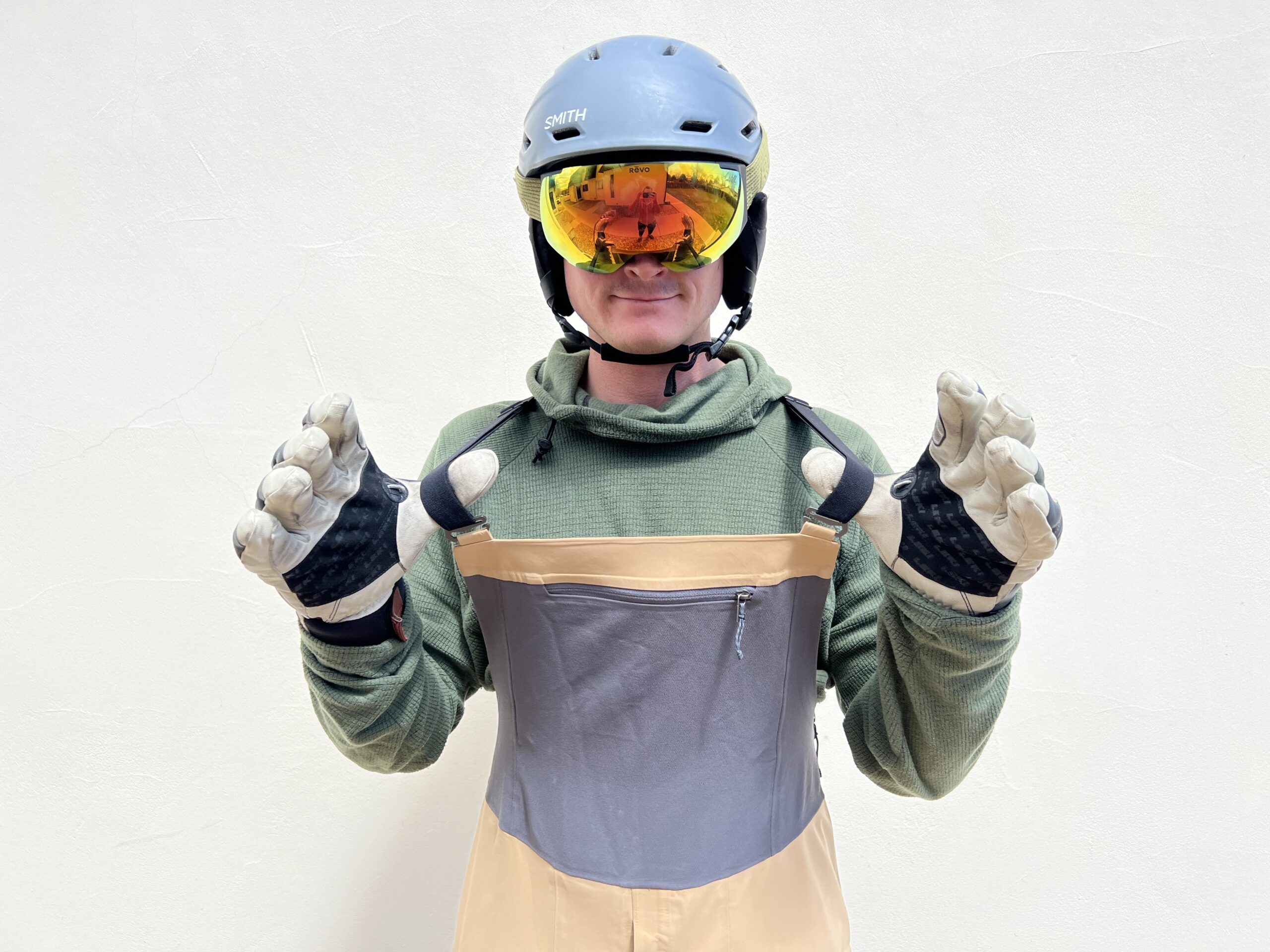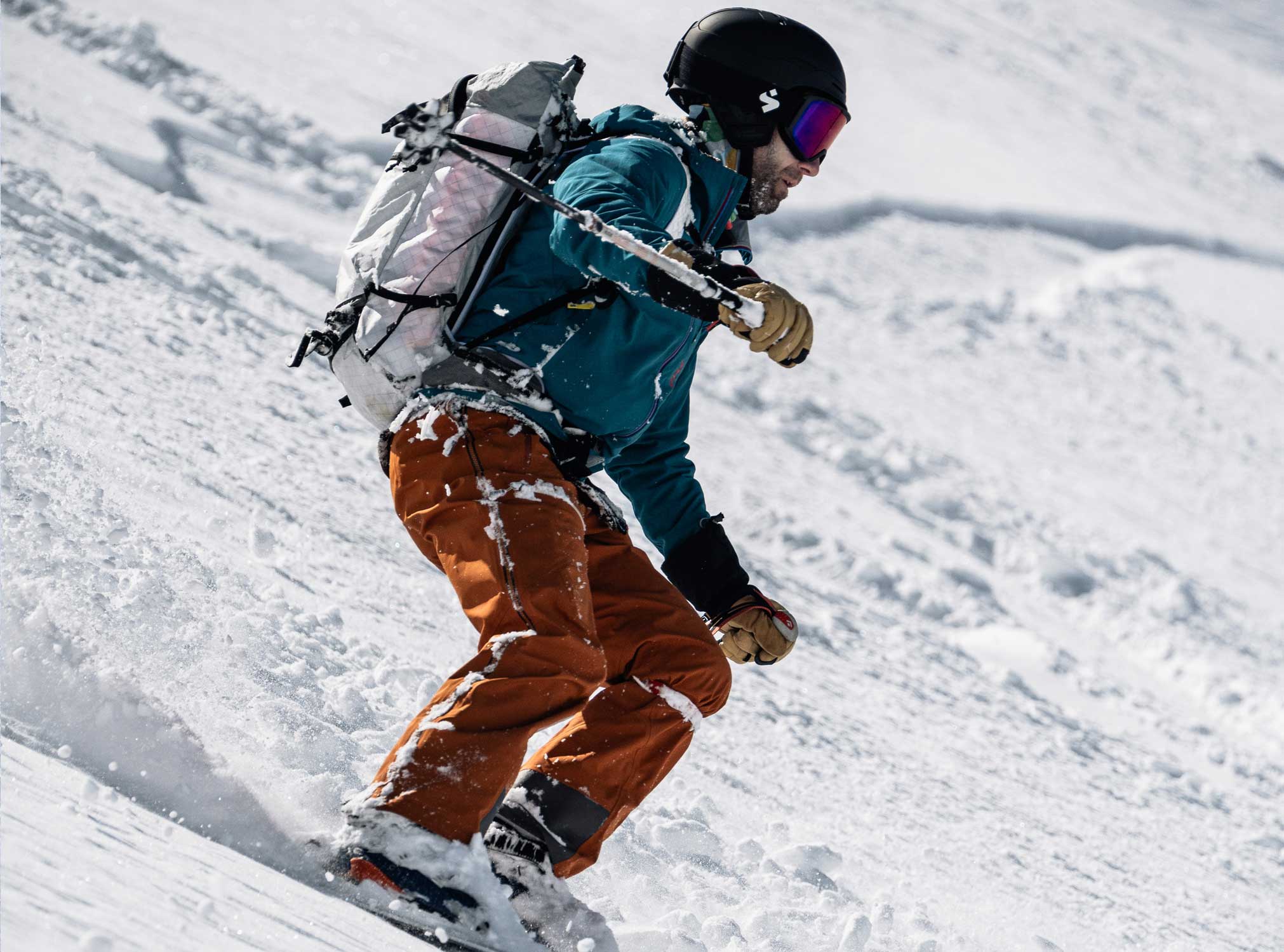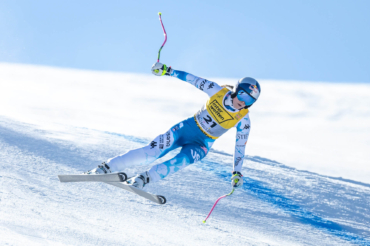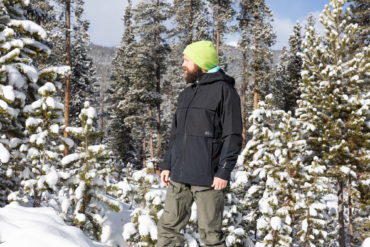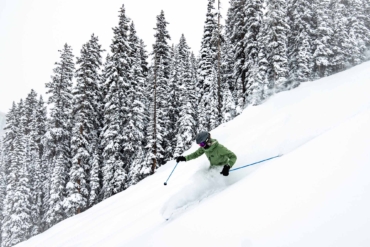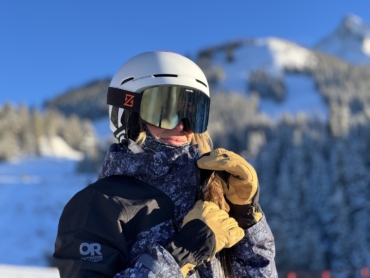Snow bibs keep snow out and warmth in. They’re versatile, comfortable, and stylish. The best men’s ski bibs offer more storage than ski pants, pair smoothly with ski backpacks, and you can ditch a belt. Brands round out these trousers with a drop seat — for easy bathroom breaks — quality material, leg vents, and often a matching jacket.
Top options like the Flylow Gear Baker Bib offer top-of-the-line waterproofness and breathability, knee patches, a side zipper that serves as a drop seat, shoulder straps that swiftly buckle on and off, plus kick patches with double the tenacity of other bibs. Other 2-layer designs, such as The North Face Freedom Bibs, lack a drop seat, detachable suspenders, and stretchier fabric, but are stylish, functional, and fit the bill for the average in-bounds shredder.
Since this guide was first published in 2022, we’ve led the way for bib buffs searching for a quality pair. For six or more months out of the year, we don snow bibs for -10-degree windchill, moisture-laden backcountry tours, stormy resort days, international missions, and while shoveling multiple feet off the deck. Our picks range from crown-shelf, pricey options to more affordable kits that won’t break the bank.
Editor’s Note: We updated our Men’s Ski Bibs buyer’s guide on November 3, 2025, adding an extended rating system that includes Waterproofing and Breathability, Fit and Mobility, Drop Seat and Fly Access, and Pockets. Read about it in our Men’s Ski Bibs Rating System.
The Best Men’s Ski Bibs of 2025-2026
Flylow Gear Baker Bib
-
Waterproofing and Breathability
9.0
-
Fit and Mobility
9.5
-
Drop Seat and Fly Access
9.0
-
Pockets
9.5
- Best for: Resort and backcountry
- Fit: Semi-loose fit
- Waterproofing: 3-layer construction with Intuitive membrane
- Pockets: 2 hand pockets, 1 rear, 1 thigh, 1 large kangaroo, 1 buttoned stow
Pros
- Heavy duty; ideal for bad weather
- Durable
- Ample chest pocket storage
Cons
- Bold style won’t suit everyone
The North Face Freedom Bibs
-
Waterproofing and Breathability
8.0
-
Fit and Mobility
8.0
-
Drop Seat and Fly Access
5.0
-
Pockets
8.0
- Best for: Resort skiing and riding
- Fit: Regular
- Waterproofing: 2-layer construction with DryVent membrane
- Pockets: 1 hook-and-loop chest pocket, 2 zippered hand pockets, 2 hook-and-loop cargo pockets
Pros
- Good value
- Stylish
Cons
- Not ideal for hiking or skinning
- Durability hit
Jones Shralpinist Recycled GORE-TEX ePE Bibs
-
Waterproofing and Breathability
9.5
-
Fit and Mobility
9.0
-
Drop Seat and Fly Access
8.9
-
Pockets
9.5
- Best for: Resort, Backcountry, Alpine
- Fit: regular
- Waterproofing: 3-layer GORE-TEX ePE
- Pockets: Two zippered chest pockets, Two zippered thigh pockets, Chest dump pocket
Pros
- Extremely lightweight and packable
- Top tier 3L GORE-TEX ePE waterproofing
- Designed for long days in harsh conditions
- 100% recycled fabric
Cons
- Premium Price Point
- No insulation, noticeable with lightweight fabric
- Limited color options
TREW Gear TREWth Primo Bib
-
Waterproofing and Breathability
9.5
-
Fit and Mobility
8.9
-
Drop Seat and Fly Access
9.0
-
Pockets
7.9
- Best for: Resort and backcountry
- Fit: Semi-loose fit
- Waterproofing: 3-layer construction with 20,000mm rated membrane
- Pockets: 2 hand pockets, 2 thigh pockets, chest transceiver pocket, 1 zippered chest, 1 Velcro chest
Pros
- Heavy-duty and waterproof
- Rugged durability
- Extended sizes
Cons
- Small chest pockets for phones
Outdoor Research Hemispheres II GORE-TEX Bibs
-
Waterproofing and Breathability
9.5
-
Fit and Mobility
8.9
-
Drop Seat and Fly Access
8.9
-
Pockets
9.5
- Best for: Backcountry touring
- Fit: Slim
- Waterproofing: 3-layer construction with GORE-TEX C-Knit membrane
- Pockets: 1 beacon pocket, 1 zippered bib pocket, 2 zippered hand pockets
Pros
- Impressive stretch for a GORE-TEX bib
- Excellent for the backcountry
Cons
- Slim fit won’t suit everyone
Stio Men’s Figment Bib
-
Waterproofing and Breathability
8.5
-
Fit and Mobility
9.2
-
Drop Seat and Fly Access
9.0
-
Pockets
9.5
- Best for: Resort, sidecountry
- Fit: Relaxed freeride
- Waterproofing: 3-layer construction with 20/10K membrane
- Pockets: 2 hand pockets, 2 bellowed thigh pockets, 1 chest pocket with interior media pocket
Pros
- Heavy-duty 3L fabric is warm and durable
- Center zip for easy entry and quick pee breaks
- Adjustable suspenders
Cons
- Only one chest pocket
- Waist strap is off center
- Runs large
Other Snow Suspenders We Dig
-
Waterproofing and Breathability
7.9
-
Fit and Mobility
8.0
-
Drop Seat and Fly Access
7.0
-
Pockets
8.0
- Best for: Resort
- Fit: Regular
- Waterproofing: 2L Picture's 20K Dryplay membrane, 45% Circular polyester, PFC-free Teflon Ecoelite,
- Pockets: 1 chest pouch with flap closure, 2 zippered hand pockets, 2 zippered thigh pockets
Pros
- Stylish, minimalist aesthetic
- Reinforced durability including hems and cuffs
- Heavy-duty 2L fabric
Cons
- Small chest pocket won't fit iPhone
- No drop seat
- No adjustable waist
-
Waterproofing and Breathability
9.0
-
Fit and Mobility
9.2
-
Drop Seat and Fly Access
8.9
-
Pockets
7.9
- Best for: Backcountry and Resort
- Fit: Regular
- Waterproofing: 3L Flylow Surface fabric, 20K, PFAS-free DWR
- Pockets: 2 zippered chest pockets, 2 zippered thigh pockets, 1 rear pocket
Pros
- Durable fabric mapping on knees and seat
- Inner and outer thigh vents
- Sustainable details
Cons
- Chest pocket can't fit phone
- Cuffs feel large, almost like bell bottoms
- No gaiter hooks
-
Waterproofing and Breathability
9.0
-
Fit and Mobility
8.0
-
Drop Seat and Fly Access
8.0
-
Pockets
7.0
- Best for: Backcountry/Resort
- Fit: Regular
- Waterproofing: 3-layer construction with GORE-TEX’s ePE membrane,
- Pockets: 2 hand pockets, 1 chest pocket
Pros
- Warm and waterproof
- Durable
- Great color options
Cons
- Heavy
- Not extremely breathable
- Waist-height bib could be a drawback for shredders
-
Waterproofing and Breathability
8.5
-
Fit and Mobility
9.0
-
Drop Seat and Fly Access
7.9
-
Pockets
9.0
- Best for: Resort
- Fit: Semi-loose fit
- Waterproofing: 3-layer construction
- Pockets: 2 thigh pockets, 2 hand pockets, 1 chest pocket
Pros
- Tapered, articulated legs for more athletic cut
- Lower price point
- 39 (not a typo) colorways with matching jacket options
Cons
- Less breathable than higher-end options
- No warranty
-
Waterproofing and Breathability
9.0
-
Fit and Mobility
9.0
-
Drop Seat and Fly Access
9.0
-
Pockets
8.9
- Best for: Resort and backcountry
- Fit: Relaxed fit
- Waterproofing: 3-layer construction
- Pockets: 2 hand pockets, 1 thigh, 1 chest
Pros
- Meticulous construction
- Top comfort with this soft, stretchy, durable fabric
- Thoughtful details
Cons
- No dedicated pocket for an avalanche beacon/transceiver
- No clip for an avalanche beacon/transceiver
-
Waterproofing and Breathability
8.5
-
Fit and Mobility
8.0
-
Drop Seat and Fly Access
7.0
-
Pockets
7.5
- Best for: Backcountry skiing and riding
- Fit: Straight
- Waterproofing: 3-layer construction 100% upcycled polyester with 20K/20K rating membrane
- Pockets: 2 front thigh
Pros
- Breathable and stretchy, good for touring
- Made from organic and upcycled materials
- Fits very well
Cons
- No RECCO
- Lacks chest pocket
-
Waterproofing and Breathability
7.5
-
Fit and Mobility
8.0
-
Drop Seat and Fly Access
8.5
-
Pockets
7.0
- Best for: Resort and backcountry
- Fit: Regular
- Waterproofing: 2-layer construction with GORE-TEX ePE membrane
- Pockets: Zippered chest pocket, 2 drop-in thigh pockets — 1 with a zipper, 1 with hook-and-loop closure
Pros
- Great value
- Versatile enough for the resort and the backcountry
Cons
- A bit low cut for some preferences
-
Waterproofing and Breathability
9.0
-
Fit and Mobility
9.0
-
Drop Seat and Fly Access
8.5
-
Pockets
9.0
- Best for: Backcountry touring
- Fit: Baggy
- Waterproofing: 20K/20K
- Pockets: 1 zippered chest pocket, 2 zippered thigh pockets
Pros
- Leader of eco-friendly design
- The fit isn’t too snug
Cons
- Zip pulls are on the smaller side
-
Waterproofing and Breathability
9.0
-
Fit and Mobility
8.2
-
Drop Seat and Fly Access
8.0
-
Pockets
8.0
- Best for: Backcountry skiing and riding
- Fit: Regular
- Waterproofing: 3-layer construction with PFC-free fabric, membrane, and DWR-finish, meets Patagonia's H2No benchmark for longterm waterproof-breathable standards and durability
- Pockets: 2 thigh zippered cargo pockets, 1 large zippered chest pocket with inside loop
Pros
- Breathable
- Stretchy with great mobility
- Lightweight
- Free of toxic chemicals
Cons
- Sizing is baggy and on the larger side
- The feathery and non-insulated feel might not be every shredders choice
- Shoulder straps can get twisted
Men’s Ski Bibs Comparison Chart
Scroll right to view all of the columns: Price, Best For, Fit, Waterproofing, Pockets.
| Ski Bib | Price | Best For | Fit | Fabric/Waterproofing | Pockets |
| Flylow Gear Baker | $430 | Resort | Regular | 3L, 20K, PFAS-free DWR, Flylow’s Intuitive fabric | 2 hand pockets, 1 rear, 1 thigh, 1 large kangaroo, 1 buttoned stow |
| The North Face Freedom | $220 | Resort | Regular | 2L, Waterproofness unavailable, PFC-free DWR, TNF’s DryVent fabric | 1 hook-and-loop chest pocket, 2 zippered hand pockets, 2 hook-and-loop cargo pockets |
| Jones Shralpinist Recycled GORE-TEX ePE | $725 | Backcountry | Regular | 3L, 28K, ePE GORE-TEX, PFC-free DWR | 2 zippered chest pockets, 2 zippered thigh pockets, 1 mesh chest dump pocket |
| TREW Gear TREWth Primo | $499 | Resort | Regular | 3L, 20K, PFAS-free, TREW’s Primo fabric | 2 hand pockets, 2 thigh pockets, 1 brand-designated transceiver pocket, 1 zippered chest, 1 velcro chest |
| Outdoor Research Hemispheres II GORE-TEX | $649 | Backcountry | Athletic | 3L, 28K, GORE-TEX C-Knit | 1 brand-designated beacon pocket, 1 zippered chest pocket, 2 zippered hand pockets |
| Stio Men’s Figment Bib | $479 | Resort | Freeride | 3L, 20K, PFAS-free, Stio’s PeakProof fabric | 2 zippered hand pockets, 2 zippered bellowed thigh pockets, 1 zippered chest pocket |
| Arc’teryx Sabre | $700 | Backcountry | Regular | 3L, 28K, ePE GORE-TEX, PFC-free DWR | 2 zippered thigh, 1 zippered chest |
| Picture U28 Bibs | $320 | Resort | Regular | 2L Picture’s 20K Dryplay membrane, 45% Circular polyester, PFC-free Teflon Ecoelite, | 1 chest pouch with flap closure, 2 zippered hand pockets, 2 zippered thigh pockets |
| Flylow Stash Bibs | $420 | Resort and Backcountry | Regular | 3L Flylow Surface fabric, 20K, PFAS-free DWR | 2 zippered chest pockets, 2 zippered thigh pockets, 1 rear pocket |
| Patagonia Untracked Bibs | $649 | Backcountry | Regular | 3L, 28K, ePE GORE-TEX, PFC-free DWR | 2 zippered thigh pockets |
| Montec Fawk | $239 | Resort | Freeride | 3L, 20K, PFAS-free DWR, Montec’s Shield-Tec | 2 Velcro cargo pockets, 2 zippered hand pockets, 1 zippered chest pocket |
| Oyuki Goshiki YamaPro | $500 | Resort | Freeride | 3L, 20K, Oyuki’s YamaPro | 2 zippered hand pockets, 1 zippered thigh pocket, 1 zippered chest pocket |
| Picture Welcome 3L Bib Pants | $385 | Backcountry skiing and riding | Straight | 3-layer construction 100% upcycled polyester with 20K/20K rating membrane | 2 front thigh |
| REI Co-op First Chair GTX | $269 | Resort | Regular | 2L, Waterproofness unavailable, ePE GORE-TEX, PFC-free DWR | 2 thigh pockets — 1 with a zipper, 1 with hook-and-loop closure |
| Jones MTN Surf Recycled | $400 | Backcountry | Freeride | 2L, 20K, PFC-free, 100% recycled fabric | 1 zippered chest pocket, 2 zippered thigh pockets |
| Patagonia SnowDrifter | $399 | Backcountry | Regular | 3L, 20K, PFC-free DWR, ePE GORE-TEX, meets Patagonia’s H2No | 2 zippered cargo pockets, 1 large zippered chest pocket |
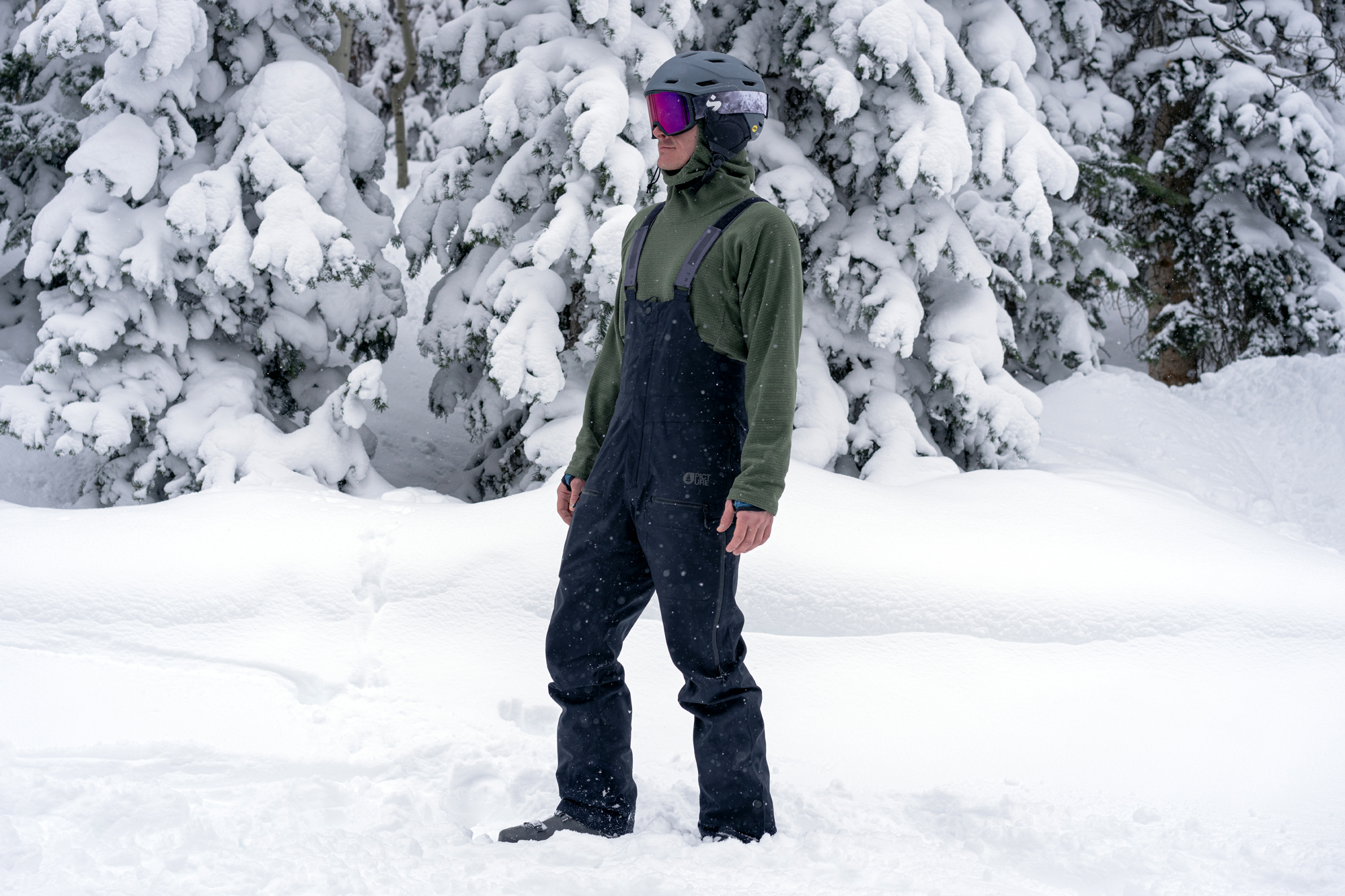
How We Tested the Best Men’s Ski and Snowboard Bibs
The GearJunkie team has tested various men’s ski and snowboard bibs over many winters at the resort and in the backcountry. From icy midwestern slopes to deep Rocky Mountain pow and mountaineering expeditions in Swedish Lapland, we’ve worn snow bibs just about everywhere.
Our Expert Testers
Lead author and tester Eric Phillips likes finding the deep stuff and has tested a vast variety of bibs over many winters at the resort and in the backcountry, as well as while serving on Crested Butte Search & Rescue. From deep and cold powder days to hot and sunny spring days, he has used these bibs for skiing, snowboarding, backcountry snowmobiling, bootpacking, search and rescue missions, bonfires, and après.
Recent contributors include California-based writer Sean Galaway and Colorado-based snow expert Justin Park. In the winter, GearJunkie Assistant Ski Editor Will Brendza slides on two sticks as much as possible. As a lifelong skier, he’s unafraid to take on-the-bench bibs into a blizzard, inbounds, or in the backcountry.
Another significant field tester and contributor to this guide is Drew Zieff, based in Tahoe City, California. Athlete Will Martinez tested men’s ski bibs in the 2022-2023 season. Contributor Mike Misselwitz tested men’s ski bibs in Seattle, Washington. Gear tester Austin Beck-Doss originally authored this guide in 2022.
This guide has been updated seven times as of fall 2025.
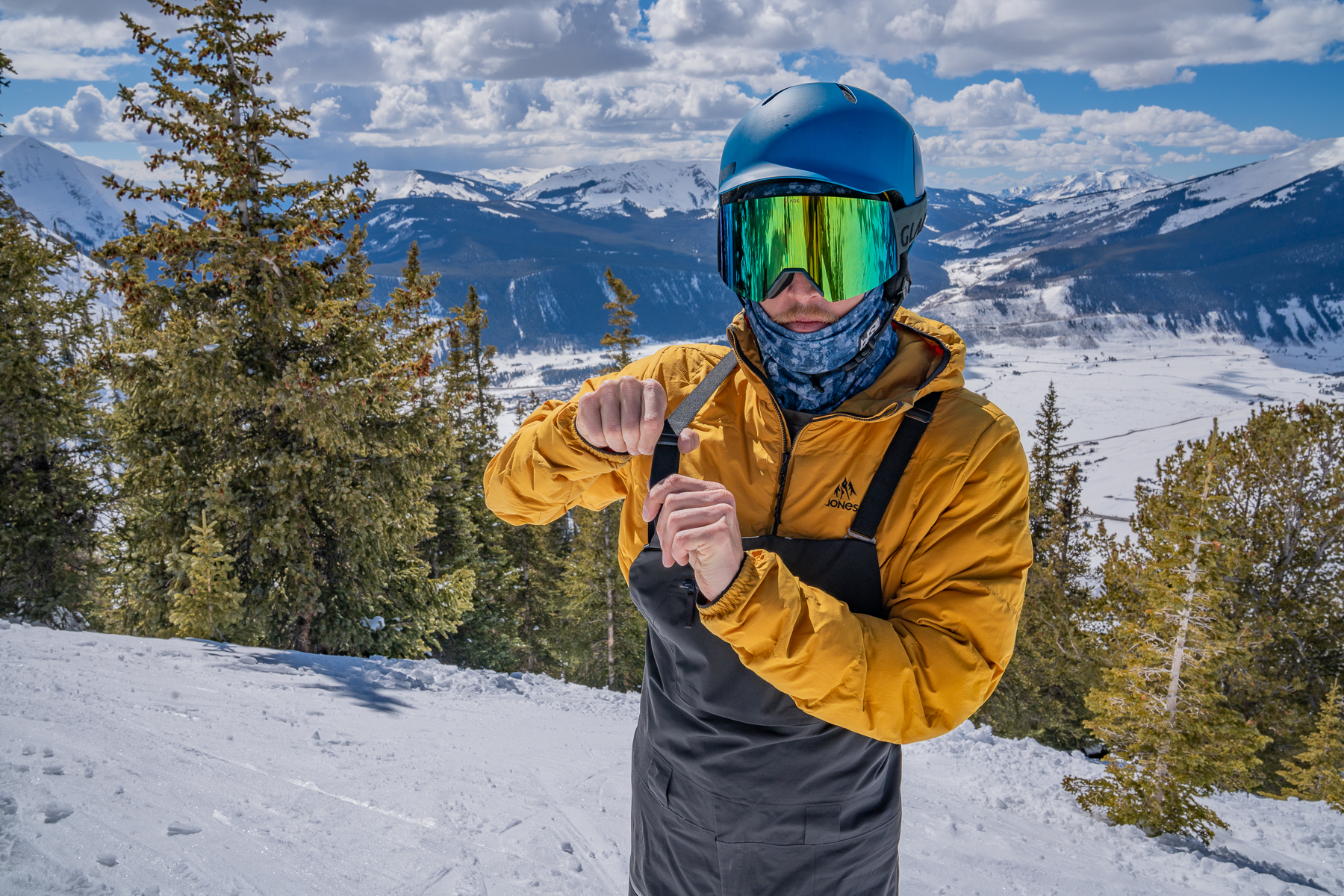
Our Testing Grounds
With a home base in Crested Butte, Colo., Phillips tests ski bibs in the coldest temps, harshest winds, and deepest snow in Colorado and the Lower 48.
Zieff, who is based in California, travels the world with his snowboard-testing gear — from Alaska to Japan and even the Arctic Circle. Beck-Doss lives in Wyoming, Brendza and Martinez and Park are based in Colorado, and Galaway hails from California.
In spring 2022 and 2023, Crested Butte Mountain Resort was the host location for the official GearJunkie Ski and Snowboard week, where our team meets to test upcoming hard goods and soft goods.
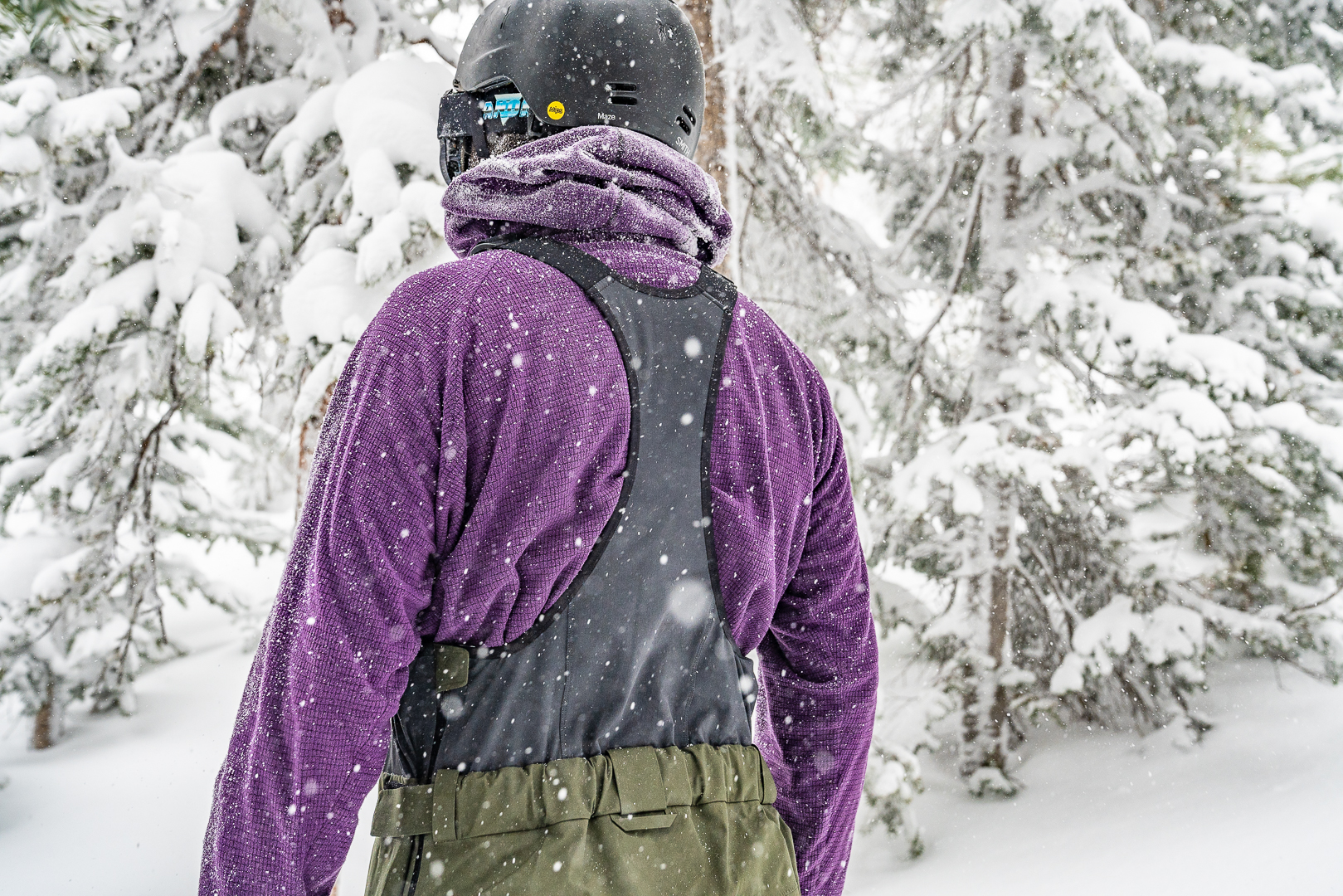
Our Testing Process
We carefully assessed these men’s ski and snowboard bibs for quality, value, sustainability, and long-term durability. Throughout the process, we noted the fit, suspenders, drop seat, ventilation zippers, pockets, backcountry compatibility, cuffs, material hand feel, noise, density, belt loops, stretch, and adjustability. It was important to compare each pair’s use in the backcountry and resort.
Some of our testers have used their choice of snow bib for many years with no signs of wear or a desire to switch. Beyond our team’s experience, we considered the market’s most popular, innovative, and acclaimed snow bibs and a broad range of price points, applications, and styles.
We’re confident this list includes the best men’s ski and snowboard bibs available today. We’ll update the list as new models hit the market and more field notes spill in.
Our team has field-tested and evaluated every pair of bibs on this list.
Our Men’s Ski Bibs Rating System
We score each men’s ski bib on a 1–10 scale for Waterproofing and Breathability, Fit and Mobility, Drop Seat and Fly Access, and Pockets.
A variety of waterproof membranes and textiles exist offering a range of protection against moisture. We test the fabric in heavy or wet snow conditions, watching for wetting out. Breathability decreases when waterproofing increases, in general, but pricier fabrics achieve higher breathability. We examine how the fabric’s breathability serves us while uphilling, in the spring, or romping on powder days.
Each silhouette has a different style and cut, which influences the fit and mobility. We look for bibs with a variety of sizes and inseam lengths, as well as stretch throughout the fabric and seams. We need hems that are compatible with ski and snowboard boots, especially with the rise of BOA dials. We search for suspenders that are comfortable and easy to adjust. We need fits that move with and don’t restrict the body.
Pockets are arguably the best detail on bibs. We inspect how functional, comfortable, and intelligent the pockets are, as well as the quantity and quality. We also assess the marketing and approach of beacon compatibility, which is a controversial topic.
In our opinion, a solid bib should have both a drop seat and fly access for bathroom breaks. We check out each bib’s design and ease of use.
The Overall Rating is based on contextual, editorial judgment, and the complex user experience across various scenarios and conditions.
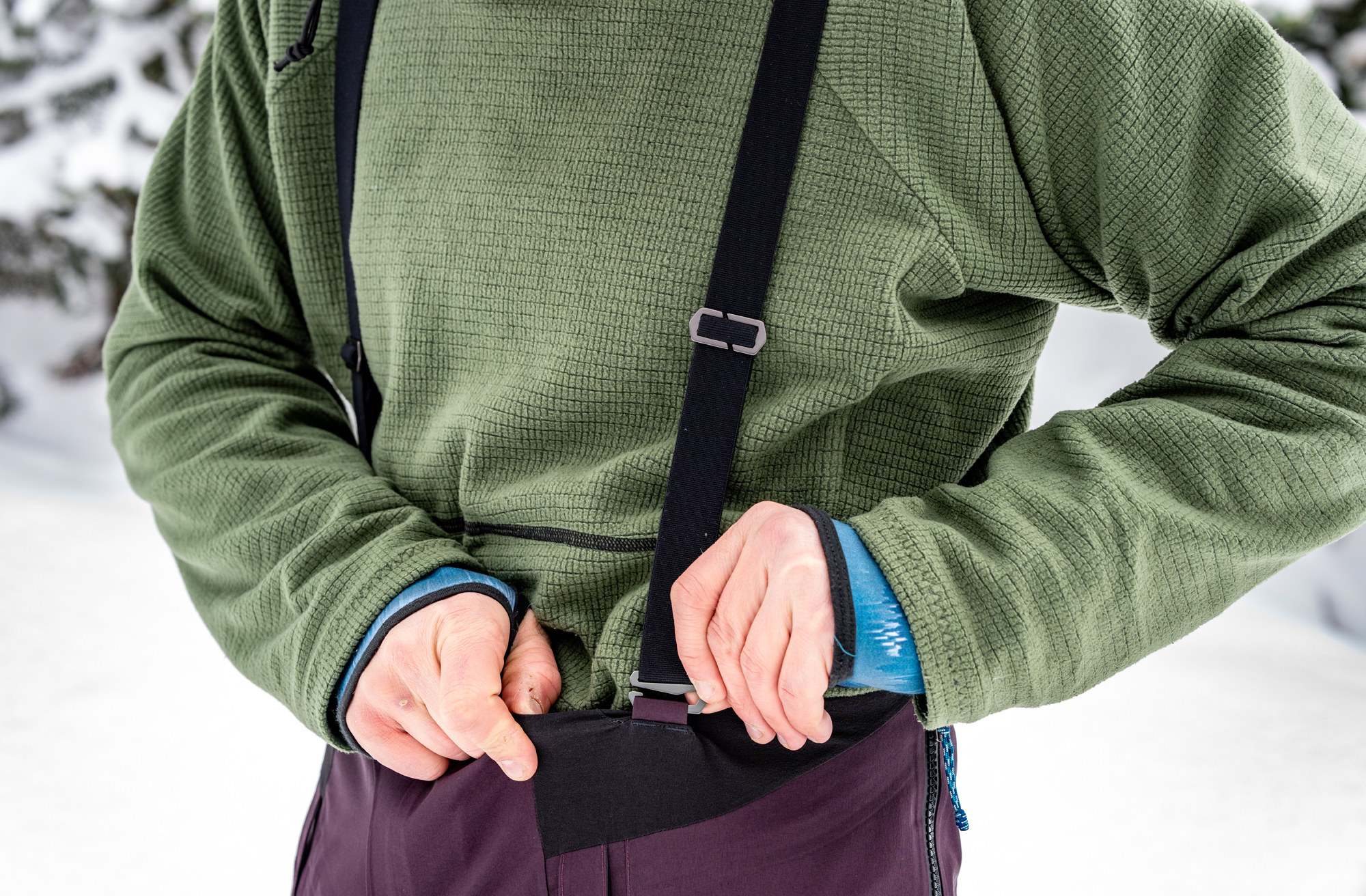
Buyer’s Guide: How to Choose the Best Men’s Ski Bibs
Ski bibs come in many different styles and cuts, including various chest heights, insulation, number of pockets, fixed versus removable suspenders, and the cut: baggier freeride or athletic and fitted. Ski bibs have a leg up on ski pants for a few reasons.
Reasons to Try Snow Bibs
Other than adding more grams to your kit, a handful of pros come along with swapping out pants for bibs:
- Defense against the deep stuff: Forget a powder skirt — the upper section of your bibs will keep out unwanted snow whether you’re breaking trail through thigh-deep pow, digging a pit, or choking on face shots.
- Pockets galore: With additional real estate on the chest, bibs tend to have more pockets than your average backcountry ski pants.
- No belt needed: Ditch the belt and rely on suspenders for a more comfortable stride on the skin track. (Or, add a belt to create an extra kangaroo pouch.)
- Backpack compatibility: In the backcountry, you wear a backpack. We’ve found that bibs are more compatible with fully loaded airbags than ski pants, as the pack’s hip belt can rub on the beltline, causing discomfort and making ski pants sag.
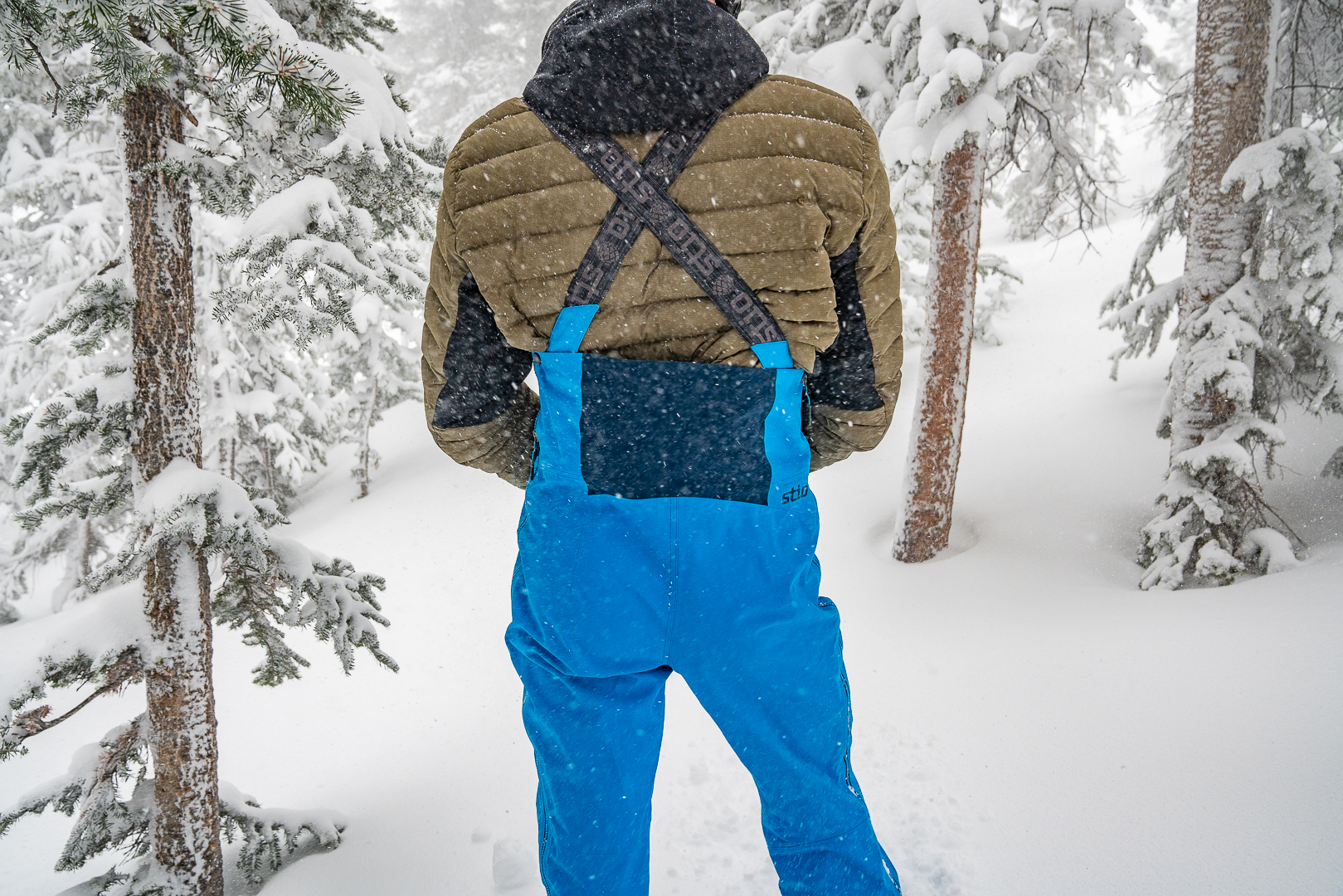
How to Layer: Ski Bibs
Base Layer
Most men’s ski bibs come without insulation, a.k.a. shells. These bibs work best by layering a base layer underneath. When it’s cold out — like if it’s well below freezing at the ski resort — you might also add a midlayer like puffy pants. These layers underneath a ski bib are essential for the best comfort, sweat-wicking power, and warmth.
Outer Layer
An uninsulated shell or an insulated ski jacket should be worn outside your bibs. You could add a puffy over or under the bib and beneath a shell jacket for freezing days. Generally, a down coat will reflect heat faster if it’s below your bib and closer to your body.
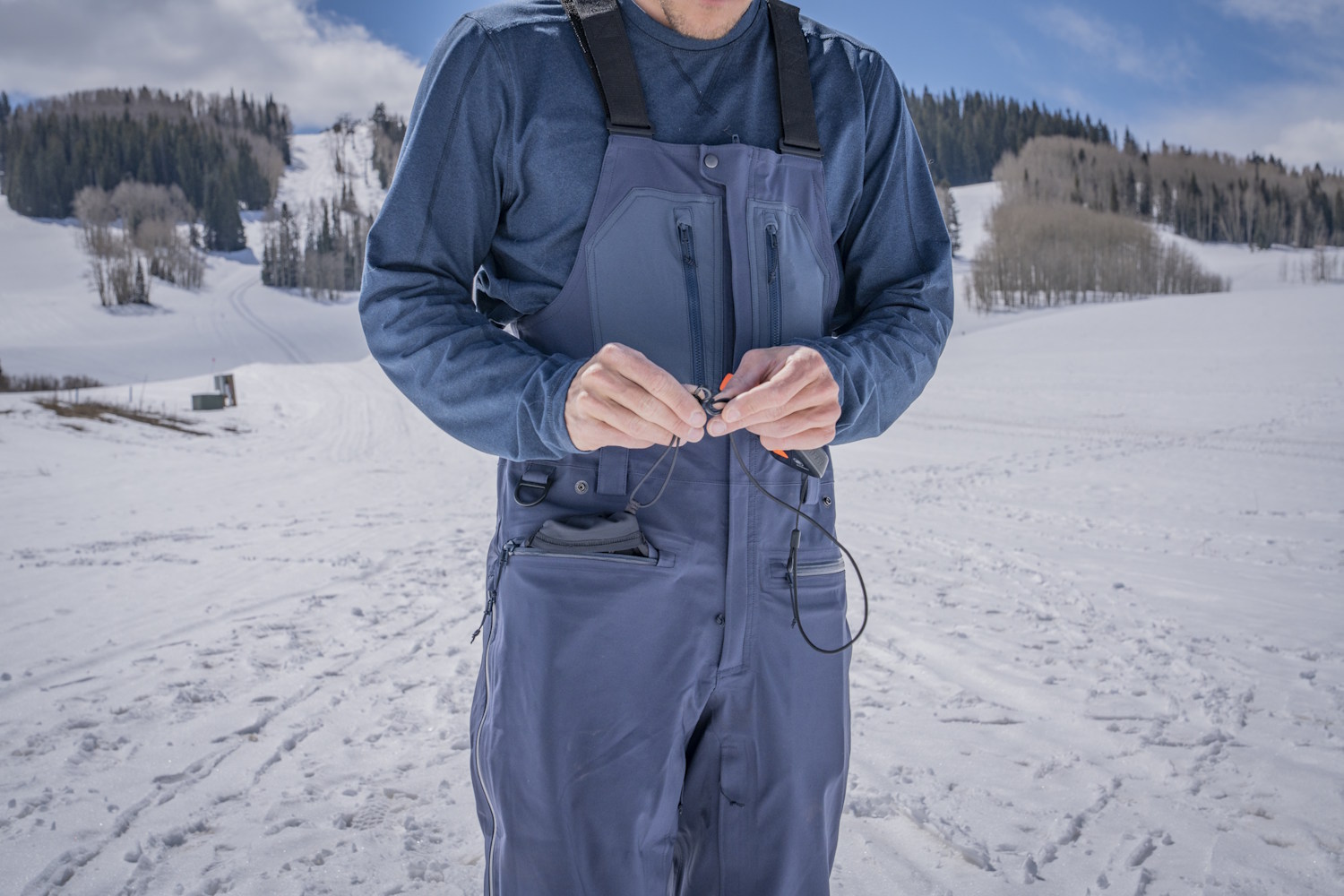
Avalanche Safety Gear: How to Wear Your Beacon
If you’re going into the backcountry, ensure your avalanche transceiver, a.k.a. beacon, is quickly accessible and far away from your other electronics, such as a phone and radio. According to the Utah Avalanche Center, you want your beacon 20 cm (8 inches) away from other electronics while transmitting and 50 cm (20 inches) away from electronics when it’s in search mode.
Designers typically place pockets on bibs on the thigh, chest, or midsection to fit large electronic devices. For some skiers, bib pockets are often more comfortable and easier to use for beacons than a harness. Certain beacons are compact enough to fit in an internal pocket and include a tether attachment system; some internal bib pockets have zippered closures and integrated lanyards or tethers.
However, nearly all avalanche transceiver manufacturers recommend wearing the beacon with the supplied chest harness. The harness system is designed to protect the display, prevent accidental mode switching, and release the system while keeping the beacon attached to the person. A harness keeps the beacon on the body and close to the airway.
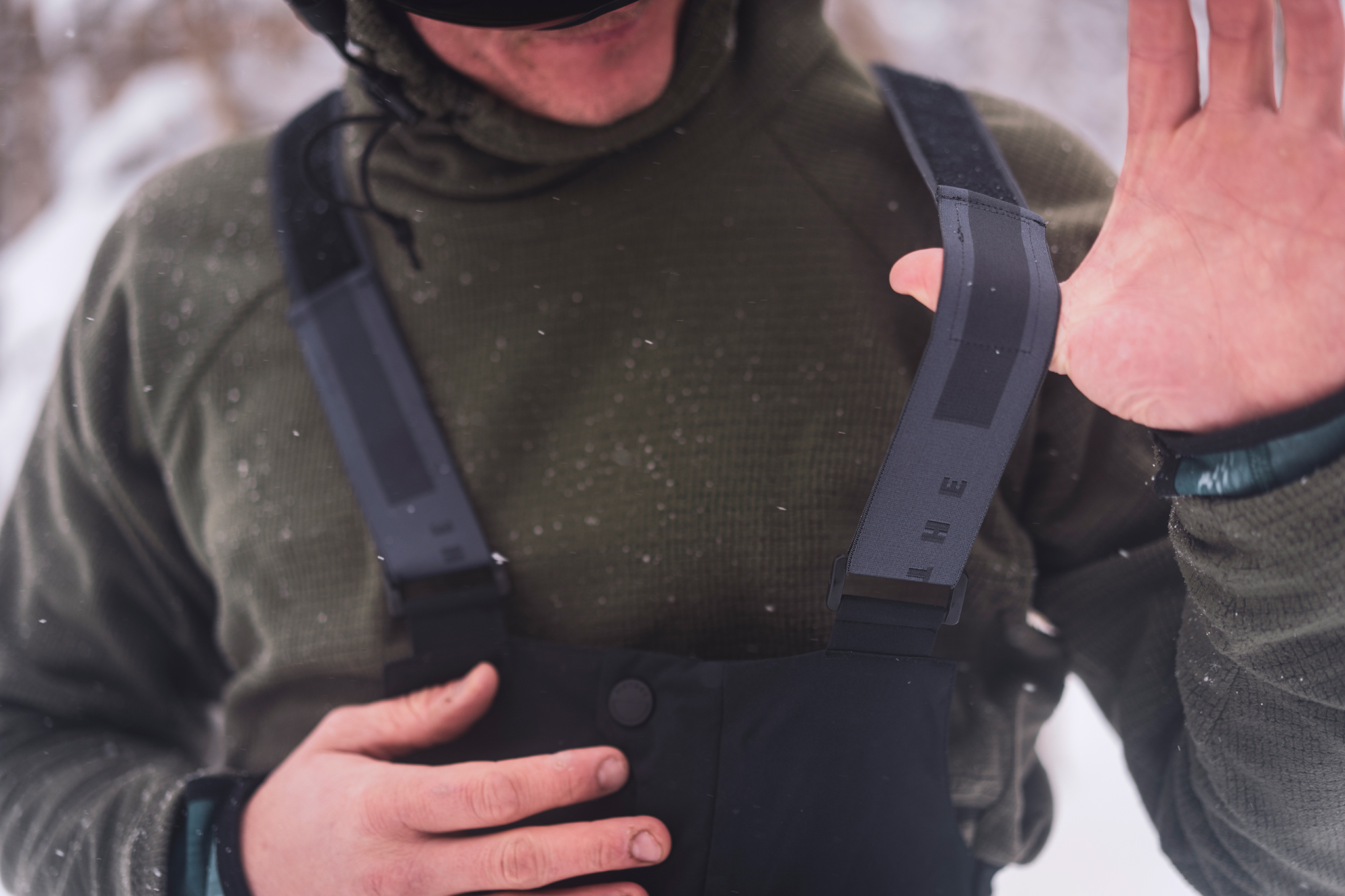
Resort vs. Backcountry Ski Bibs
Riders can wear many ski bibs at the resort and in the backcountry, but not all manufacturers build them to function fully for ski tours. Backcountry-built bibs are often pricier, and you might not need to sacrifice the bills for a simpler design that suits your resort needs.
Stylistically, baggier and freeride options might feel like more of a nuisance while moving uphill and beneath a pack’s hip belt.
Drop Seat, Insulation, Vents
While insulated bibs can be clutch in-bounds, we don’t recommend wearing fixed insulation for tours. You’ll want leg vents.
Not all leg vents double as a drop seat for bathroom breaks. For tours, you’ll want to choose a pair of bibs with a generous exterior zip for opening the back door.
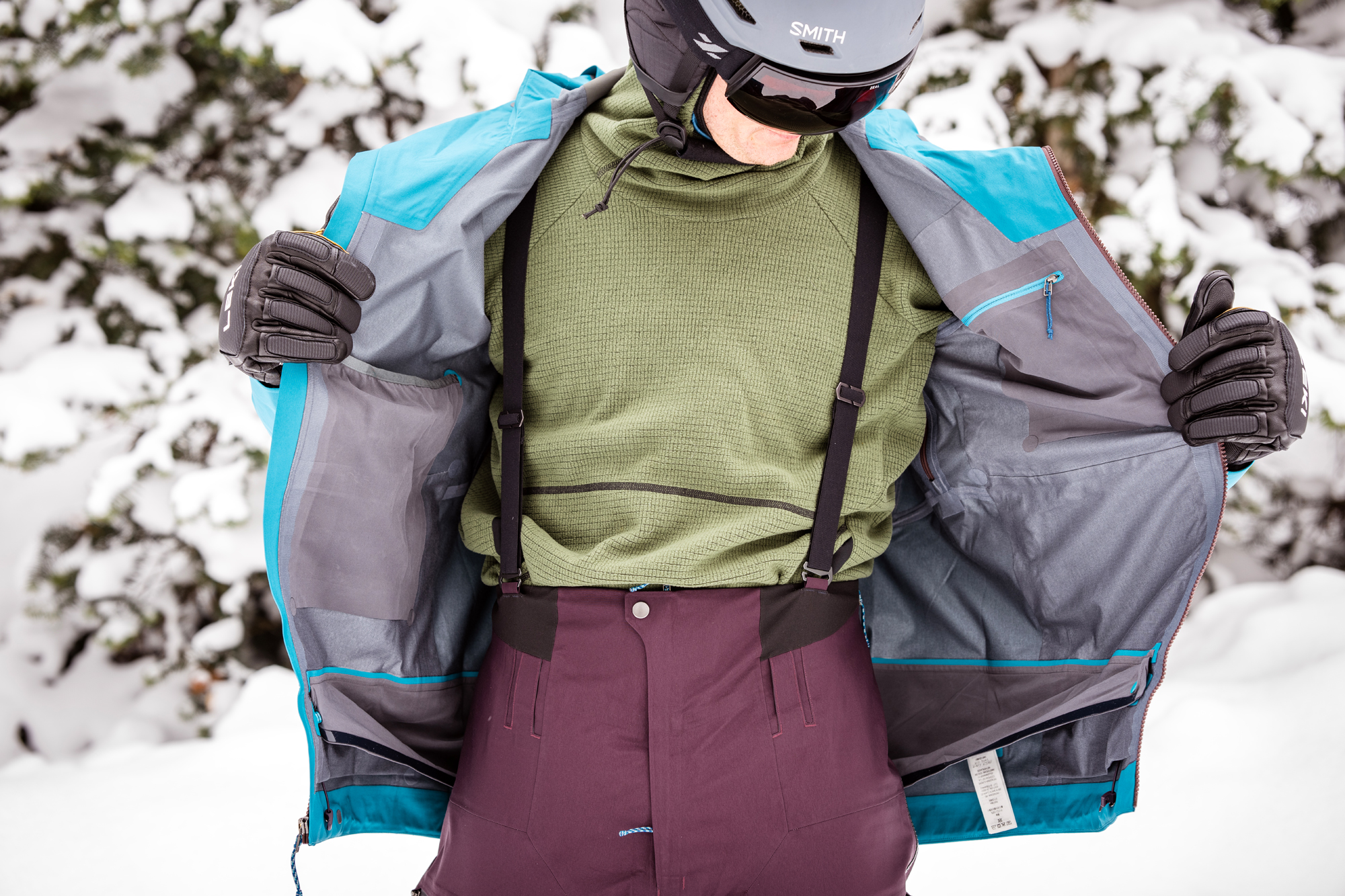
Waterproofness & Breathability
Since you won’t have the option to duck indoors, your bibs will face constant exposure to the elements, so look for high waterproofing and, if needed, windproofing.
Generally, backcountry-focused bibs are more breathable due to the fabric and breathable inserts. You’ll be building heat and breaking a sweat up the skin track, so they’re usually made with a lighter textile.
In comparison, if you ride the resort in mellow weather or infrequently, it’s acceptable to wear bibs with 10K/10K waterproofness/breathability. The North Face Freedom Bibs are great for resort days.
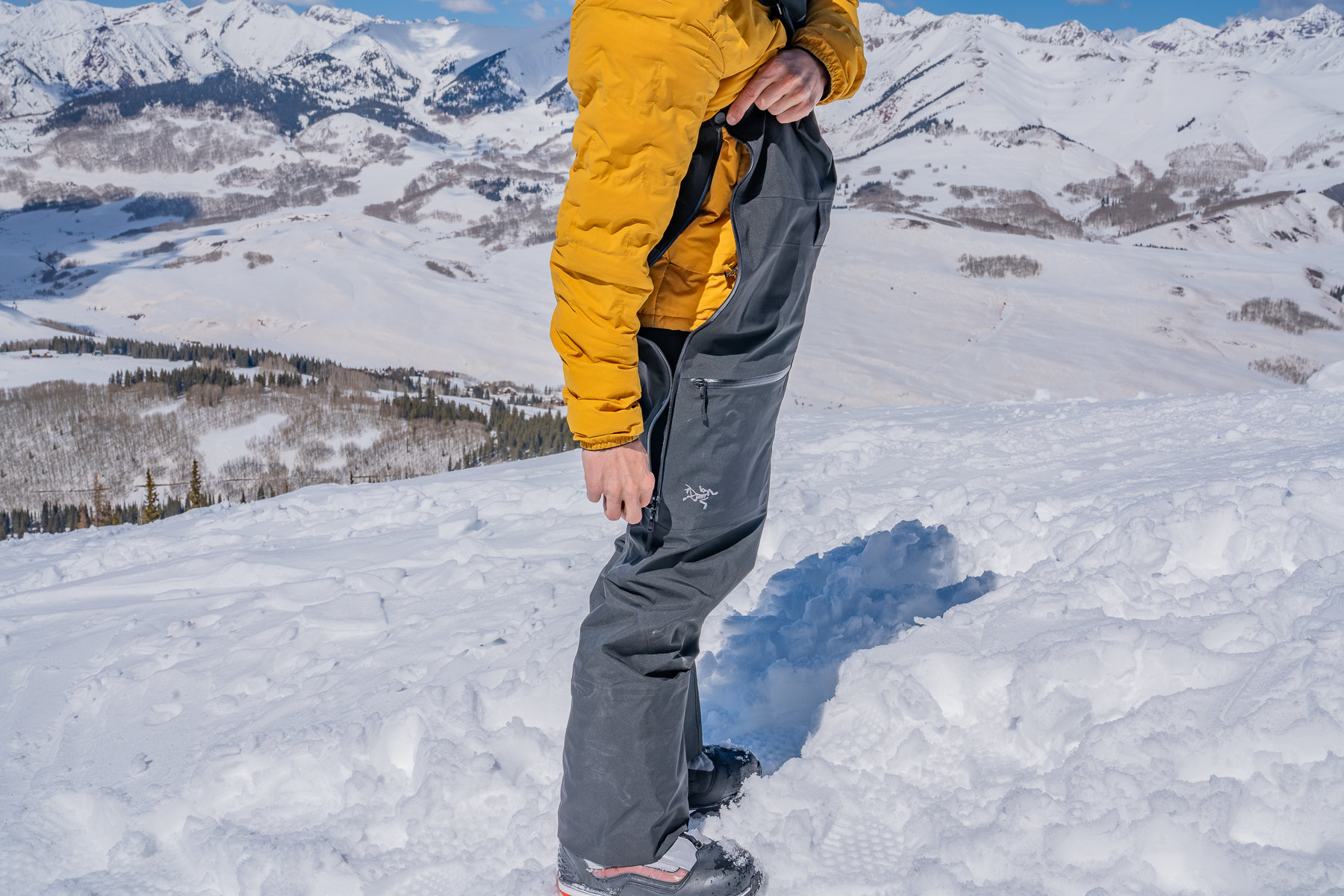
Durability
Backcountry bibs are typically more durable, which is why they are more expensive. The lower interior legs and hems are reinforced with tenacious material to prevent being cut or worn down by ski edges during kick turns or crampons while booting up a face.
Storage & Avalanche Beacon
You’ll be utilizing the pockets on your bibs to stash essentials, even if you need to shed your jacket on the uptrack. Look for various pocket options to hold a phone at an appropriate distance from your beacon.
While we have not found a beacon manufacturer or third-party verifier, some brands construct beacon-specific pockets for bibs that isolate the beacon in a zippered pocket with an internal attachment system, like in the Outdoor Research Hemispheres II GORE-TEX Bibs, which thrive in the backcountry.
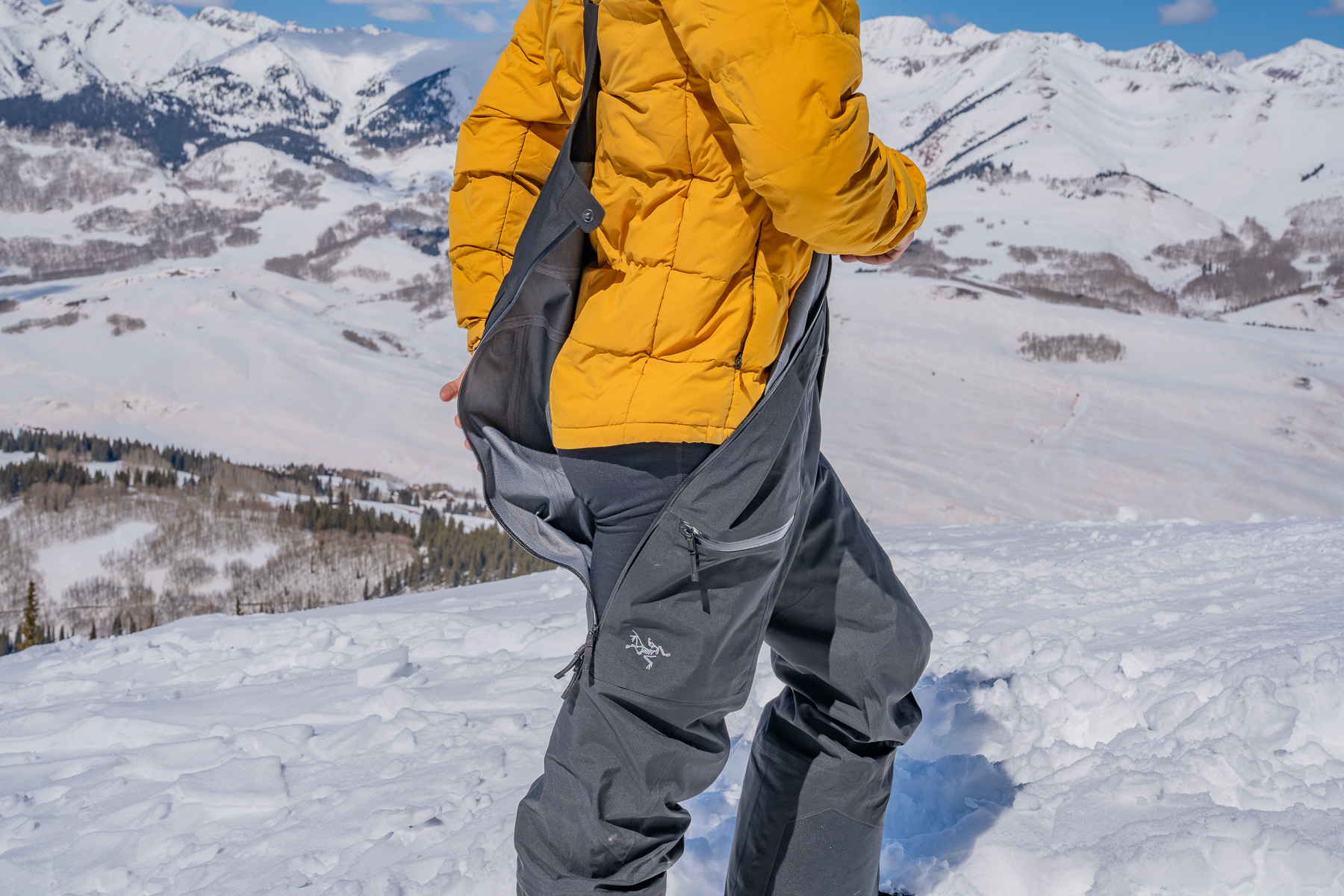
Drop Seat: Easy Bathroom Breaks
Using the bathroom in the backcountry — or frontcountry, for that matter — can be challenging with bibs on. Fortunately, ski bibs have that figured out with the drop seat and a front fly. You don’t need to take off your jacket in a stuffy stall to pull down your snow bibs to relieve yourself.
Instead, you snug up your jacket, pull the side or back zipper down or around, and the fabric on the back of the bib will ‘drop away.’ Then you can take a seat and follow your routine. Most bibs have a separate front zipper fly for business number one.
Drop seat designs vary from brand to brand. For instance, the drop seat on the Patagonia SnowDrifter Bibs allows you to unzip both sides of the drop seat, so you can choose the side that works for you or zip down both for extra range. Other drop seats have side zippers that reach super far down the leg to offer an even larger opening, like on the TREW TREWth Primo Bib, which can be convenient for variable terrain in the backcountry.
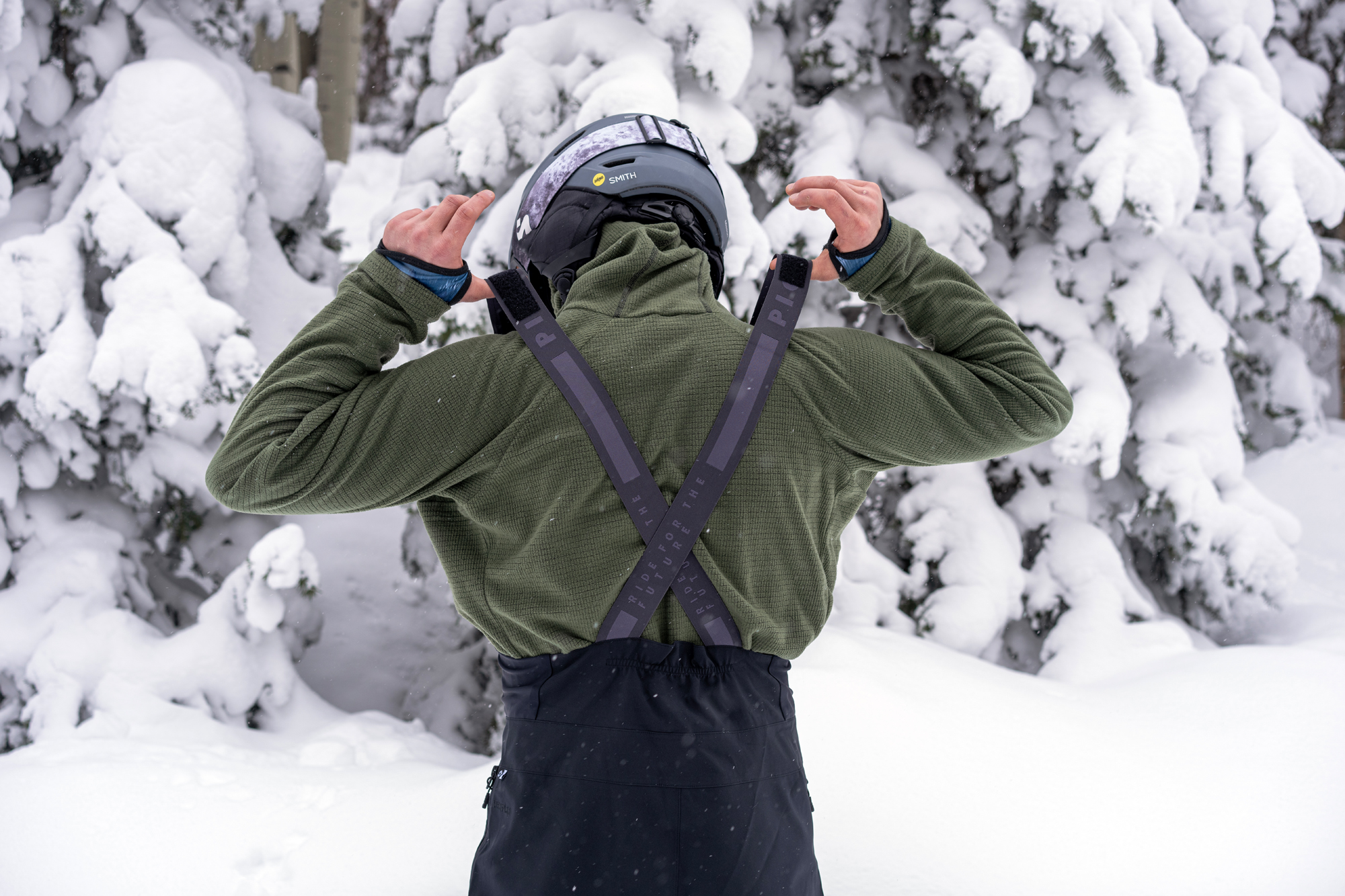
Waterproofness: How Much Do You Need?
The waterproofness level of your ski bibs is essential.
A snow bib with 30,000 to 20,000mm of waterproofness will be supreme for the Pacific Northwest and other coastal areas. A 10,000mm level of waterproofness is a good choice for climates with dryer and less snowfall or folks that usually ride on sunny days—the less waterproofing, the smaller the bill.
The snow water equivalent — the amount of liquid water in the snow — differs depending on where you ski across the country. Often shared as millimeters, the waterproofness rating is based on the amount of water the fabric can withstand before being soaked through when a 1-inch diameter of the fabric is stretched tight for 24 hours.
Four snow climates exist in the United States: coastal, transitional, intermountain, and continental. The closer to the coast you are, the higher the water content in the snow, meaning it’ll be wetter and heavier.
Snow in continental climates is dryer, lighter, and accumulates less compared to the coast. That includes most of the Rocky Mountains, such as in Colorado. Intermountain regions and ranges show characteristics of both. Transitional areas are similar to the coast but with less rain and snow.
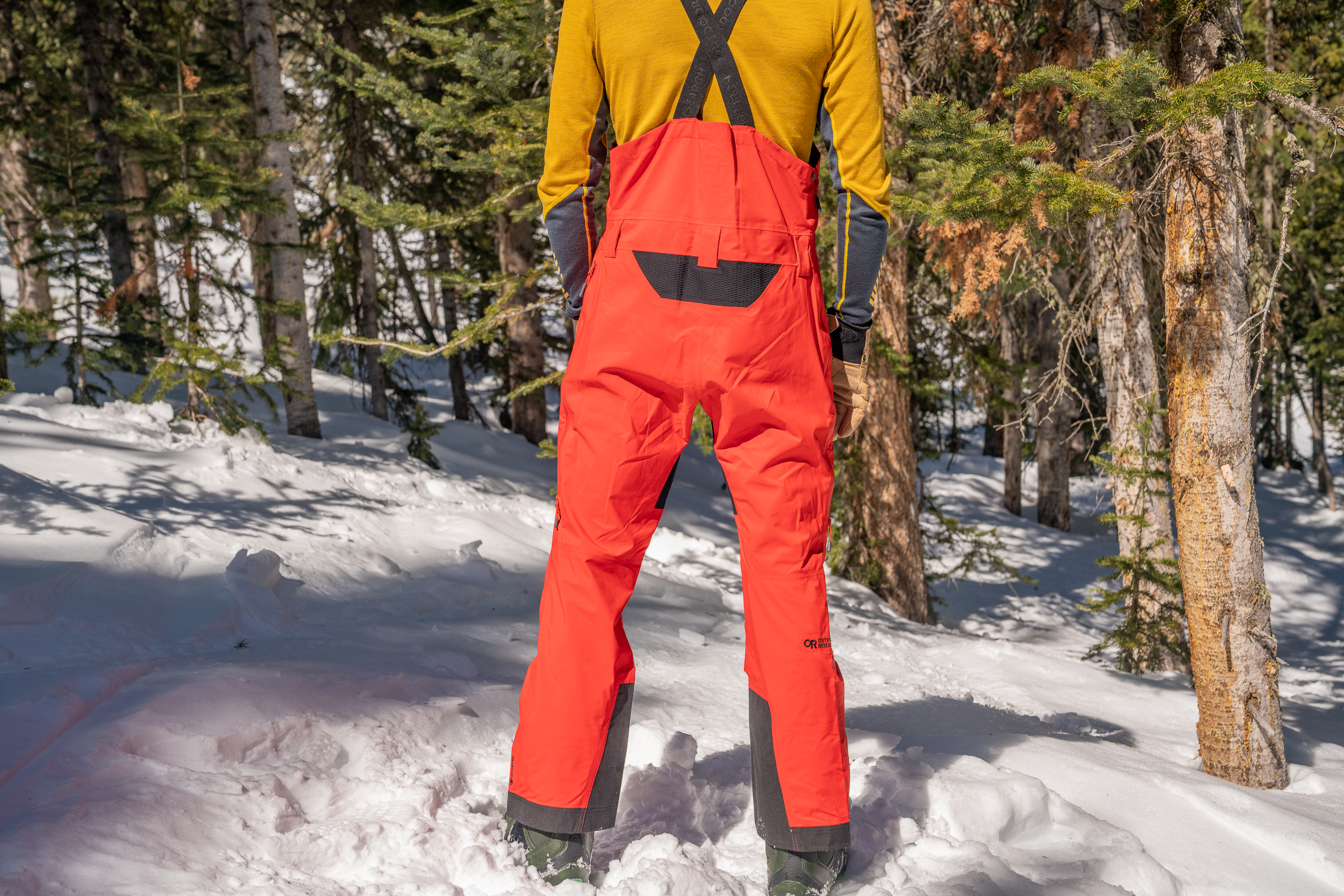
Breathability: Key for the Backcountry
Usually, a second metric is displayed next to the waterproofness: The fabric’s level of breathability. The metric is based on how many grams of water vapor can pass through a square meter of fabric, from the interior to the exterior, in 24 hours.
Breathability tends to be most important for ski tourers, who want a breathability rating of 20K or more.
Here are the waterproofness and breathability levels of our selected men’s ski bibs:
- Jones Shralpinist Recycled GORE-TEX ePE Bibs: 28K/20K
- Flylow Gear Baker Bib: 20K/20K
- TREW Gear TREWth Primo Bib: 20K/20K
- Patagonia Untracked Bib: 20K/20K
- Jones Men’s MTN Surf Recycled Bibs: 20K/20K
- Patagonia SnowDrifter Bib: 20K/20K
- Picture Welcome Bibs: 20K/20K
- Stio Men’s Figment Bib: 20K/10K
- Outdoor Research Hemispheres II GORE-TEX Bibs: 10K/20K
- The North Face Freedom Bib: Unavailable
- REI Co-op First Chair GTX Bibs: Unavailable
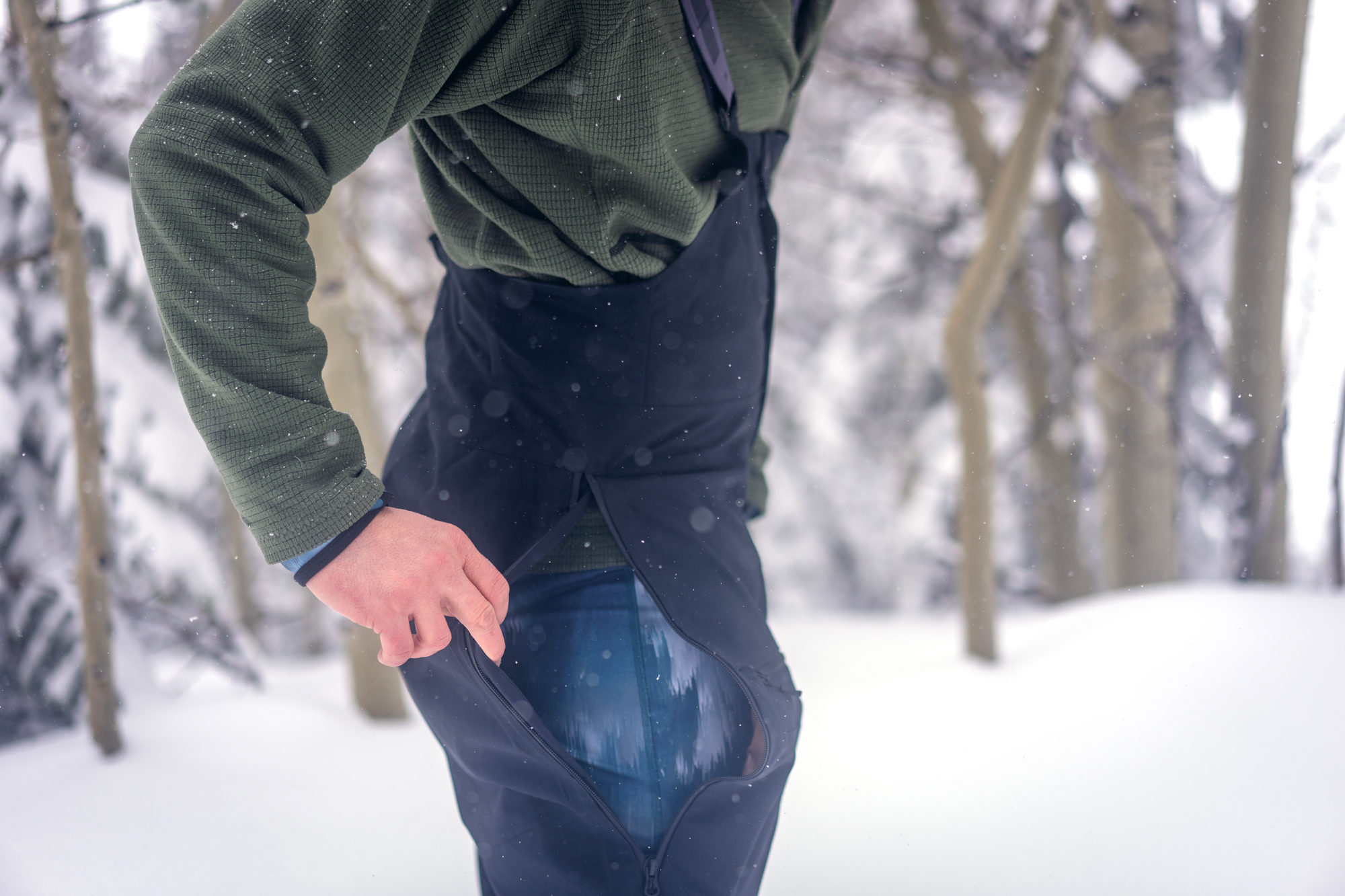
Chemical-Free Waterproofness
Manufacturers traditionally applied various chemical treatments to the exterior face to add water resistance. The treatment changed the surface texture and allowed water to collect in beads that rolled away.
Over the past year, most manufacturers have debuted snow bibs with PFC-free DWR and construction. The only product with PFCs on our list is the Outdoor Research Hemispheres II GORE-TEX Bibs.
Many brands partner with GORE-TEX to utilize 2-layer and 3-layer recycled fabrics that are free of PFCs (per- and polyfluorinated chemicals), membranes, and DWR.
GORE-TEX alternatives exist, too. Options include Oyuki’s proprietary YamaPro fabric, which uses a C0 DWR treatment, Montec’s Shield-Tec textile, and Stio’s PeakProof. The Picture Welcome bibs use Teflon Ecoelite PFC-free DWR and DryPlay PU membrane (non-fluorinated) in its in-house circular fabric.
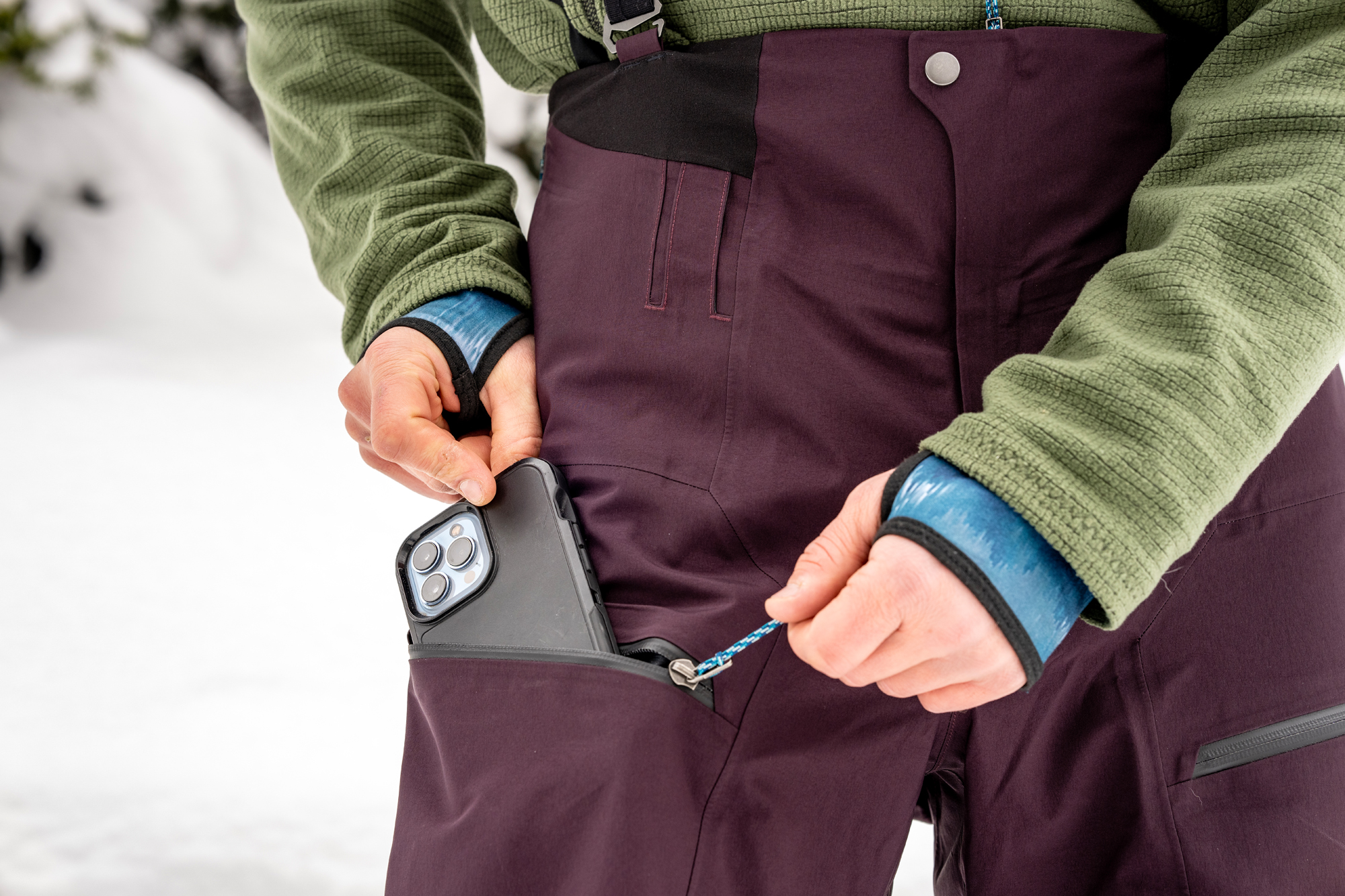
Leg Ventilation
We highly recommend choosing bibs with ventilation zippers. Manufacturers place them alongside each leg on the exterior, interior, or both. The zippers are one-way or two-way.
A two-way zipper has two zip pulls, like the one used on the Outdoor Research Hemispheres II GORE-TEX Bibs. The teeth can remain latched at the top while the other slider opens the lower portion, creating a window to draw in air.
Very few zippers are fully waterproof. Inside the zipper, you sometimes have a mesh liner for skin protection against sun or snow flurries. Other brands opt for no mesh because it can get snagged in zipper teeth.
The length of leg zippers varies from bib to bib, as does the size of the pull. We tend to dig longer zippers, which provide a larger drop seat or vent. Bigger zipper pulls are easier to grab with gloved hands.
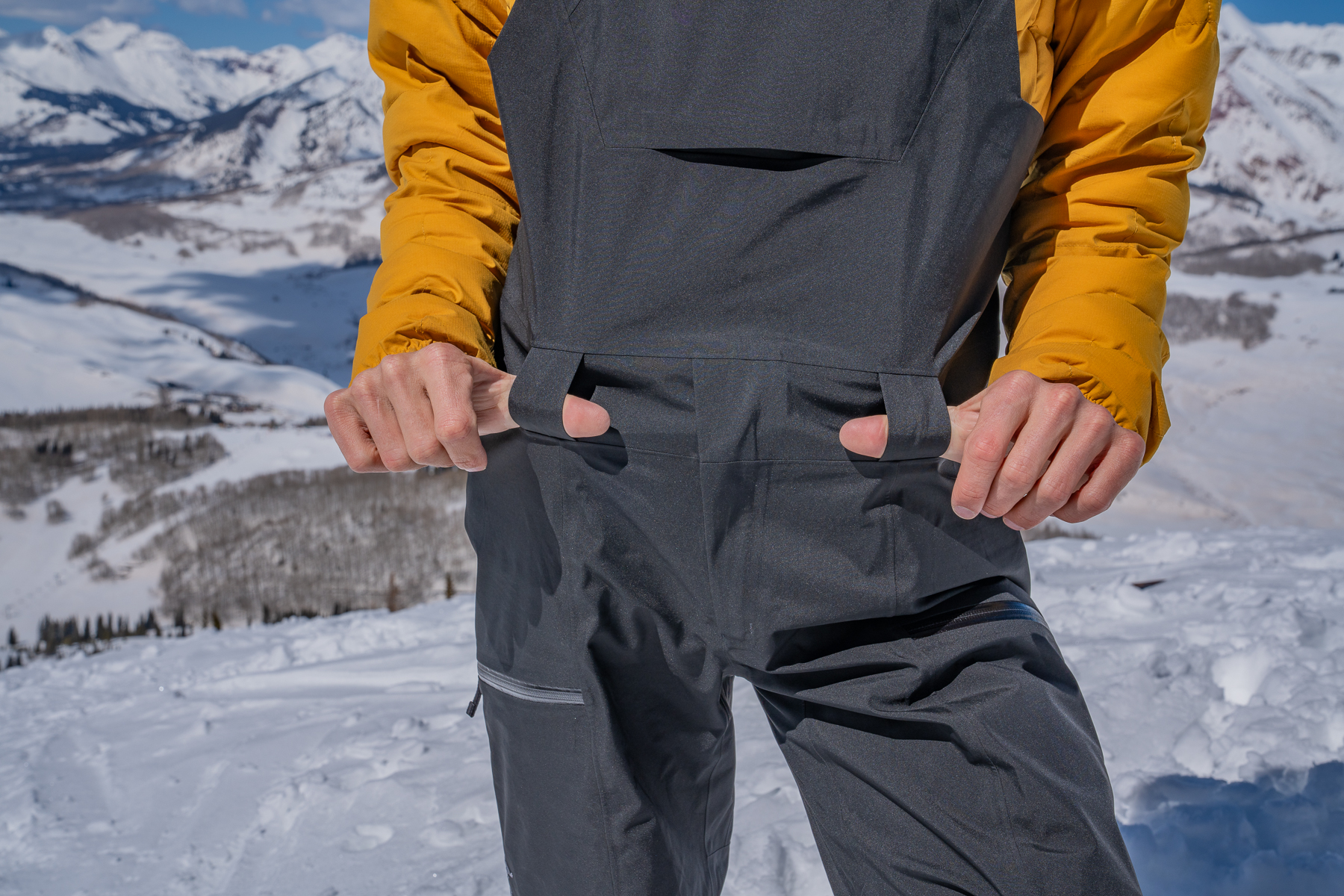
Bib Straps & Belt Loops
One of the most convenient parts of men’s ski bibs is the shoulder straps, which hold up your pants instead of relying on a waist belt. Belts are one thing when skiing at the resort, but when you’re touring in the backcountry, they can be a literal pain. Ditch the belt and rely on suspenders for a more comfortable stride on the skintrack.
Straps allow you to raise and lower the bibs on your torso. Most of the time, this comes from a plastic slider buckle on the elastic shoulder strap. But the Picture Welcome 3L Bib has a Velcro strap adjustment, which also lets you release the suspender from the front for easy entry. The width and density of the shoulder straps are unique from one bib to the next.
Some straps lie straight over the shoulders, like the Jones Shralpinist Recycled GORE-TEX ePE Bibs, while others cross in the back like the Picture Welcome 3L Bib. Some manufacturers fix specific designs in place, while others make them removable.
That said, some men’s ski bibs, including the Outdoor Research Hemispheres II GORE-TEX Bibs, include belt loops. Some of our testers swear by loops, which they use to create a kangaroo pouch inside chest-high bibs for quickly stashing gloves or other small apparel pieces against the torso.
While the Stio Men’s Figment Bib lacks loops, it has a unique integrated belt with an adjustable slider. The Jones Snowboards Men’s MTN Surf Recycled Bibs have belt loops and an adjustable waist.
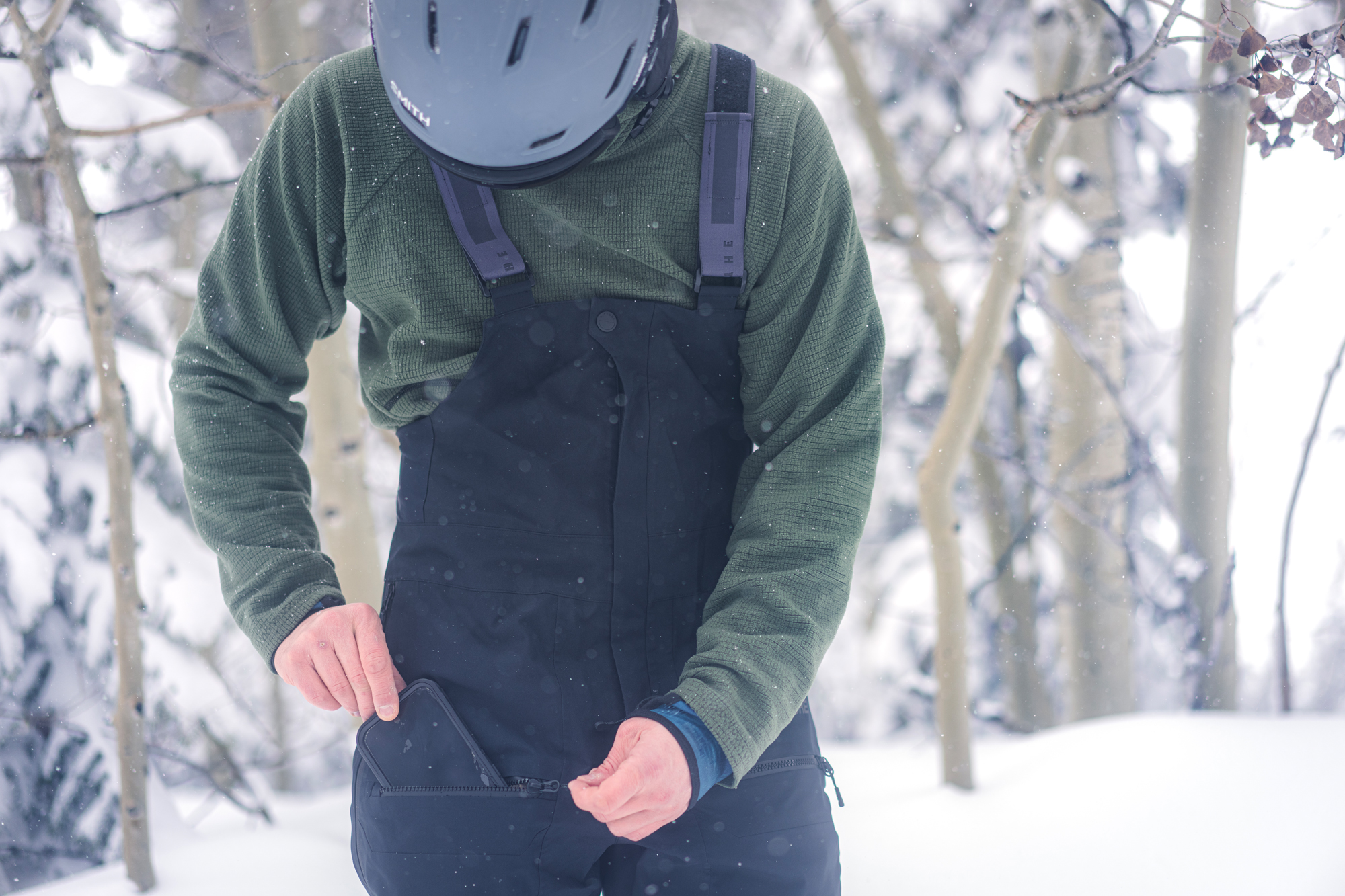
Pockets
On the low end, the REI Co-op First Chair GTX Bibs has two drop-in thigh pockets with a Velcro flap, and one has a zipper for extra security. At the mid-tier, the Outdoor Research Hemispheres II GORE-TEX Bibs has four pockets: two on the thighs and two on the chest. On the high end, the Flylow Gear Baker Bib offers seven pockets, including two hand, thigh, and chest, plus one on the backside.
Jones has a unique layered chest pocket in the Jones Snowboards Men’s MTN Surf Recycled Bibs. There’s an entry from the top and a second zipper on the side.
We wish more snow bibs had external d-rings for attaching gloves or a snowmobile key like the one on the waist of the REI Co-op First Chair GTX Bibs.
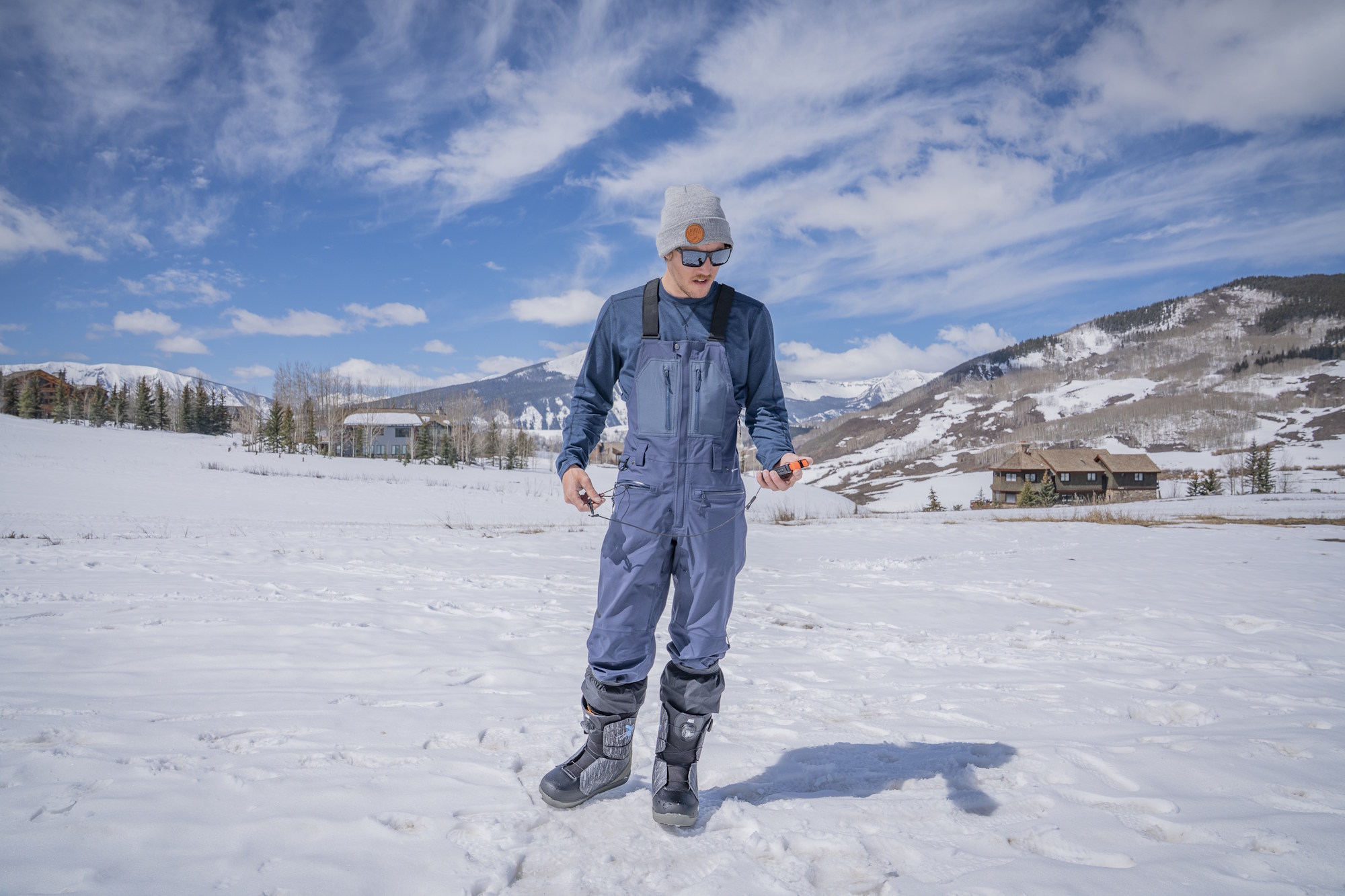
Beacon-Advertised Pockets: Potentially Risky to Use
The Outdoor Research Hemispheres II GORE-TEX Bibs has a unique off-centered chest pocket with an angled entry, zipper, and fixed tether point, which is brand-designated for beacon use.
While beacon manufacturers recommend using the included safety harness to hold your transceiver, some brands like O.R., Helly Hansen, and TREW label certain bib pockets as alternatives. Some critics pose that if the pocket is internal (versus external), keeps the beacon close to the body and airway, has a secure zipper, and has a robust internal attachment point, the beacon is less likely to be ripped off or broken in an accident.
However, the industry doesn’t have formal guidelines, a verification method, or a third-party verifier to confirm if snow bib pocket designs can adequately meet the safety benchmark of a beacon harness.
A beacon harness is padded, fixes the orientation (the antenna points vertically), keeps the screen facing the body, has a secondary retention leash, provides a body-hugging fit, places the beacon closer to the airway, and has reinforced stitching and buckles.
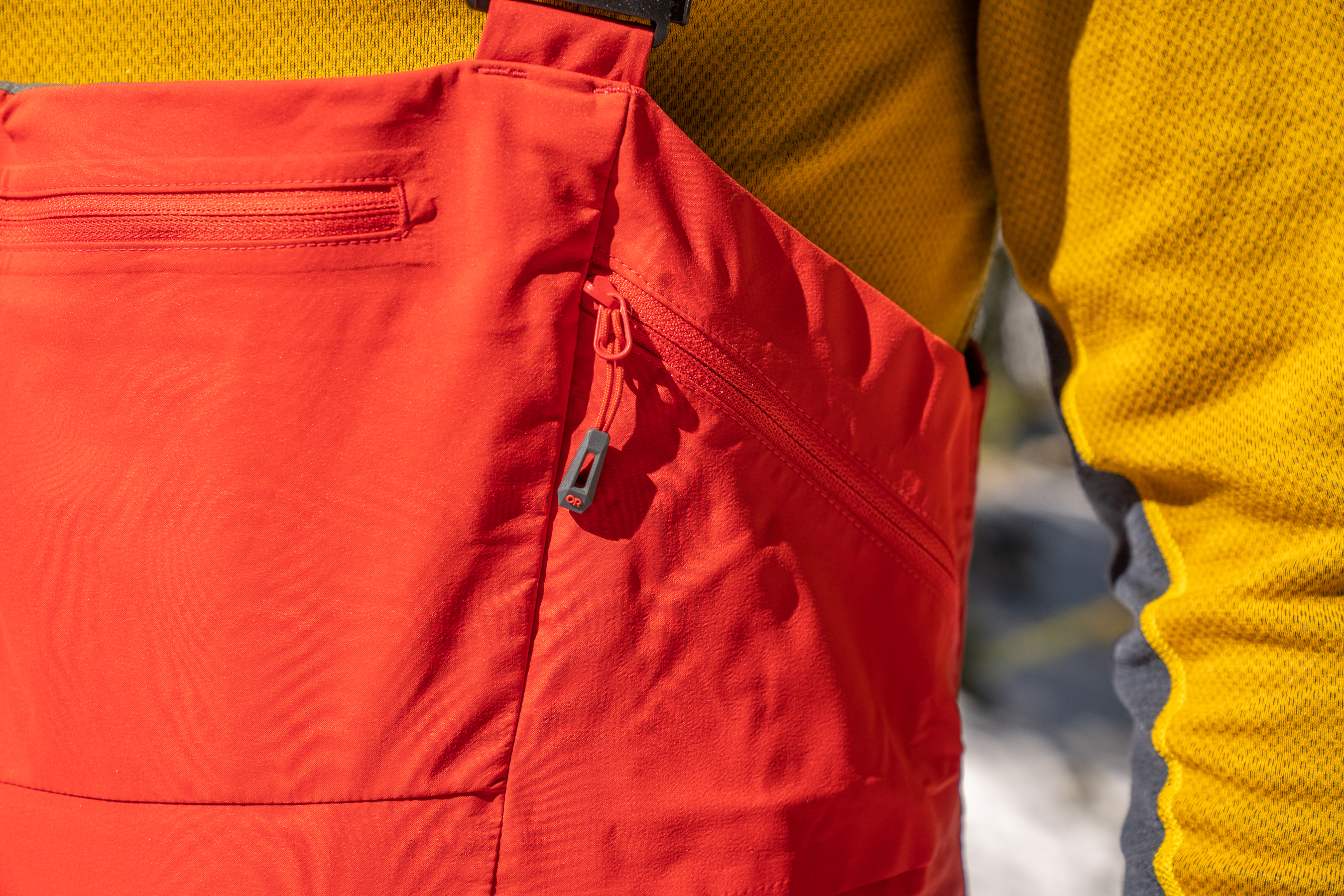
Fit: Style, Upper Bib & Inseam
Bib fit depends on your style and needs. Athletic cuts are more form-fitted, mountaineering-friendly, and ergonomic for ski tours, like the Jones Shralpinist Recycled GORE-TEX ePE Bibs. Chiefly, baggier freeride kits, such as the Stio Men’s Figment Bib, provide a wide range of motion. However, the extra material can add weight and bulk in the backcountry, so those bibs are typically better worn at the resort.
Snowboarders want a roomier torso because they constantly bend over to adjust bindings. Pant legs need a broader circumference to fit over snowboard boots, while ski boots are narrower.
Bibs that are too tight will chafe on the skin track. Designs with tapered, unobtrusive, and reinforced cuffs will go a long way, especially if you’re planning on wearing your bibs while using crampons. Voluminous pant legs can be downright dangerous in the backcountry and torn to shreds by crampon spikes or metal edges.
Extended Sizes & Plus Sizes
Don’t overlook the TREW Gear TREWth Primo Bib if you’re looking for extended sizes. TREW is one of the few brands to offer short and tall options, and they launched 3XL-5XL plus sizes (with short and tall iterations).
While they don’t offer plus sizes, the REI Co-op First Chair GTX Bibs deliver short and tall options up to XXL plus XXXL.
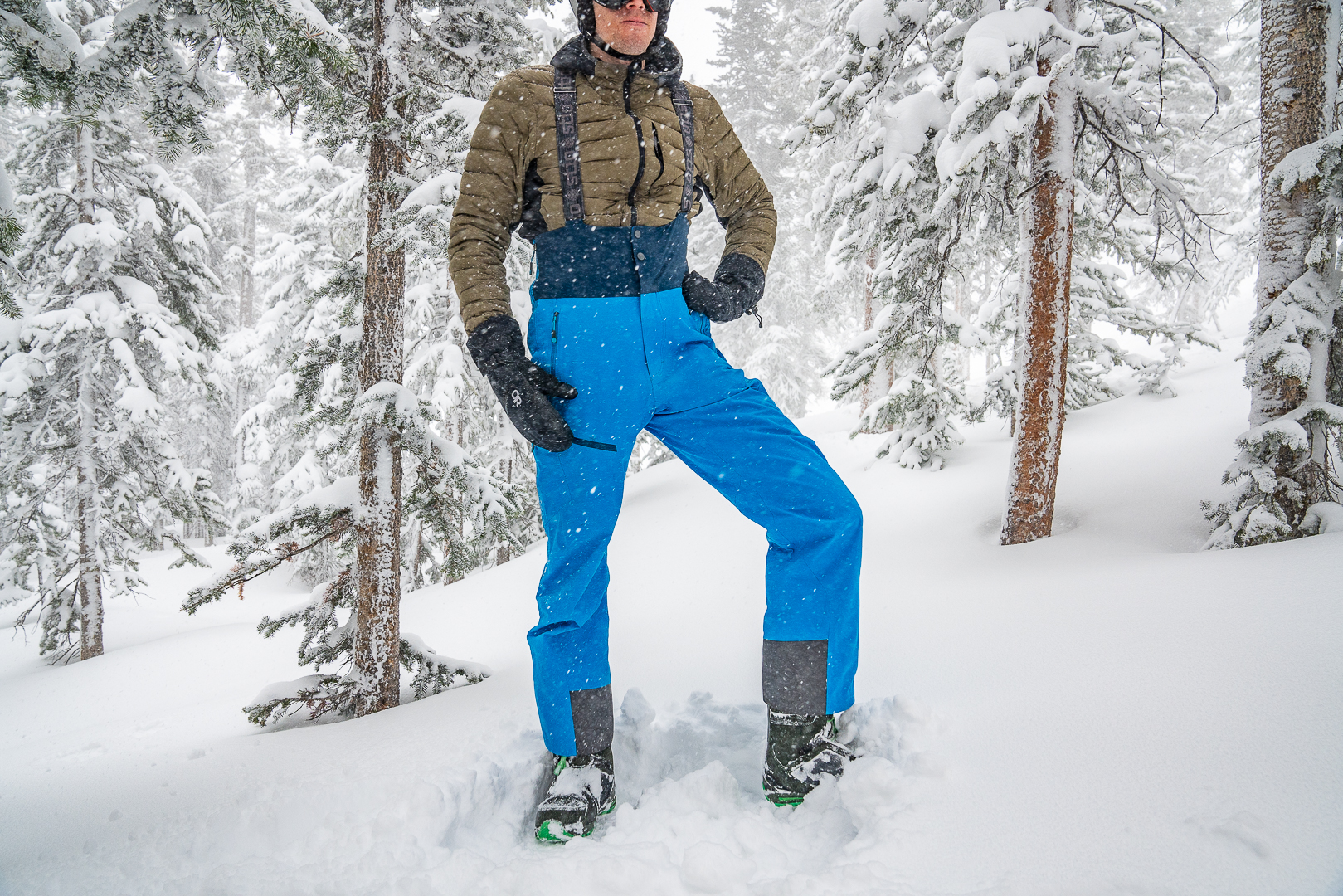
Reinforced Cuffs & Gaiters
At the bottom of the pant leg, narrower cuffs fit better over ski boots than snowboard boots. That’s especially true for larger boot sizes and silhouettes or those with a BOA system.
Some cuffs are adjustable with side zippers or snaps, which allow you to expand the circumference when you pull the pant leg down over your boots. If the pant leg is more fitted, we prefer that approach for snowboard boots.
Most cuffs are reinforced with materials like Kevlar or Cordura to help prevent the material from shredding over time or getting cut up by metal edges in the lift line or on tours. Fabric patches, called scuff guards, can help protect the lower pant leg from ski crampons.
To help keep the powder out, we recommend ski or snowboard bibs with internal gaiters that secure well over boots. Gaiters with boot adjustment access are also a plus, but are not common.

Sustainability
An increasing number of ski bibs have sustainable details like recycled materials, PFC-free water repellency and construction, and carbon offsets. Some brands meet third-party environmental and workplace health standards like the OEKO-TEX standard.
Recycled & Circular Textiles: Saving Waste From Landfill
Most bibs that dabble in recycled materials use a blend, but the Jones Shralpinist Recycled GORE-TEX ePE Bibs is made of 100% recycled materials, taking the crown.
Picture developed an upcycled fabric dubbed Circular, which launched in its 2023-2024 winter apparel and is used in the Picture Welcome 3L Bib Pants. So, the material combines 40% post-consumer fabric from used garments and 60% factory scraps that would otherwise go to landfill. The in-house textile replaces Picture’s bio-sourced polyester, offering a lower carbon footprint that boasts the same quality as traditional polyester.
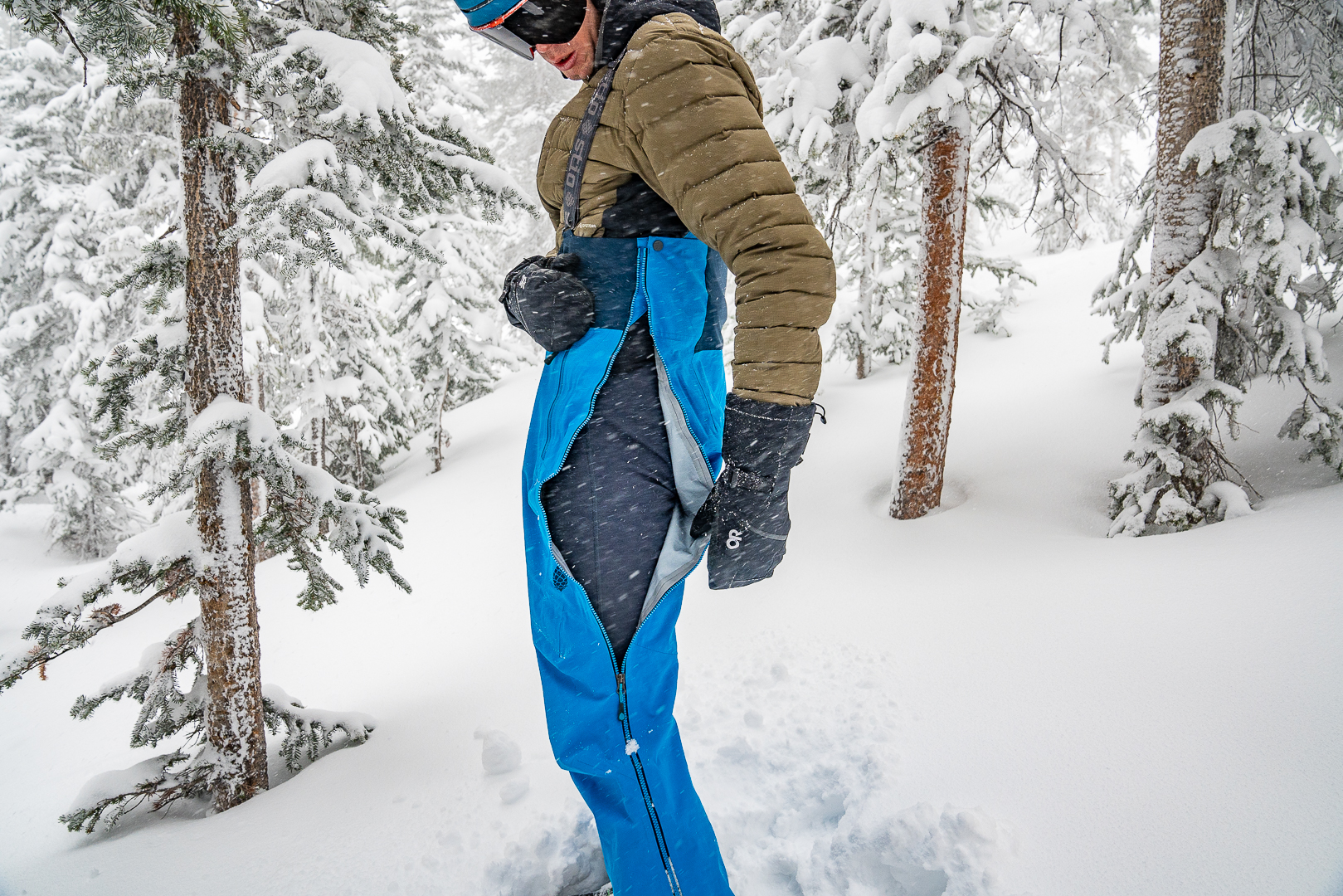
Chemical-Free Surface Treatments
An acronym that you now see everywhere is PFCs (perfluorinated chemicals). They’ve been used for decades in the outdoor industry to impart Durable Water Repellent (DWR) properties onto technical fabrics by coating the exterior surface. Furthermore, PFCs also exist in other steps in the manufacturing of textiles.
These components can generate health problems for humans and animals, plus they’re extremely toxic and persistent in nature. Most brands have switched to PFC-free water repellents that function as well as their chemical counterpart. The Flylow Gear Baker Bib is one of our favorites that has a PFC-free high-performance DWR coat.
In 2023-2024, Patagonia became the first brand to produce winter apparel completely free of PFCs with the 3-layer GORE-TEX ePE membrane in the Patagonia Men’s Untracked Bibs. The design eliminated long-lasting perfluorinated chemicals from the fabric, membrane, and topical treatments.

OEKO-Tex Standard
Our highlighted Jones Men’s MTN Surf Recycled Bibs and Jones Shralpinist Recycled GORE-TEX ePE Bibs are certified to the OEKO-TEX Standard. Every component of the garment — thread, buttons, and other accessories — has been tested for harmful substances and supports human health.
Bluesign Certified
The TREW Gear TREWth Primo Bib, REI Co-op First Chair GTX Bibs, and Flylow Gear Baker Bib are Bluesign certified. This means that chemicals of concern are kept out of the creation process, and the material impact is low or eliminated, all benefitting the health and safety of the environment, workers, and wearers.
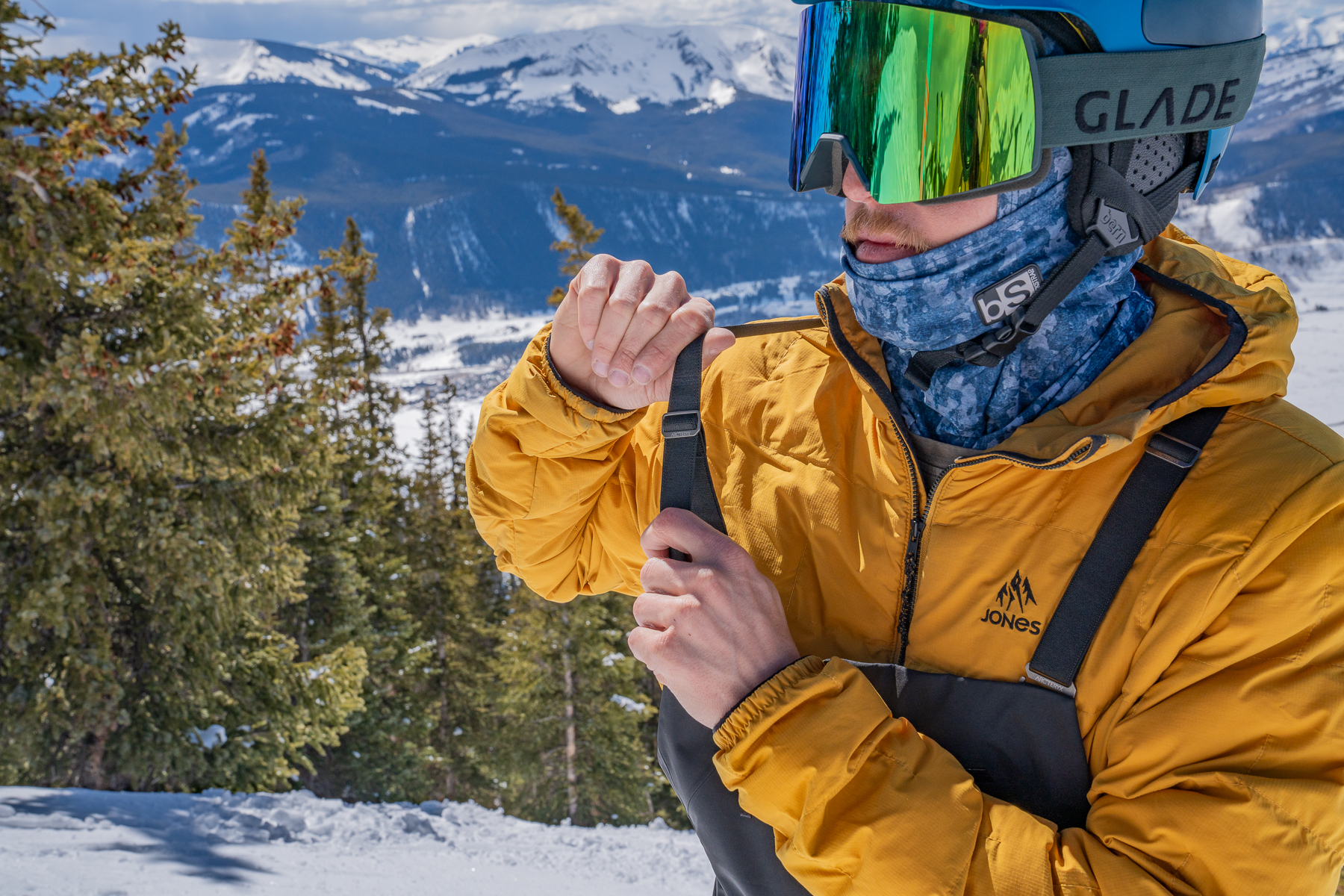
Fair Trade Certified
In another column, the Patagonia Men’s Untracked Bibs, REI Co-op First Chair GTX Bibs, and Patagonia Men’s SnowDrifter Bibs are Fair Trade certified. For that reason, the outer layers’ materials have all met rigorous social, environmental, and economic standards, including safe working conditions and environmental protection.
Carbon Neutral
Albeit uncommon, REI is Climate Neutral Certified, so we give a nod to the REI Co-op First Chair GTX Bibs. The organization measures its annual carbon emissions and purchases an equivalent amount of verified carbon credits to offset those emissions.
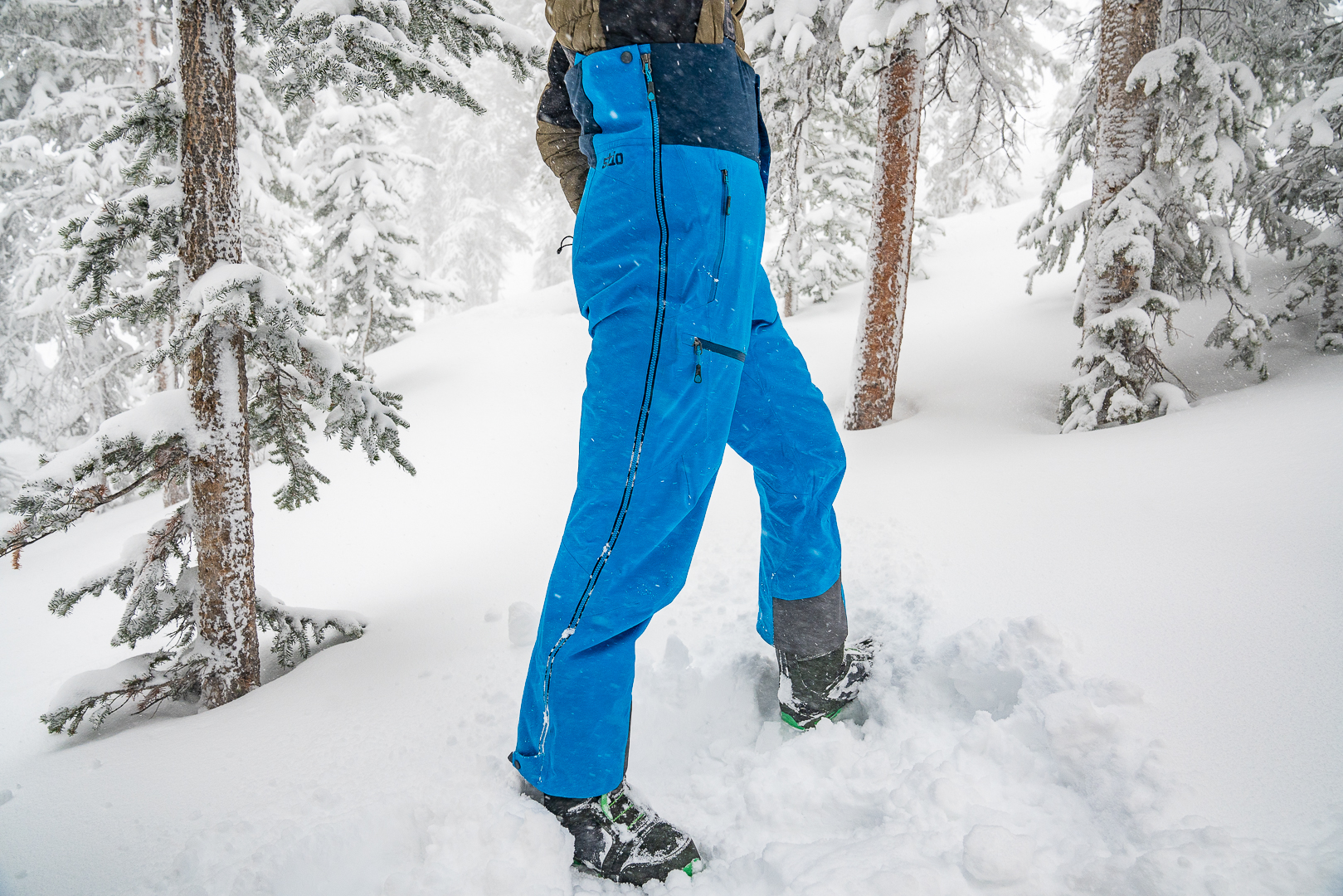
Price & Value
Ski bibs for men range from $220 on the low end — with minimal pockets, low torso coverage, and average durability — to $700 on the high end. Premium designs with a flannel backer and RECCO are ultra-durable, lightweight, and breathable.
Budget
Our budget pick for this guide is The North Face Freedom Bibs ($220). Boy, howdy, do they stack up for the price? Not far off is the REI Co-op First Chair GTX Bibs ($269). The biggest differentiator for economic options is that they’re typically 2-layer designs versus a stronger, more weather-resilient 3-layer build.
Both designs lack detachable suspenders, a stretchier fabric, and the Freedom Bibs leaves out a drop seat. The First Chair only has two pockets, and only one has a secure zipper.
These budget bibs are still stylish, functional, and can deliver weather protection for in-bounds shredders.
Mid-Tier
Most of our favorite men’s snow bibs fall between $300 and $480. Options like the Flylow Baker Bib ($430) and Stio Men’s Figment Bib ($479) offer excellent waterproofness, windproofness, durability, style, and cargo space.
Lest, these bibs might not be the lightest-weight or most breathable textiles, but they’re articulated, comfortable, adjustable, and have vents to dump heat.
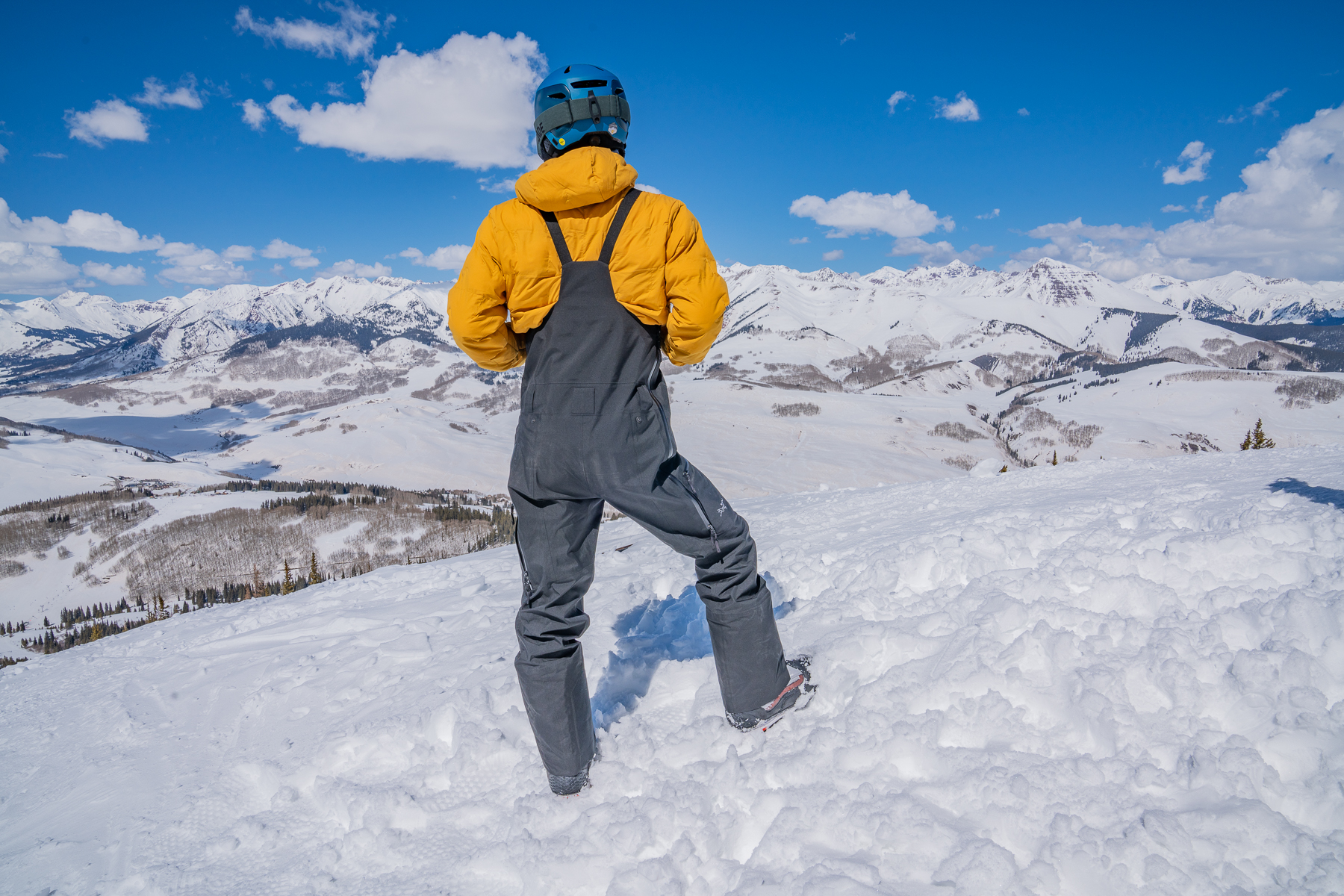
Premium
On the high-end level, the most expensive ski bibs are the most ergonomic and technical when dealing with the elements. These sit around the $500-$600 range. They are built for heavy use and backcountry goers with high-end fabrics that are lighter, more breathable, and super durable. If you count grams, these bibs are worth the extra pennies.
The Patagonia Untracked Bib ($649) and Outdoor Research Hemispheres II Bib ($649) fall in this zone. Upper-tier bibs often have RECCO, multiple reinforcements surrounding the cuffs, belt loops, easily adjustable suspenders, and a spacious drop seat. This price tier is the one if you’re looking for a top-notch backcountry tool, and the lightest, most durable fabric.

Frequently Asked Questions
Ski bibs are like high-waisted ski pants suspended by straps over the shoulders. They resemble a pair of denim overalls, but ski bibs are made of multilayered water-resistant materials like nylon blends.
For one thing, bibs are a great bet if you plan on spending a lot of time riding in deep powder. The extra-high waist keeps snow and moisture out, and the suspenders prevent them from sliding down or bunching up. Bibs generally offer more pockets for carrying essentials.
Ski pants have benefits, too. Layering can be simpler in ski pants, and pulling them on and off can be easier and quicker.

The fit of a bib is a matter of personal preference and style. The bottom hem should reach or cover your ankles without touching the ground. But you don’t want the torso to be tight or short when you bend over.
Manufacturers usually categorize snow bibs as slim or athletic, regular, and freeride or baggy. And some brands, like REI Co-op and TREW, offer extended sizes in short and tall lengths, XS and XL, and a plus-size run.
For many backcountry skiers, bibs are the preferred choice. Markedly, we appreciate that the high waistline provides an excellent snow and moisture barrier when you’re floating through the good stuff or take a tumble.
Plus, many bibs have built-in flaps to simplify the bathroom process. The drop seat is opened via one or two side zippers or a clamshell zipper around the hips. So, the fabric folds to the side before you squat.
Bibs have a few downsides. First, they can be warm while hiking uphill. Be sure to find a design with breathable material and leg vents. Also, using the bathroom in the backcountry while wearing bibs can be tricky.
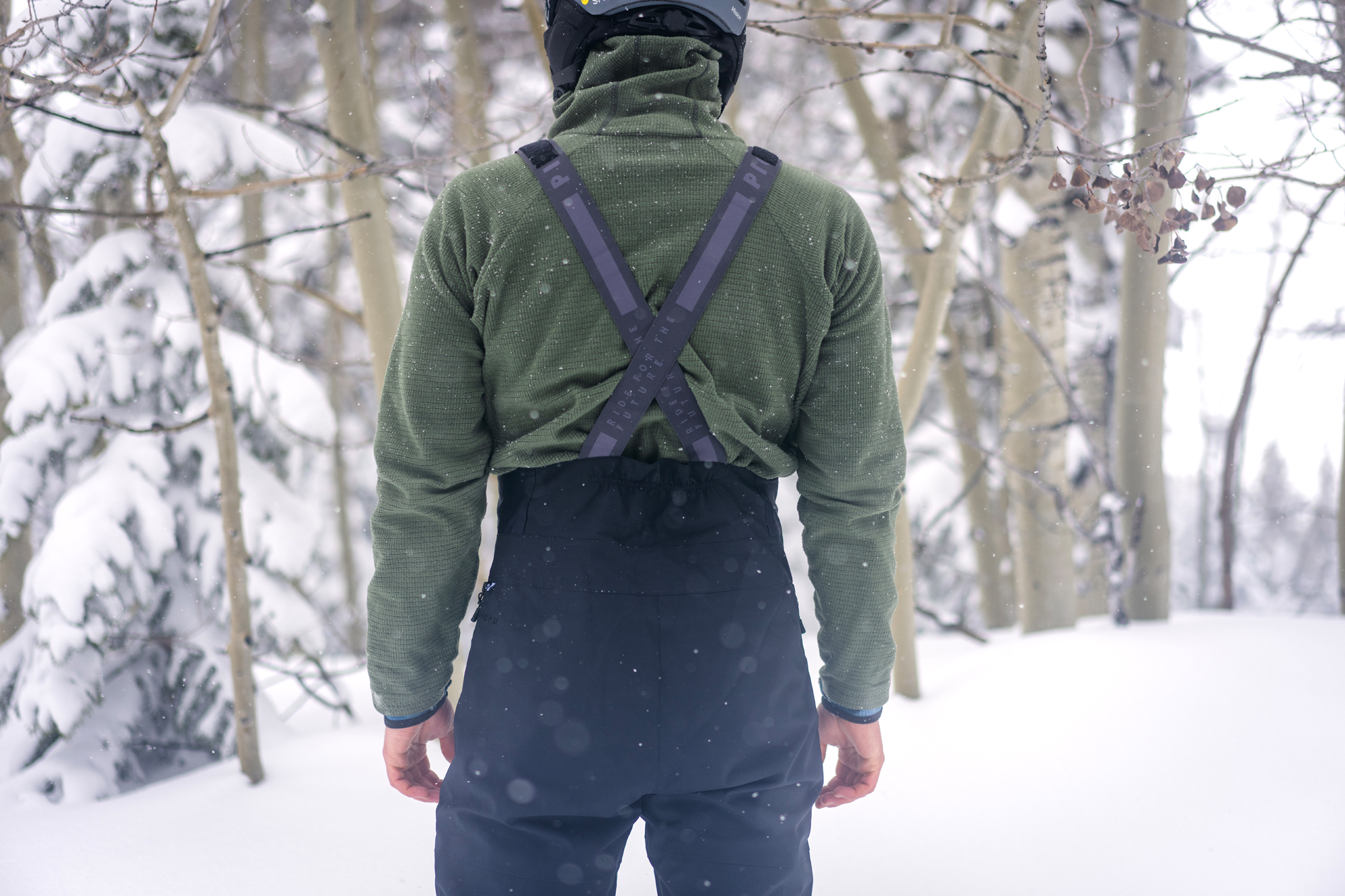
Ski bibs work well for skiing, snowboarding, snowshoeing, and snowmobiling. The biggest difference between these sports is the boots. By and large, the necks of snowboard boots are generally wider than ski boots, and they don’t always fit smoothly into narrowly designed leg hems.
Most snow bibs have a traditional front fly zipper for number one.
These days, most snow bib manufacturers design products that let you use the bathroom for number two without taking off the bib. A drop seat — a specialized zipper that enables the fabric on your backside to fall away while the shoulder straps stay in place — makes bathroom breaks possible.
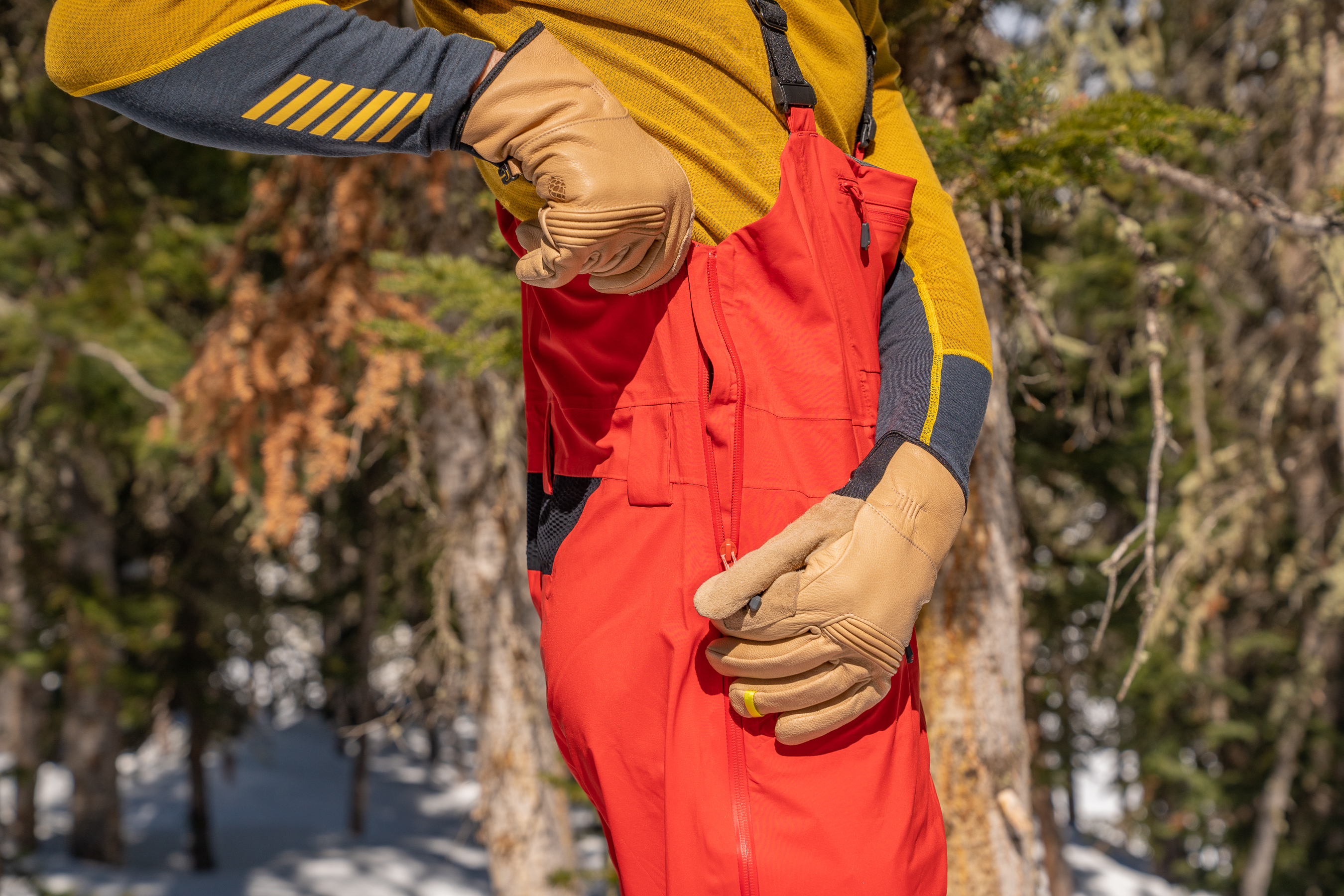
Most of our favorite men’s ski bibs lack built-in insulation. Accordingly, depending on the weather — including the temps, wind, and precipitation — you’ll tailor your layer underneath the bib for the best warmth.
On cold, below-freezing days, we recommend wearing a heavier-weight wool or wool-hybrid base layer. You could also wear a lightweight or midweight base layer plus a midlayer underneath the snow bib, like puffy pants. Ensure you position your upper body’s base layer and midlayer underneath the shoulder straps and fabric of the bibs.
In the backcountry, you can wear your avalanche transceiver with a chest harness, which is the recommended form of carry, against your base layer. Be aware of other electronics. Generally, the Utah Avalanche Center directs that your beacon be 20 cm (8 inches) away from other electronics while transmitting and 50 cm (20 inches) away from electronics when it’s in search mode.
Some riders wear underwear beneath their bibs (sans base layer) on hot spring days.
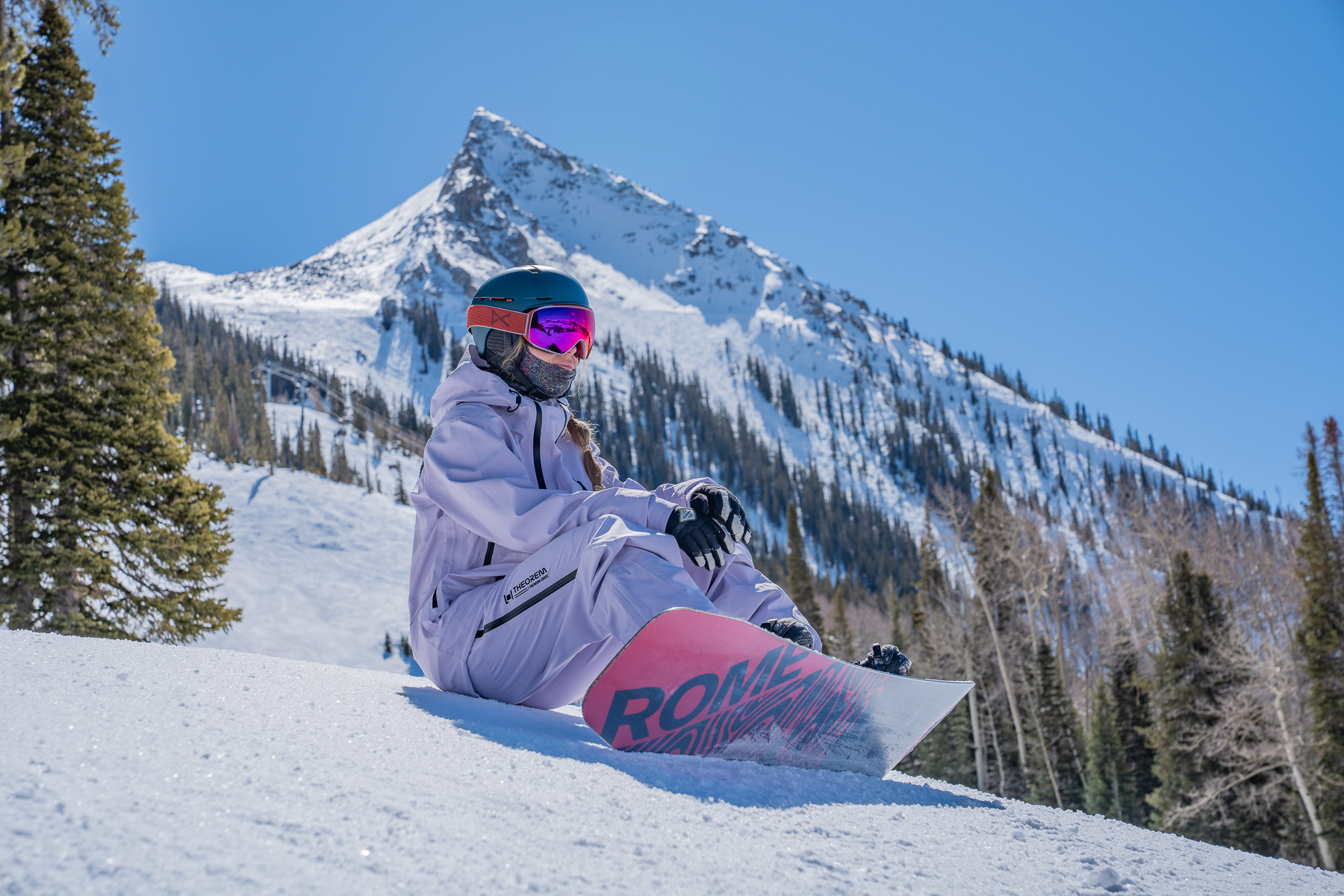
The Best Snowboard Jackets of 2025-2026
From the ski resort to the backcountry, we tested and found the best snowboard jackets for all conditions and budgets.
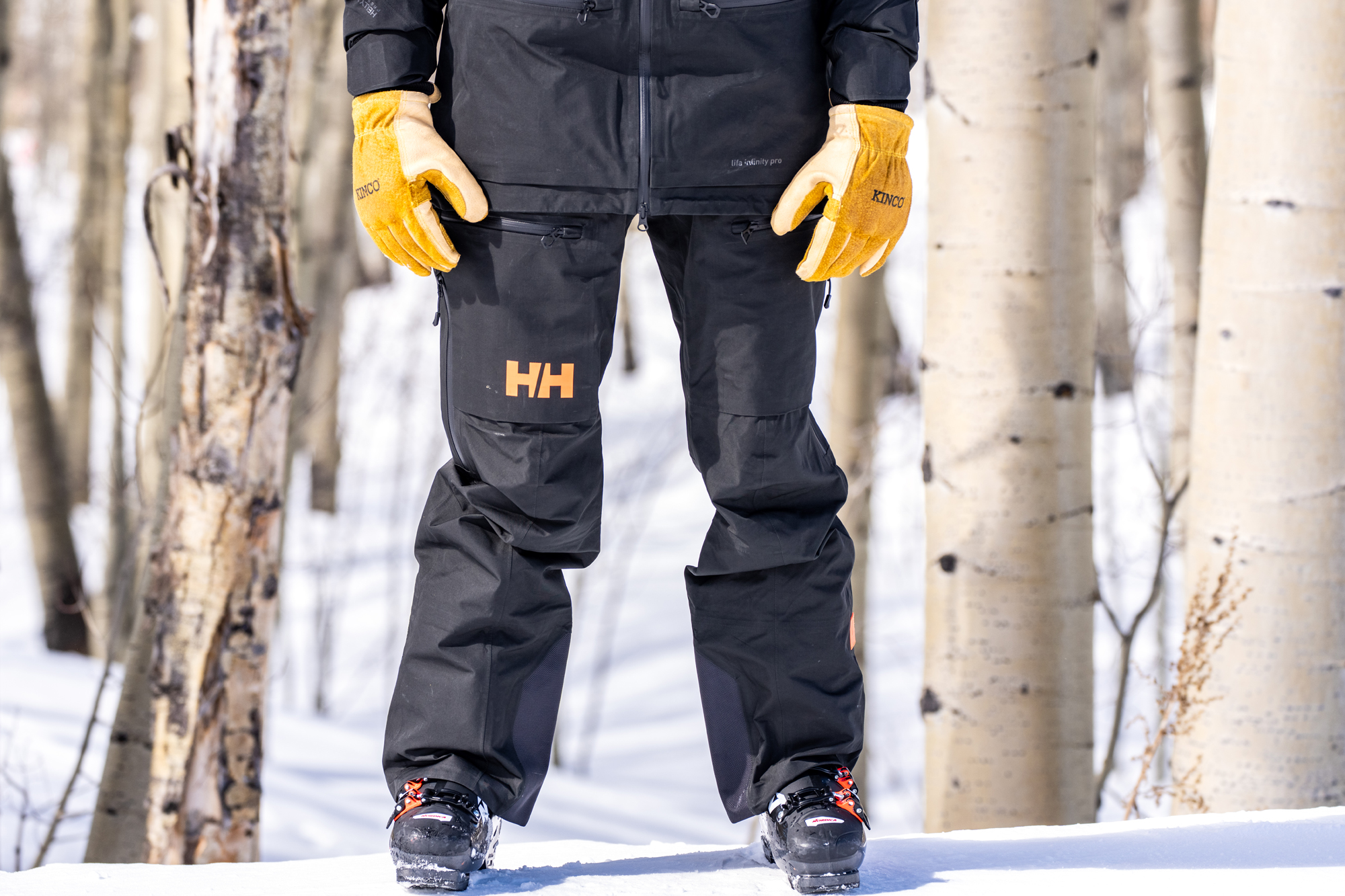
The Best Ski Pants of 2025-2026
For the resort or backcountry, we found the best ski pants for a range of conditions including Flylow, Patagonia, Rab, and more.
